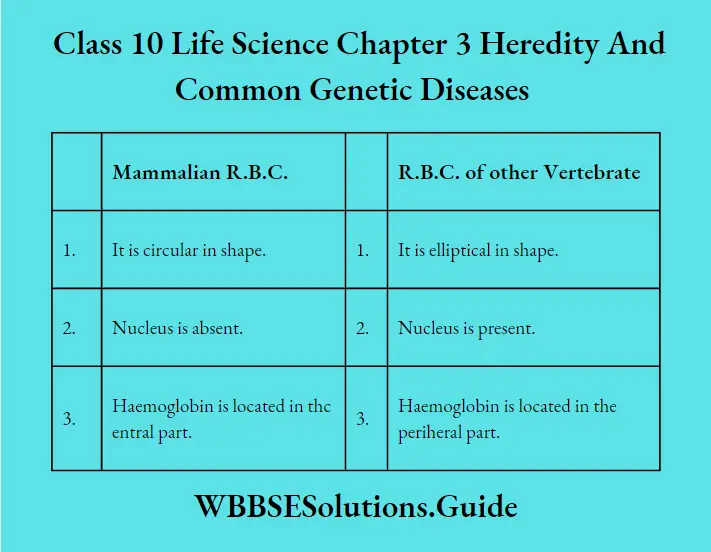Chapter 3 Heredity And Common Genetic Diseases Short Answer Questions
Question 1. What is Photosynthesis?
Answer:
Photosynthesis:
The anabolic reaction that occurs between carbon dioxide gas and water in the presence of sunlight and chlorophyll to produce glucose is known as photosynthesis.
Equation :- 6CO2 + 12H2O → C6H12O6 + 6H2 mknO + 6O2
Question 2. What are the raw materials necessary for the process of photosynthesis?
Answer:
(1) Carbon dioxide gas (CO2) and
(2) Water (H2O) is the raw material necessary for the process of photosynthesis.
Question 3. Where is mesophyll tissue located? What is its function?
Answer:
(1) Between the upper and lower epidermis of the leaf.
(2) It helps in photosynthesis.
“WBBSE Class 10 Life Science Chapter 3 short answer questions, Heredity and Common Genetic Diseases”
Question 4. What do you understand by carbon assimilation?
Answer:
carbon assimilation
The reduction of carbon dioxide gas to produce glucose during the dark reaction of photosynthesis is called carbon assimilation.
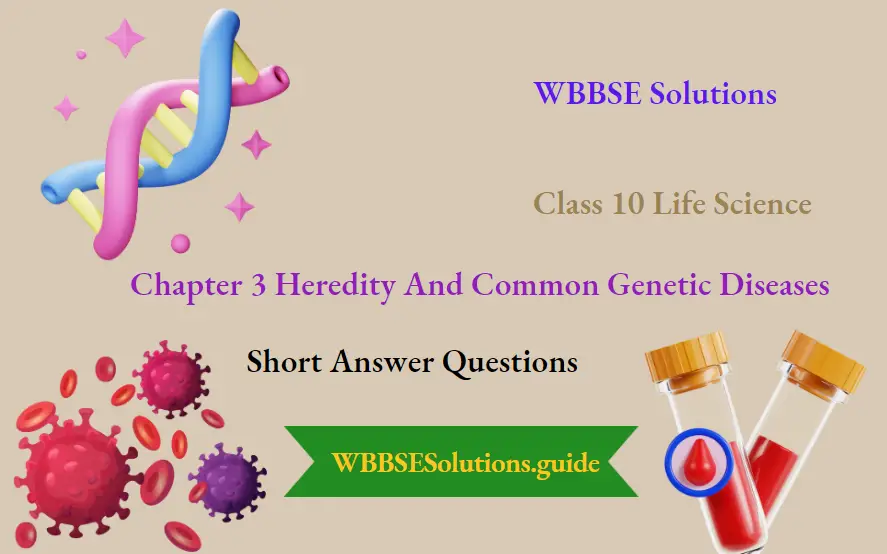
Question 5. What are the components of the environment necessary for photosynthesis? Where do the plants collect all these components?
Answer:
(1) CO2 – Air, Water
(2) H2O -Soil
(3) Light – Sun
(4) Chlorophyll – grana of Chloroplast.
Question 6. What is meant by “entrapping of solar energy” in the case of green plants?
Answer: The process by which chlorophyll molecules absorb solar energy and help to convert this energy into chemical energy is called “entrapping of solar energy”.
Question 7. Write the names of two animals that can carry out photosynthesis and the names of two plants unable to do photosynthesis.
Answer:
Name of animals —
(1) Euglena ;
(2) Chrysamoeba.
Name of plants —
(1) Agaricus;
(2) Mucor.
Question 8. In green plants which one process between photosynthesis and respiration does not occur during night and why?
Answer:
(1) Photosynthesis.
(2) Because sunlight is not available during the night.
Question 9. What is photolysis?
Answer:
Photolysis
When sunlight falls on the surface of the green leaves of plants, some part is absorbed by chlorophyll molecules, and the remaining part is reflected from the surface to the environment. The chlorophyll molecules are changed into activated chlorophyll after absorption of light.
Activated chlorophyll splits water molecules into H+ion and OH” ion. OH– ion loses one electron and is converted into OH radical. This OH radical is changed into water and oxygen gas. Water again takes part in metabolic reaction and oxygen comes out to the environment through stomata.
“West Bengal Board Class 10 Life Science Chapter 3 solutions, short answers, with explanations”
H+ ion gains one lose electron of OH– ion and changes into a neutral hydrogen atom. It combines with NADP (Nicotinamide Adenine Dinucleotide Phosphate) and reduces it into NADPH2. At the end of this reaction, the activated chlorophyll molecule resumes its original state.
Read and Learn more about WBBSE Solutions for Class 10 Life Science And Environment
Question 10. What is the role of carbon dioxide in photosynthesis?
Answer:
Role of carbon dioxide in the process of
photosynthesis:—
Carbon dioxide is a raw material for photosynthesis. In the dark phase of photosynthesis, it is reduced to glucose. Thus both elements—carbon and oxygen-are involved in the formation of glucose.
Question 11. What is photophosphorylation?
Answer:
Photophosphorylation
The formation of ATP molecules with the help of ADP molecules during the light phase of photosynthesis is called photophosphorylation.
Question 12. Explain the role of water in photosynthesis.
Answer:
Role of water in the process of photosynthesis:—
Water is a raw material of CO2. Thus it takes part in glucose formation. The oxygen of water is changed into the free form of oxygen gas which comes out through stomata.
Question 13. State the role of sunlight in photosynthesis.
Answer:
Role of sunlight in photosynthesis:—
influences the rate of photosynthesisThe intensity, quality, and duration of light influence the rate of photosynthesis. Photolysis of water occurs in the presence of light. Too much high-intensity light may even stop the process of photosynthesis. The inhibition of photosynthesis due to high-intensity light which slows down its rate is called solarization. The rate of photosynthesis is directly related to the duration of light.
Question 14, How is the O2 — CO2 balance in the environment dependent on the green plants?
Answer:
Importance of photosynthesis in maintaining the balance of CO2 and O2 in the environment:—
The percentage of CO2 and O2 gas in (air and water) is maintained by photosynthesis. Autotrophs take in CO2 gas from their environment for the process of photosynthesis. They liberate O2 gas during this process. All living organisms take in O2 gas and give out CO2 gas during respiration. Thus photosynthesis and respiration in a combined effect maintain the balance of CO2 andO2 in the environment.
Question 15. Point out the relevant difference between assimilatory starch and storage starch.
Answer:
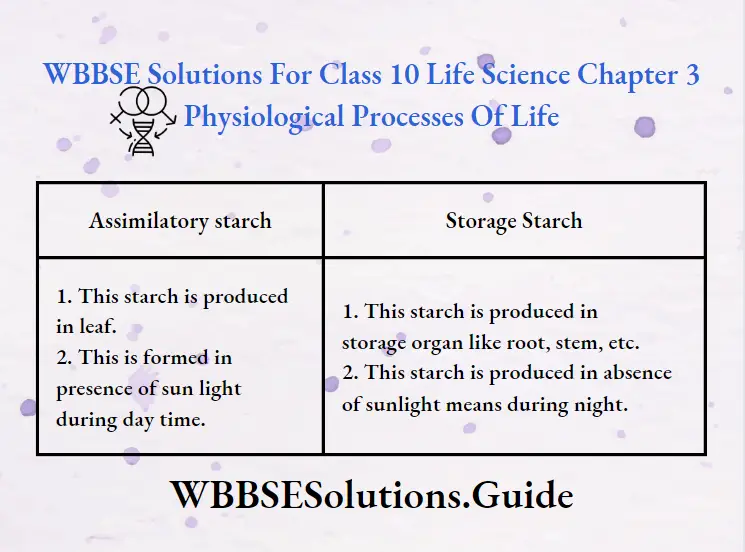
Question 16. What are the roles of chlorophyll and sunlight during photosynthesis?
Answer:
(1) Role of chlorophyll in photosynthesis:—
Chlorophyll is a magnesium-containing green pigment present in the chloroplast of green plants. The chlorophyll pigment first absorbs the incoming solar radiation. It results in the activation of the chlorophyll. Activated chlorophyll causes the dissociation of water. Hence chlorophyll helps in the photolysis of water.
(2) Role of sunlight in photosynthesis:—
The intensity, quality, and duration of light influence the rate of photosynthesis. Photolysis of water occurs in the presence of light. Too much high-intensity light may even stop the process of photosynthesis. The inhibition of photosynthesis due to high-intensity light which slows down its rate is called solarization. The rate of photosynthesis is directly related to the duration of light.
Question 17. Discuss any two significances of photosynthesis.
Answer:
(1) Solar energy is entrapped and converted into chemical energy by this process. This chemical energy is stored within food (ex. glucose). This food is the source of energy for all living Autotrophs and Heterotrophs.
(2) CO2 and O2 balance is maintained by this process with the association of respiration.
Question 18. Photosynthesis is a process of energy transformation.
Answer: The conversion of one form of energy to the other form of energy is called the transformation of energy. Solar energy is converted into chemical energy during the process of photosynthesis. Therefore photosynthesis is called a process of energy transformation.
Question 19. Photosynthesis is called an anabolic process.
Answer: The cellular reaction that forms complex substances from simple substances is called anabolic process. During photosynthesis complex substance glucose is formed from the simple substances carbon dioxide and water. Energy is entrapped and the dry weight of the plant is increased.
Question 20. Why is photosynthesis called carbon assimilation?
Answer: The transformation of a simple substance into a complex substance is called assimilation. The simple substance CO2 is converted into complex substance glucose during the process of photosynthesis. Hence, photosynthesis is called carbon assimilation.
Question 21. Why is photosynthesis termed an oxidation-reduction reaction?
Answer: Water and carbon dioxide are reactants. During photolysis, H2O is oxidized by activated chlorophyll and as a result of this, free oxygen gas is evolved. In the dark phase, CO2 gas is reduced by ATP and NADPH2 to produce glucose molecules.
Question 22. Why is photosynthesis called an endergonic process?
Answer: The metabolic reaction in which energy is stored, is called the endergonic process. During photosynthesis, solar energy is transformed into chemical energy and this energy is stored within glucose molecules.
Question 23. Why is assimilatory starch formed?
Answer: Glucose is produced by Photosynthesis. It is soluble in water. The concentration of water becomes high. It hampers the process of photosynthesis. To continue the process of photosynthesis glucose is converted into assimilatory starch during the day.
Question 24. Why photosynthesis and respiration are called opposite processes?
Answer:
Photosynthesis and respiration are two opposite processes:
(1) Photosynthesis is an anabolic or constructive process in which carbon dioxide and water are used by the chlorophyll-containing plant to produce glucose. Whereas respiration is a catabolic or destructive process in which glucose is broken down into carbon dioxide and water.
(2) Photosynthesis occurs in the presence of the sunlight. Light is not necessary for respiration.
(3) Photosynthesis is an energy-consuming process and the energy is stored as potential energy in glucose molecules. Respiration is. an energy-releasing process in which the stored potential energy of a glucose molecule is released as kinetic energy.
Question 25. Which type of metabolic process is photosynthesis and why?
Answer:
Photosynthesis is an anabolic type of metabolic process.
Because:-
(1) Solar energy is entrapped and converted into potential chemical energy.
(2) A complex substance glucose is formed from simple substances CO2 and H2O.
(3) The dry weight of the plant increases during this process.
Question 26. What is the relation between photosynthesis and energy cycle?
Answer:
Photosynthesis:-
The process by which green plants manufacture their food utilizing CO2, and H2O as raw materials with the help of sunlight and chlorophyll, is known as photosynthesis.
Energy Cycle:-
According to the law of conservation of energy, “Energy cannot be created nor destroyed, but transformed from one form to another.” This principle says that energy is continuously cycled in nature in different forms.
Relation between photosynthesis and energy cycle:-
The plants absorb about one percent of the sunlight falling on them. The sunlight contains solar energy. The incoming solar energy is absorbed by chlorophyll molecules. Then, by the process of photosynthesis, this solar energy is converted into usable chemical energy which is stored in the food molecule. Thus photosynthesis is involved. in the conversion of solar energy into chemical energy.
Question 27. What is the relation observed between photosynthesis and respiration occurring in green plants during the daytime?
Answer: The process of photosynthesis occurs in chloroplast. It requires CO2 and H2O. Glucose, oxygen, and water are produced as products of this reaction.
Respiration occurs in the cytoplasm and mitochondria of the same cell. It requires glucose and oxygen. Carbon dioxide, water, and energy are produced during respiration.
Relation:-
The process of photosynthesis and respiration occur in green plants during the daytime by helping each other. Because the end products of photosynthesis are the raw materials of respiration and the end products of respiration are the raw materials for photosynthesis. Hence both processes are interrelated.
Question 28. Define respiration.
Answer:
Respiration
The catabolic reaction that occurs continuously within all living cells to oxidize food substances and to change the potential chemical energy of food into kinetic energy is called respiration.
Equation :- C6H12O6 + 6O2→ 6CO2 + 6H2O + 686 K. Cal Energy
Question 29. Name any two respiratory organs of animals.
Answer:
(1) Man:—Lungs
(2) Fish:— Gills.
Question 30. Where are mitochondria located? What is its function?
Answer:
(1) Mitochondria is located in the cytoplasm of a living cell.
(2) It is the site of Kreb’s cycle. ATP is also stored within it.
Question 31. Name the two major phases of aerobic respiration.
Answer:
(1) Glycolysis or E.M.P. pathway.
(2) Kreb’s Cycle.
Question 32. Mention three main types of respiratory organs in animals.
Answer:
(1) Lungs:— Man.
(2) Trachea:— Cockroach
(3) Gills:— Fish.
Question 33. Name one respiratory organ of an animal suitable for performing respiration in an aquatic environment. In which organism does it occur?
Answer:
(1) Gills.
(2) Fish.
Question 34. What is aerobic respiration?
Answer: The process of respiration in which complete oxidation of food takes place in the presence of free oxygen is called aerobic respiration.
Equation:- C6H12O6 + 6O2 ——> 6CO2 + 6H2O + 686 K cal Energy.
Question 35. Name the chief respiratory organs of Amoeba, Cockroaches, Tadpole, and Bird.
Answer:
(1) Amoeba :— Plasma membrane
(2) Cockroach:— Trachea
(3) Tadpole:— Gills
(4) Bird:— Lungs with air sacs.
Question 36. What is an accessory respiratory organ? Cite two examples of animals where it is found.
Answer:
(1) The organs that are attached to the main respiratory organ and help the organism to take oxygen from another environment, are called accessory respiratory organs:
(2) (a) Magur (b) Koi.
Question 37. What is fermentation?
Answer: The partial anaerobic oxidation of organic compounds (Glucose) which occurs due to enzymatic action within the cytoplasm of microorganisms to produce different types of organic substances, i.e., Alcohol, lactic acid, etc. is called fermentation.
Question 38. What is Glycolysis?
Answer: The process of conversion of glucose into pyruvic acid within the cytoplasm of the cell in the presence of glycolytic enzymes is called Glycolysis.
Question 39. What is alcoholic fermentation?
Answer: The decomposition of organic substances in the presence or absence of oxygen but in the presence of microorganisms and one product is “Alcohol” called alcoholic fermentation.
Equation :- C6H12O6 + Zymase Yeast, 2C2H5OH + 2CO2 + 50Kcal
Question 40. What is the respiratory substance of the cell?
Answer: The organic compounds that are oxidized within living cells during respiration are called respiratory substances. Ex. Glucose, Amino acid, Fatty acid.
Question 41. What is a citric acid cycle? Why is it called so?
Answer: The process of formation of a group of eight Tricarboxylic organic acids within mitochondria is called the citric acid cycle.
Reason :
Citric acid is the first organic—acid formed within mitochondria. Hence the cycle is called the citric acid cycle.
Question 42. What is meant by — ‘Release of energy takes place in respiration’?
Answer: Potential chemical energy is stored within respiratory substances like glucose, amino acids, and fatty acids. The process of respiration converts this potential chemical energy into kinetic energy. Living organisms use this form of energy to perform their various vital function. The conversion of potential chemical energy of respiratory substances into a usable form of energy is the meaning of release of energy.
Question 43. Where and when does respiration occur?
Answer:
(1) Respiration occurs in the cytoplasm and Mitochondria of a living cell.
(2) It occurs day and night continuously.
Question 44. Name the respiratory organ of spider and tadpole larva.
Answer:
Spider — Book lung
Tadpole — External gill
Question 45. Rohu and Katla fishes are dead while on sale, but Indian Koi and Magur fishes still keep alive. How?
Answer: Because in Indian Koi and Magur fishes accessory respiratory organs, labyrinthi form and arborescent respectively are attached to the main respiratory organ, gills. These accessory respiratory organs can absorb oxygen gas in the air.
Question 46. While preparing curd, a little curd mixed with the milk helps to prepare the curd quickly. How?
Answer: The bacteria present in curd increase the rate of fermentation. So, the process of curd formation takes place quickly.
Question 47. Explain in brief why pouring oil on the sewage water kills the larvae of the mosquito.
Answer: Oil acts as a disinfectant and kills the larvae of the mosquito. It also covers the water’s surface. Due to this oxygen gas does not mix with water, In the absence of oxygen larvae can not perform the process of respiration. Hence, they die.
Question 48. Why are accessory respiratory organs necessary for some fishes?
Answer: Accessory respiratory organs are present in those fishes that live in muddy water. The percentage of oxygen is less due to the presence of mud in this water. To fulfill the requirement of oxygen accessory respiratory organs are originated.
Question 49. Why is the human lung provided with alveoli?
Answer: It increases the surface area for the exchange of gases like O2 and CO2. Another fact is that these are covered with blood capillaries through which the exchange of gases is possible.
Question 50. Why is aerobic respiration known as oxidative phosphorylation?
Answer: The complete oxidation of food in the presence of oxygen within living cells is called aerobic respiration. The formation of ATP mainly occurs within mitochondria in the presence of oxygen. Hence aerobic respiration is known as oxidative phosphorylation.
Question 51. Why is respiration considered as catabolism?
Answer: The cellular chemical reaction in which simple substances are formed from the breaking of complex substances is called catabolism. During respiration, simple substances like H, O, and CO, are formed from the complex substance glucose. Energy is released and the dry weight of living organisms is decreased.
Question 52. Why. is breathing rate faster in aquatic animals as compared to terrestrial animals.
Answer: Aquatic animals do more work in comparison to terrestrial animals. Hence they require more energy. To obtain more energy their breathing rate is higher. They also get less amount of oxygen from water.
Question 53. How is respiration related to nutrition?
Answer: The oxidative breakdown of substances in living cells to release energy is called respiration.
The total of processes like ingestion, digestion, absorption, assimilation, and egestion is called nutrition.
Relation:-
The process of nutrition supplies the raw materials such as glucose, amino
“acids, and fatty acids for respiration, and respiration produces energy which is necessary for nutrition. Thus both processes are complementary to each other.
Question 54. “The calorific value of the protein is 4.1-kilo calorie/gm”. Explain.
Answer: When one gram protein (Amino acid) is oxidized within the cell during respiration 4.1 kilo calorie energy is released.
Question 55. What is nutrition?
Answer: Nutrition is a combination of processes (like ingestion, digestion, absorption, assimilation, and egestion) by which living organisms receive and utilize nutrients for the maintenance of their functions and growth.
Question 56. What are the different phases of animal nutrition?
Answer:
(1) Ingestion
(2) Digestion
(3) Absorption
(4) Assimilation
(5) Egestion.
Question 57. Name any two plants of which one is autophytic and the other heterophytic.
Answer:
(1) Autophytic:- Mango, Neem.
(2) Heterophytic:—Cuscuta, Yeast.
Question 58. What are the names of the first phase and the last phase of animal nutrition?
Answer:
(1) First phase:— Ingestion.
(2) Last Phase:— Egestion
Question 59. What is food?
Answer: The nutrients which supply energy and help in the formation of body substances are called food.
Example:—
(1) Carbohydrates
(2) Proteins and
(3) Fats.
Question 60. Name two food components that do not supply energy.
Answer:
(1) Vitamins.
(2) Mineral salts.
Question 61. Name two plant sources and two animal sources of a fat type of food.
Answer:
(1) Plant:— Coconut oil and Palm oil
(2) Animal:— Butter and Ghee.
Question 62. What is heterophilic nutrition? Give example.
Answer:
(1) The mode of nutrition by which non-green plants obtain their food is called heterophytic nutrition.
(2) Example:— Agaricus.
Question 64. Define the term ‘Parasite’. Give an example of a parasitic animal.
Answer:
(1 The organisms who obtain their food from other living organisms (host) are called parasites.
(2) Entamoeba histolytica.
Question 65. Define Autotrophic nutrition.
Answer: The mode of nutrition to obtain their food utilized by green plants is called Autotrophic nutrition.
Example — Green Mango tree.
Question 66. Give one plant and one animal example of a partial parasite.
Answer:
(1) Plant partial parasite — Viscum album.
(2) Animal partial parasite — Mosquito.
Question 67. Name two parasitic plants.
Answer:
(1) Cuscuta
(2) Rafflesia.
Question 68. Mention the principal types of food. Cite one example of each type.
Answer:
(1) Carbohydrate:— Wheat, Milk.
(2) Protein:— Soyabean, Fish.
(3) Fat:— Coconut oil, Butter.
Question 69. Name one parasitic plant and its host.
Answer:
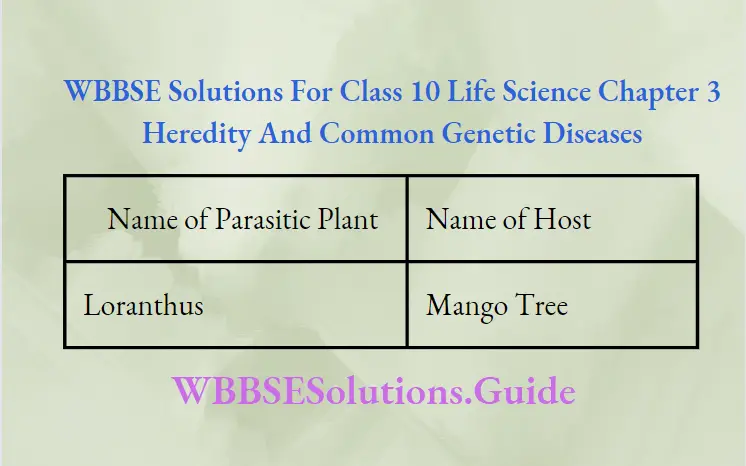
Question 70. Write two differences between parasites and symbionts.
Answer:
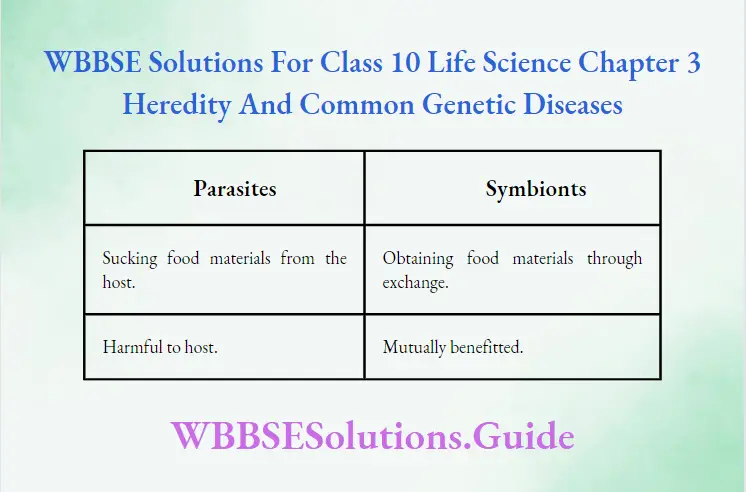
Question 71. Mention any two importance of the process of nutrition.
Answer:
(1) For a steady supply of energy:-
Food is the source of energy for living organisms. Simple soluble foods are supplied to the cells for the conversion of chemical energy into kinetic energy. These foods are the product of the process of nutrition.
(2) For Bodybuilding and growth:-
The process of nutrition supplies the material for body building and growth.
Question 72. Write two differences between saprophytic and symbiotic plants.
Answer:
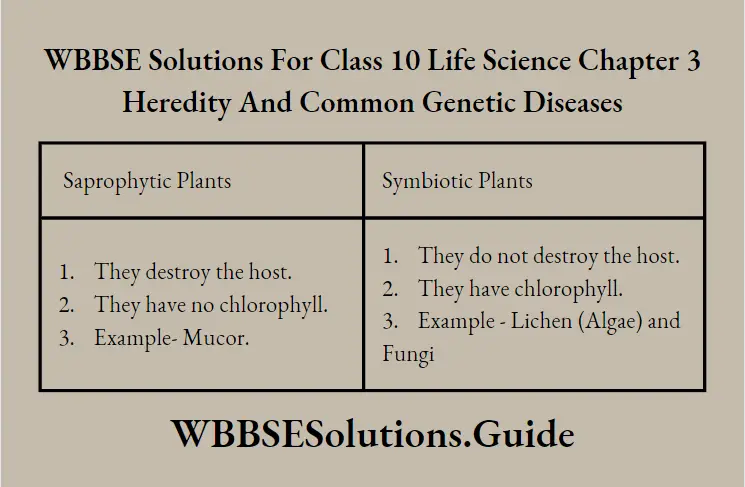
Question 73. Why does the doctor forbid spicy food for a hepatitis patient?
Answer: Hepatitis is a liver disease. A person suffering from this disease is unable to digest spicy food due to a lack of proper functioning of the liver.
Question 74. In which part of the alimentary canal, related to the digestion of food, no carbohydrate-splitting enzyme is secreted?
Answer: Stomach.
Question 75. What do you mean by the calorific value of food?
Answer: The energy obtained by the complete combustion of 1 gm of food is called its calorific value.
Question 76. What is an enzyme?
Answer: The nitrogenous organic compounds that are produced by living cells but without taking part in biochemical reactions, within or outside a cell, change the rate of chemical reaction, are called enzymes.
Question 77. Name the two substrates on which lipase and trypsin react respectively.
Answer:
(1) Lipase:- Fat.
(2) Trypsin:— Peptone.
Question 78. Name any two properties of the enzyme.
Answer:
(1) They do not take part in a biochemical reaction.
(2) They act only in a specific medium.
Question 79. Write two important characteristics of enzymes.
Answer:
(1) All enzymes are chemically protein in nature.
(2) Enzymes return to their original state after the completion of the reaction.
Question 80. From which part of the digestive system are protein-digesting enzymes
secreted?
Answer:
(1) Stomach
(2) Small intestine.
Question 81. Mention the names and functions of two enzymes.
Answer:
Question 82. Name the enzyme present in saliva. On what type of food does it act?
Answer:
(1) Ptyalin / salivary amylase
(2) Carbohydrate (Starch)
Question 83. Write the name of a proteolytic enzyme and mention its function.
Answer:
(1) Pepsin.
(2) Function:- It acts on protein and converts it into peptone.
Question 84. What is pepsin? State its source and function.
Answer:
(1) Pepsin:- It is an example of a proteolytic enzyme.
(2) Source:- Gastric Juice of the gastric gland.
(3) Function:- It acts on protein and changes it into peptone.
Question 85. The enzyme ptyalin helps to digest which type of food? From where is it secreted?
Answer:
(1) Enzyme ptyalin helps to digest carbohydrate type of food.
(2) Ptyalin is secreted by salivary gland.
Question 86. Name any two amylolytic enzymes.
Answer:
(1) Amylase
(2) Maltase.
Question 87. What do you understand by digestion?
Answer: The breaking of complex, insoluble, and non-absorbable forms of food into simple, soluble, and absorbable forms with the help of enzymes is called digestion.
Question 88. What are the end products of digestion of proteins, carbohydrates, and fats in the case of man?
Answer:
(1) Proteins:— Amino acid.
(2) Carbohydrates:— Glucose, Fructose and Galactose.
(3) Fats:— Fatty acid and glycerol.
Question 89. State the function of gastric HCI.
Answer:
(1) It changes the medium of food in the stomach.
(2) It kills harmful germs.
(3) It activates pepsinogen to convert into pepsin.
Question 90. What is a Lacteal?
Answer: The blood vessels which is present within the villus and help in the absorption of fatty acid are called lacteal.
Question 91. What is peristalsis?
Answer: The movement of involuntary muscles of the alimentary canal which helps in the transfer of food in the forward direction is called peristalsis.
Question 92. Name one digestive juice devoid of enzymes. Name the food on which it acts regarding digestion.
Answer:
(1) Name of juice:— Bile
(2) Name of food:— Fat
Question 93. Name the bile salts.
Answer:
(1) Sodium taurocholate
(2) Sodium glycolate.
Question 94. Name the salivary glands of humans.
Answer:
(1) Parotid (below ear)
(2) Sub Maxillary (under lower gland)
(3) Sublingual (below tongue).
“Class 10 WBBSE Life Science Chapter 3 short answer questions, solved answers, exam preparation”
Question 95. Define assimilation and egestion.
Answer:
(1) Assimilation:-
The process by which the absorbed food substances are converted into protoplasm is called assimilation.
(2) Egestion:-
The process by which the animal body gets rid of the unabsorbed residue of food materials from the rectum through the anus is called egestion.
Question 96. What will happen when salivary glands are removed from the human body?
Answer: In the absence of salivary. glands saliva will not be formed in the mouth cavity. Carbohydrate digestion will not take place in the absence of the enzyme ptyalin which is a constituent of saliva. Some bacteria will not be destroyed in the absence of lysozyme.
Question 97. What type of food can be digested in the buccal cavity? Name any one of the glands which help in its digestion.
Answer:
(1) Carbohydrates type of food can be digested in the buccal cavity.
(2) The name of one gland that helps in carbohydrate digestion is the salivary gland (Ea. parotid)
Question 98. State one structural and one functional difference between villi and alveoli.
Answer:
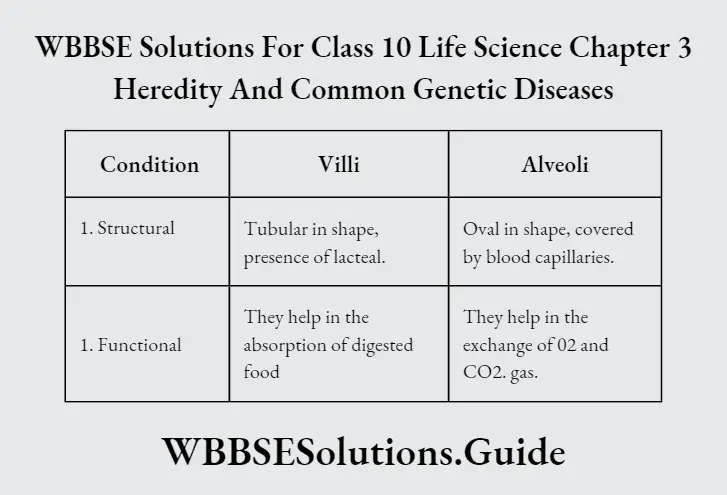
Question 99. Explain the role of the liver in Digestion.
Answer: The liver cells produce bile. This is stored in the gall bladder. Bile reaches the duodenum through the bile duct. Enzymes are absent in bile. Despite this fact, bile takes part in digestion. First of all, it changes the medium of chyme which comes from the stomach to the duodenum. The salts present in bile emulsify fats into microscopic fat droplets.
Question 100. What is a vitamin?
Answer: The organic compounds which are mainly produced by plant cells but a small quantity of these substances are essential for the proper regulation of our metabolic reactions, are called vitamins.
Question 101. Name four fat-soluble vitamins.
Answer:
(1) Vitamin A
(2) Vitamin D
(3) Vitamin E
(4) Vitamin K
Question 102. What type of vitamins are thiamine and phylloquinone?
Answer:
(1) Thiamine:— Water soluble.
(2) Phylloquinone :— Fat soluble.
Question 103. What is the source of vitamin A? What type of disease occurs in its absence?
Answer:
(1) Source:- Green Vegetables.
(2) Disease:- Night Blindness.
Question 104. Name the vitamins which you are acquainted with.
Answer:
(1) Vitamin A
(2) Vitamin B
(3) Vitamin C
(4) Vitamin D
(5) Vitamin E
(6) Vitamin K.
Question 105. Deficiency of which vitamin causes Ricket? What is the source of this vitamin?
Answer:
(1) Vitamin D.
(2) Source:- Cod liver oil.
Question 106. Which vitamins are water soluble and which are fat soluble?
Answer:
(1) Name of water-soluble vitamins:— Vitamin B, Vitamin C.
(2) Name of fat-soluble vitamins:— Vitamin A, Vitamin D, Vitamin E, Vitamin K.
Question 107. What is the necessity o of vitamins? Mention the importance of vitamins.
Answer:
(1) Need of vitamins:-
Vitamins are necessary for the proper growth of different organs of the human body.
(2) Importance of vitamins:-
They regulate the metabolic reactions. Doing so they save us from different types of diseases.
Question 108. What is the source of vitamin C ? What disease is caused due to its deficiency?
Answer:
(1) Source:— Lemon, orange, amla.
(2) Disease:— Scurvy.
Question 109. Thiamine and Calciferol — What kind of vitamins are they?
Answer:
(1) Thiamine — Water soluble
(2) Calciferol — Fat soluble.
Question 110. What is Calciferol?
Answer: It is the chemical name of vitamin D.
Question 111. What is the P-P factor?
Answer: The full name is Pellagrea Preventing Factor. It is a water-like vitamin whose chemical name is Nicotinic acid and its deficiency causes pellagra.
Question 112. Which vitamin and which macro element are required for blood coagulation?
Answer: Vitamin K and macro element calcium are required for blood coagulation.
Question 113. What is the childhood metabolic bone disease associated with vitamin D deficiency? What is its adult counterpart?
Answer:
(1) Ricket is a childhood metabolic bone disease associated with vitamin D deficiency.
(2) The name of the disease that occurs in adults due to deficiency of vitamin D is ‘osteomalacia’.
Question 114. Mention any two functions of vitamin A.
Answer:
(1) It keeps eye-sight healthy.
(2) It helps in proper growth.
Question 115. Mention any one deficiency symptom for each vitamin ‘C’ and vitamin ‘D’ in man.
Answer:
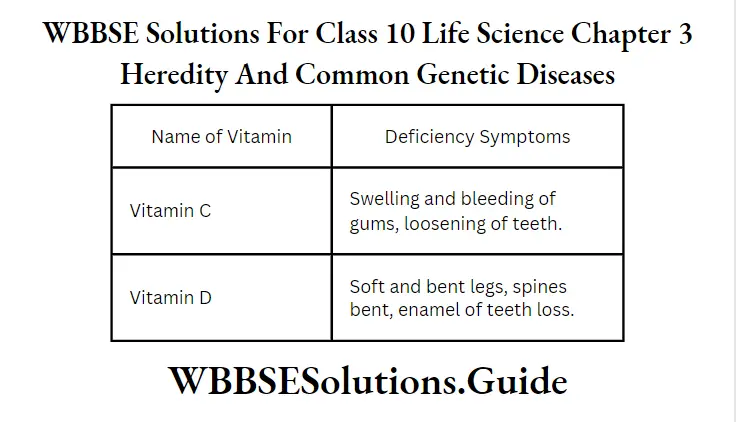
Question 116. Mention the deficiency symptoms of Vitamin ‘E’ and Vitamin ‘K’.
Answer:
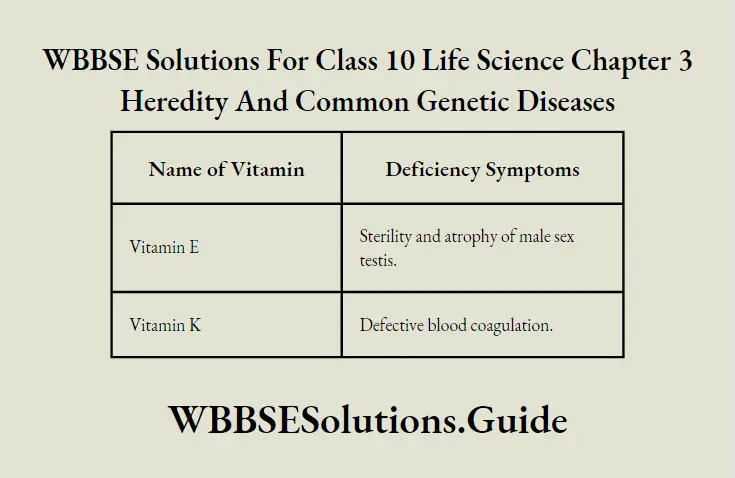
Question 117. Give the chemical name and source of Vitamin C.
Answer:
The chemical name of Vitamin C is ascorbic acid. Source of vitamin C ——
(1) Animal —— Adrenal cortex, Cow’s Milk
(2) Plant —— lemon, tomato.
Question 118. Classify vitamin K and vitamin C according to their solubility and deficiency disease.
Answer:
Vitamin K is soluble in fat and Vitamin C is soluble in water.
Deficiency disease:—
(1) Vitamin K ——— Haemorrhage
(2) Vitamin C —— Scurvy
Question 119. Write down two effects of the deficiency of vitamin ‘C’.
Answer:
(1) Scurvy —— Spongy and bleeding gums.
(2) Anaemia —The number of RBC and Platelets is reduced.
Question 65. What do you understand by essential macro elements?
Answer: The elements of which large quantity is required by living organisms for performing their different types of functions in their body are called essential macro elements.
Example:- Carbon, Hydrogen, Oxygen, etc.
Question 119. Name two trace elements that are essential for plant nutrition.
Answer:
(1) Copper (Cu)
(2) Zinc (Zn).
Question 120. Name any two of the non-metallic essential elements and state their respective sources.
Answer:
(1) Carbon:— CO2
(2) Hydrogen:— H2O
Question 121. In phosphorus (P) deficiency, what symptom is exhibited by the plant?
Answer: In phosphorus (P) deficiency leaves turn dark blue.
Question 122. What symptom is found in a plant due to a deficiency of Iron?
Answer: Due to a deficiency of Iron the color of leaves becomes yellow.
Question 123. What is the nitrogen deficiency symptom in plants?
Answer: Stunted growth and the lower portion of leaves become yellow.
Question 124. What is the source of the element Fe (Iron) in the case of human beings?
Answer: Fish is the source of the element Fe (Iron) in the case of human beings.
Question 125. In the absence of potassium which symptom is expressed in the case of a plant?
Answer: Leaves streaked with yellowish mottling at margins and tips.
Question 126. What is meant by chlorosis?
Answer: A plant disease that occurs mainly in leaves due to the deficiency of Iron (Fe), is called chlorosis.
Question 127. Name one macro element which is a major constituent of bones and teeth in animals. Name a disease in children caused due to the deficiency of that element.
Answer:
(1) The name of the macroelement is calcium.
(2) The name of the disease is Ricket.
Question 128. Name one macro element which is a major constituent of hemoglobin. Which disease is caused due to the deficiency of that element?
Answer:
(1) Name of macro element — Iron (Fe)
(2) Name of disease — Anaemia.
Question 129. Write one macro element and microelement each essential for the normal nutrition of plants.
Answer:
(1) Macro element — Nitrogen
(2) Micro element — Copper.
Question 130. Mention the role of magnesium in plant nutrition.
Answer:
Role of magnesium in plants:-
It is a component of chlorophyll. Hence, it takes part in chlorophyll formation. It acts as a co-enzyme of many enzymes.
Question 131. What is Basal Metabolic Rate?
Answer: The amount of energy spent by a living body per square meter per hour of body surface area at the time of complete physical and mental rest is called basal metabolic rate.
Value of BMR:—
40 K.cal/m?/hour. (in male), 37 Kcal/m2/hour (in females).
Question 132. What is the daily total average calorie requirement for an adult human male?
Answer: The daily total average calorie requirement for an adult human male is 3000 — 3400 Calories.
Question 133. What is a balanced diet?
Answer:
Balanced diet:-
A diet in which all the nutrients (such as carbohydrates, proteins, fats, minerals, vitamins, and water) are present in proper proportions is called a balanced diet.
Question 134. What is Diet?
Answer: A prescribed course of nutrients, which provides all requirements for the normal functioning of our body is called a diet.
Question 135. Define metabolism.
Answer: All cellular biochemical reactions leading to the synthesis of complex substances in the body using simpler substances with the help of energy and the breakdown of
complex substances to simpler substances together with the liberation of energy are called metabolism.
Question 136. Name the types of metabolism.
Answer:
There are two types of metabolism :
(1) Anabolism
(2) Catabolism.
Question 137. What do you mean by anabolism?
Answer: Cellular biochemical processes involved in the synthesis of complex molecules by using simpler substances and energy are called anabolism.
Ex. Photosynthesis.
Question 138. What do you mean by catabolism?
Answer: Cellular biochemical processes that are involved in the breaking of complex molecules into simpler substances with the liberation of energy are called catabolism.
Example — Respiration.
Question 139. Nitrogen is a very essential element for the nutrition of living beings.
Answer: Nitrogen takes part in the formation of living material like protoplasm, protein, hormone,s and enzymes.
Question 140. Why does one suffer from goiter?
Answer: Due to a deficiency of the ‘Iodine’ element in their diet, the persons suffering from goiter.
Question 141. Write two reasons why enzymes are called organic Bio-catalysts.
Answer:
(1) Enzyme is protein by nature and produced within living cells.
(2) Enzyme never starts the reaction, only increases or decreases the rate of reaction.
Question 142. Why do we take food?
Answer: We take food to obtain energy which is used to perform various metabolic functions and body activities. We take food for the growth and development of our
body also.
Question 143. Why is calcium necessary for us?
Answer: Calcium takes part in the formation of bone. It is also essential for blood clotting and muscle contraction.
Question 144. Why is phosphorus necessary for us?
Answer: Phosphorus takes part in the formation of ATP, bones, and teeth.
Question 145. Why does the food undergo digestion before absorption in our alimentary canal?
Answer: The process of digestion changes the complex food into a simple soluble form. Only simple and soluble substances are absorbed.
Question 146. Why is milk not considered a balanced diet for adults?
Answer:
Milk is not considered a balanced diet for adults due to the following reasons:—
(1) Presence of water in excess quantity
(2) Lack of Iron
(3) Absence of roughage
(4) Presence of vitamins in less quantity.
Question 147. Why do we lose weight during starvation?
Answer: Nutrients are not available to the cell during this period from outside. Cells obtain nutrients from the reserve stock. Reserve stock of food is gradually used up. So we lose weight during starvation.
Question 148. ‘All foods are nutrients but all nutrients are not foods’ — Why?
Answer: The essential organic and inorganic substances collected from nature that perform the basic activities of living organisms are called nutrients.
The nutrients which are organic edible substances that produce energy and provide material for growth are called food.
Therefore, all foods are nutrients but all nutrients are not foods.
Question 149. Why is glucose called the starting point of respiration?
Answer: Glucose is called the starting point of respiration because it is the end product of carbohydrate digestion. Its oxidation takes place within a cell. It starts the process of
respiration within the cytoplasm of the cell.
Question 150. What is the relationship between nutrition and circulation?
Answer: Nutrition:-
The total of the processes like ingestion, digestion, absorption, assimilation, and egestion is called nutrition.
Circulation:-
The translocation of various substances like digested food, minerals, vitamins, gases, excretory substances hormones, etc. through a liquid medium is called circulation.
Relation:-
Glucose, amino acids, and fatty acids are produced by the process of digestion. They reach the bloodstream by the process of absorption. These substances are supplied to different cells by the process of circulation. Thus nutrition provides the raw materials for circulation and circulation helps in the distribution of nutrients which are essential for the completion of its stages like assimilation.
Question 151. Write one structural and one functional difference between red blood cells and white blood cells.
Answer:
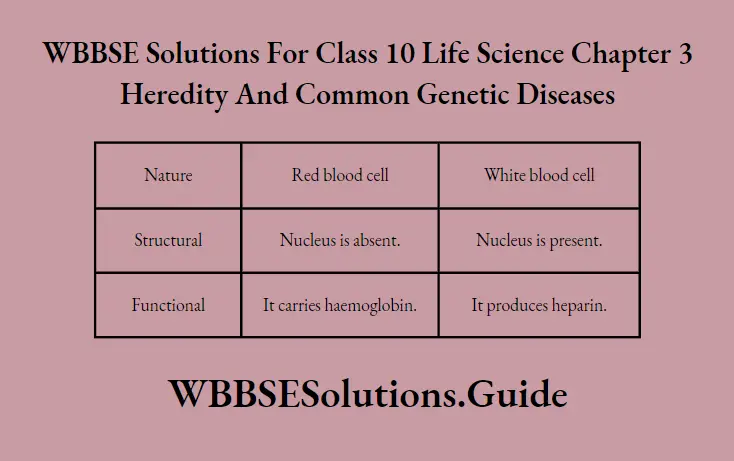
Question 152. Mention two functions of hemocyanin.
Answer:
(1) It carries oxygen gas from respiratory organs to tissue.
(2) It carries carbon dioxide gas from tissue to the respiratory organ.
Question 153. Mention the role of blood in protecting the human body from germs causing diseases.
Answer: The white blood corpuscles kill the germs by their phagocytic activity. Gamma globulin of plasma protein forms antibody which also protects the body.
Question 154. What is circulation?
Answer: The transportation of substances like digested food, gases, excretory products, mineral salts, and hormones through a liquid medium from one part of the body to other parts of the body, is known as circulation.
Question 155. What is the circulatory system?
Answer: A group of organs that are involved in completing the process of circulation is called the circulatory system.
Question 156. Name the different components (organs) of the blood circulatory system in the human body.
Answer:
(1) Heart
(2) Blood vessels (artery, vein, and capillary)
Question 157. What is blood?
Answer: Blood is a fluid connective tissue.
Question 158. What is pure blood?
Answer: The blood that contains sufficient oxygen is called pure blood.
Question 159. Name any one type of White Blood Corpuscles (W.B.C) and state its function.
Answer:
(1) Basophil.
(2) Function
It helps in the formation of ‘heparin’
Question 160. Name two components of mammalian blood besides plasma.
Answer:
(1) R.B.C.
(2) W.B.C.
Question 161. What is the function of hemocyanin?
Answer: It carries oxygen gas and carbon dioxide gas.
Question 162. What is the function of red blood corpuscles? Is there any nucleus present in human R.B.C.?
Answer:
1. Function:-
(1) It carries hemoglobin.
(2) It maintains the viscosity of blood.
2. No.
Question 163. What is the percentage of hemoglobin in human blood and name the disease that occurs if the percentage falls?
Answer:
(i) 95% — 115%.
(ii) Anaemia.
Question 164. What is a thrombocyte?
Answer: The non-nucleated blood cells that are produced by ‘mega karyocytes’ of the bone marrow are called thrombocytes.
Question 165. Name the respiratory pigment found in the blood of vertebrates. What is the function of that respiratory pigment?
Answer:
(1) Haemoglobin.
(2) It carries oxygen gas and carbon dioxide gas.
Question 167. Mention two functions of W.B.C.
Answer:
(1) To destroy harmful bacteria.
(2) To produce heparin’.
Question 168. Blood is red – Why?
Answer: Blood is red because it contains hemoglobin, an iron-containing pigment.
Question 169. What is the function of thrombocytes?
Answer: To produce an enzyme. (Ex. Thrombokinase), it helps in blood clotting.
Question 170. How many types of blood groups are found in man? What are those groups?
Answer:
(1) Types of blood groups – 4
(2) Name of blood groups – A, B, AB, O.
Question 171. How many chambers are there in the heart of a man?
Answer: 4 (Right auricle, Right ventricle, Left auricle, Left ventricle) chambers are present in the heart of a man.
Question 172. What is a tricuspid valve?
Answer: A set of three cusps valves located between the right auricle and right ventricle is called a tricuspid valve.
Question 173. What do you mean by blood groups?
Answer: The types of human blood, the classification of which is done based on ‘antigen’, are called blood groups.
Question 174. What is blood coagulation?
Answer: The bio-chemical process that occurs at the injured part of the body and due to which fluid blood is changed into solid and checks the oozing of blood is called blood
coagulation.
Question 175. What is meant by Immunity?
Answer: The ability of living organisms they protect themselves from the harmful effects of the chemicals or germs is known as ‘Immunity’.
Question 176. Mention two characteristics of blood as connective tissue.
Answer:
(1) A connective tissue has a matrix. In blood, the matrix is found. Hence blood is a connective tissue.
(2) A connective tissue connects the different parts of the body. Blood also connects the different parts of the body, so blood is a connective tissue.
Question 177. In which way CO2 CO2-rich blood transported to the lungs from the human heart?
Answer: Through the pulmonary artery from the right ventricle, CO2-rich blood is transported to the lungs from the human heart.
Question 178. What are the functions of the right auricle and left ventricle in the human heart?
Answer:
(1) Function of the right auricle:-
It receives deoxygenated blood from the vena cava and supplies it to the right ventricle.
(2) Function of the left ventricle:-
It receives oxygenated blood from the left auricle and supplies this blood to the aorta.
Question 179. What do you mean by open circulation? Give one example.
Answer: The type of circulation in which blood flows within the sinuses of the body so that the internal parts are in direct contact with blood, is called open circulation.
Ex. Cockroach.
Question 180. What do you mean by closed circulation? Give one example.
Answer: The type of circulation in which blood flows only within blood vessels is called closed circulation.
Ex. Man.
Question 181. Mention the mediums of transport in animal and plant bodies.
Answer:
(1) In Animal Bodies – Blood and Lymph.
(2) In Plant bodies – Water.
Question 182. What are the functions of the left auricle and right ventricle in the human heart?
Answer:
(1) Function of the left auricle:-
It receives oxygenated blood from the lungs through two pairs of pulmonary veins and sends it to the left ventricle.
(2) Function of the right ventricle:-
It receives Deoxygenated blood from the right auricle and sends it to the lungs through the pulmonary artery.
Question 184. What is Blood Pressure? Name an instrument used to measure this.
Answer:
(1) Blood Pressure:-
The pressure exerted on the walls of blood vessel (Artery)
by the blood during its flowing is called blood pressure.
(2) Name of instrument:-
Sphygmomanometer.
Question 185. What is Antigen and Antibody?
Answer:
Antigen:-
Any foreign material like germs, abnormal proteins, etc. which gets entry into the body is termed an: antigen.
Antibody:-
The organic substances that are chemically protein in nature and produced within the cytoplasm of the cell in response to antigens are called antibodies.
Question 186. What is the main function of the heart?
Answer: To collect deoxygenated blood from the superior and inferior vena cava and oxygenated blood from the lungs and distribute the oxygenated blood to different organs
of the body.
Question 187. What are Lymphocytes? Write their functions.
Answer: They are non-granular leucocytes. (W.B.C.).
Function:-
They produce antibodies.
Question 188. What do you mean by systole and diastole?
Answer:
Systole:-
The contraction of the heart is called Systole.
Diastole:-
The expansion (Relaxation) of the heart is called diastole.
Question 189. What is the normal amount of hemoglobin present in the blood of an adult man?
Answer: 14.5mg / 100 milliliter is the normal amount of hemoglobin present in the blood of an adult man.
Question 190. What is Capillaries?
Answer: The place of blood vessels from where the exchange of GIeF and the nature of substances takes place is called Capillaries.
Question 191. What do you mean by universal donor?
Answer: The group of blood that is transfused to all groups of blood safely is called a universal donor.
Ex. O blood group.
Question 192. What do you mean by universal recipient?
Answer: The group of blood that can receive all types of blood is called the universal recipient.
Ex. AB group blood.
Question 193. What is the function of the right auriculo—ventricular valve in man?
Answer: The right auriculoventricular valve allows blood to enter only into the right ventricle from the right auricle. It does not allow blood to return from the right ventricle to the right auricle.
Question 194. Which chambers of the human heart are known as the receiving part and which chambers are known as the forwarding part of blood circulation through the heart?
Answer: Receiving part — Right auricle and Left auricle.
and Forwarding part — Right ventricle and Left ventricle.
Question 195. State two different systemic veins and portal veins.
Answer:
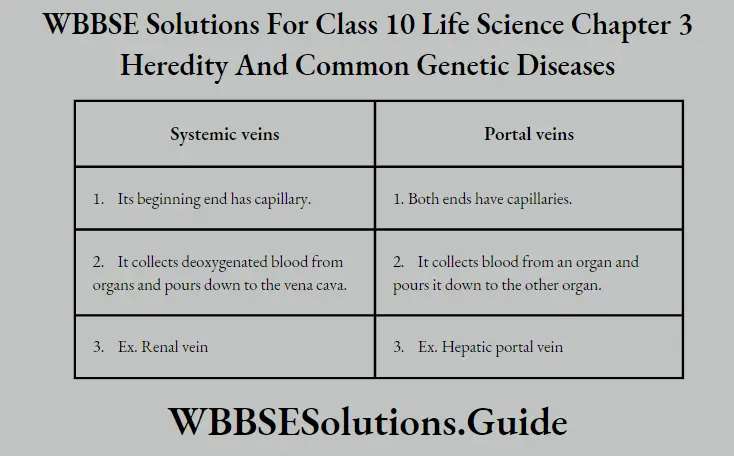
Question 195. What is double circulation?
Answer: The process of circulation which occurs in four chambers containing the heart is called double circulation.
Ex – man
Question 196. Write one structural and one functional difference between the bicuspid and the tricuspid valve.
Answer:
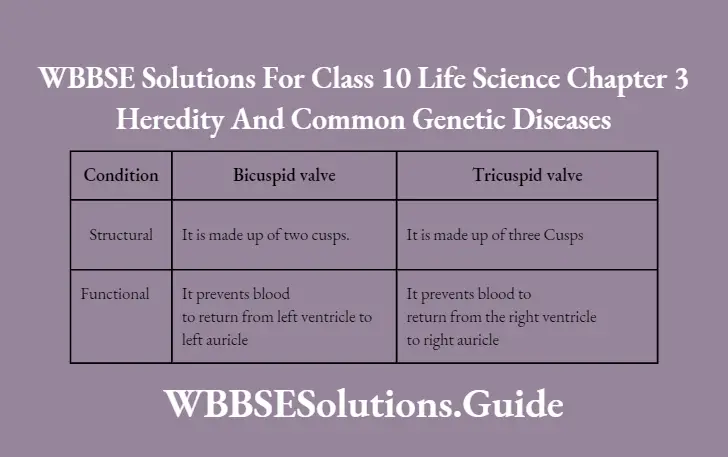
Question 197. Name the vein that carries oxygenated blood. From which part does it carry this blood and to where?
Answer:
(1) Plumonary Vein.
(2) From lungs to left auricle.
Question 198. Name the blood vessel entering the kidney and the type of blood that flows through it.
Answer:
(1). Renal artery.
(2) Urea containing blood.
Question 200. Define venous heart with an example.
Answer: One auricle and one ventricle containing a heart in which always deoxygenated blood is flowing, is called a venous heart.
Ex — Fish heart.
Question 201. Name two main respiratory pigments in animals.
Answer:
(1) Haemoglobin
(2) Haemocyanin.
Question 202. Write two reasons for the non-coagulation of blood within the blood vessels in normal conditions.
Answer:
Reasons:-
(1) Presence of heparin.
(2) Presence of intact thrombocytes
Question 203. When any part of our body is cut, why doesn’t the entire blood come out from it?
Answer: Because blood forms a clot at that place, which prevents the blood from coming out.
Question 204. Why is blood transfusion not always possible from one person to another?
Answer: Because the antigens of the donor blood do not match with the antibodies of the recipient blood. In this case, a clump is formed which blocks the blood vessels
of the recipient.
Question 205. Why does blood not clot while flowing through the vessels?
Answer:
(1) Due to the presence of an anticoagulant substance (e.g. Heparin) in the blood of blood vessels.
(2) Due to the smooth inner wall of blood vessels.
(3) Thromboplastin which is necessary for blood clotting is not produced by intact thrombocytes.
Question 206. Why is Land Steiner famous?
Answer: Land Steiner discovered the blood group.
Question 207. Why is it necessary to know an individual’s blood group?
Answer: For the safe transfusion of blood to the needy person in case of accident or other cases. It is also necessary for the selection of a proper matching pair to avoid fatal cases.
Question 208. Why is the heart of a fish called the venous heart?
Answer: A fish heart has one auricle and one ventricle. Deoxygenated blood flows within it. Hence its heart is called a venous heart.
Question 209. Why is the blood of a cockroach colorless?
Answer: The blood of the cockroach is colorless because respiratory pigments are absent in it.
Question 210. Why is the color of the plasma slightly yellow?
Answer: The color of plasma is slightly yellow due to the presence of some compounds. Such as bilirubin.
Question 211. Why do birds and mammals have separate oxygenated and deoxygenated blood?
Answer: The rate of anabolism is higher in birds and mammals they need more oxygenated blood to produce energy by the process of respiration. Their heart is made of four chambers. So, the oxygenated and deoxygenated blood do not mix. The structure of the heart helps supply oxygenated blood to the body.
Chapter 3 Heredity And Common Genetic Diseases Short Answer Questions
Question 1. Mention two criteria for classifying a mineral into macronutrients.
Answer:
(1) These elements are present in larger quantities (1-10 mg per gram dry weight of plants).
(2) They are mainly involved in the synthesis of structural components of the plants.
Question 2. Mention two criteria for classifying a mineral into a micronutrient.
Answer:
(1) These elements are present in minute quantities (0.1 mg or less per gram dry weight of plant) and are also known as trace elements.
(2) High concentrations of ‘micronutrients may prove to be toxic.
Question 3. How do minerals help in the formation of protoplast?
Answer: Formation of protoplast: Various mineral elements, such as C, H, O, S, Mg, P, N, and Fe, play a prominent role in the formation of chemical constituents of protoplasm.
Question 4. Which minerals help in the growth of plants?
Answer: Growth: Mineral elements, such as Zn, Mn, B, etc. maintain normal growth of stem and root.
Question 5. Mention two points of importance of phosphorus in plant nutrition.
Answer:
Phosphorus (P) :
(1) Plays an important role in protein synthesis.
(2) Acts as a component of ATP, NADP, and membrane of cells & other organelles.
Question 6. Mention two points of importance of iron in plant nutrition.
Answer:
Iron (Fe) :
(1) Helps in the formation of chlorophyll & chromatin reticulum.
(2) Acts as a structural element of electron carriers & helps in ion transport.
Question 7. What is transpiration?
Answer:
Transpiration
The elimination of non-utilized excess water in the form of vapor from the plant body, under the influence of sunlight, and controlled to some extent by protoplasmic called transpiration.
Question 8. Draw and label a structure of stomata.
Answer:
Question 9. What is evaporation?
Answer:
Evaporation
Evaporation is a physical process in which water changes from a liquid to a gaseous form, i.e., vapor, to the unsaturated atmosphere from the free exposed surfaces of the living and non-living bodies.
Question 10. State how light influences transpiration.
Answer: Light — Transpiration increases in the presence of light and decreases in the absence of light, as stomata open during the day and close during the night. Light influences transpiration by increasing the temperature of the leaf.
Question 11. What is cuticular transpiration?
Answer:
Cuticular transpiration — The water vapor which is lost through the pore of the cuticle of the leaves directly, is called cuticular transpiration. Some amount (10-20%) of water vapor is lost by direct evaporation from the epidermal cells through the cuticle of the leaves. Structure of cuticle.
Question 12. Draw and label a structure of lenticel.
Answer:
13. What is diffusion?
Answer:
Diffusion :
Diffusion is defined as a physical process where molecules or ions migrate from a region of higher concentration to a region of lower ‘concentration, through liquid or gaseous medium by. their random motion.
Question 14. What is root pressure?
Answer:
Root pressure
This active hydrostatic pressure created in the parenchymatous cortical cells of the roots is called the root pressure. val.
In the year 1956, Stocking defined root pressure “as a pressure developing in the tracheary elements of the xylem as a result of the metabolic activities of roots.”
Question 15. What is transpiration pull?
Answer:
Transpiration Pull :
During this a pull is created due to an increased concentration of cell sap, this pull over the water molecule forming pillar, due to transpiration is called transpiration pull.
Question 16. State the relation between absorption and ascent of sap.
Answer:
Relation between Absorption and Ascent of Sap: Unicellular root hairs absorb water and minerals (capillary water and minerals) from the soil. This water enters the cortical cells by cell-to-cell osmosis and diffusion. Hydrostatic pressure exerted by these turgid parenchymatous cortical cells helps the water to enter the xylem vessels. The transpiration pull from the leaves and the root pressure from below accounts for the ascent of sap through the xylem vessels. The continuity of the water column is maintained by the cohesion of water molecules with each other and the adhesion of water molecules with the xylem vessel wall.
Question 17. What do you mean by cohesion and adhesion?
Answer:
(1) Adhesion — Adhesion is the molecular attraction exerted between the surface of bodies in contact, i.e., the union between water molecules with the inner xylem vessel wall.
(2) Cohesion — Cohesion is the molecular attraction by which the particles of a body are united throughout the mass, i.e., the union between water molecules.
Question 18. What do you mean by permeable membrane?
Answer:
Permeable membrane — Such membrane allows all the molecules or ions of a solution (both solute and solvent molecules) to pass through it, e.g. filter paper, cell wall, etc.
Question 19. What do you mean by semipermeable membrane?
Answer:
Semipermeable membrane — Such membrane allows passage of water (solvent) molecules and positively charged hydrogen ions, but on the solute molecules nor the other positively charged and negatively charged particles, e.g. parchment
paper, air bladder of fish, egg’s membrane, etc. The semipermeable membrane can be better termed as differentially permeable, which allows the passage of some solutes but holds back others at different rates of diffusion.
Question 20. What do you mean by plant circulation?
Answer:
Plant circulation
The process by which movement of food, water, minerals, hormones, enzymes, and other substances takes place through the liquid medium of the living body by special conducting tissues xylem and phloem, is called plant circulation.
Question 21. What is osmosis?
Answer:
Osmosis :
Osmosis is defined as the physical process in which solvent molecules move from the region of higher concentration to the region of lower concentration through a semipermeable membrane, separating these two.
Question 22. Mention the role of water and sunlight in photosynthesis. Write the overall reaction of this process. Mention the role of photosynthesis in maintaining the balance of CO2 and O, in air.
Answer:
Role of water in the process of photosynthesis:—
Water is a raw material for photosynthesis. It is essential for this process. It supplies hydrogen for the reduction of CO2. Thus it takes part in glucose formation. The oxygen of water is changed into the free form of oxygen gas which comes out through the stomata.
Role of sunlight in photosynthesis :
The intensity, quality, and duration of Light influence the rate of photosynthesis. The light activates chlorophyll. Activated chlorophyll performs photolysis. Too much high-intensity light may even stop the process of photosynthesis. The inhibition of photosynthesis due to high-intensity light
which slows down its rate is called solarization. The rate of photosynthesis is directly related to the duration of light.
Equation :- 6CO2 + 12H2O→ C6H12O6 + 6H2O + 6O2
Role of photosynthesis in maintaining the balance of CO2 and 0, in the environment:—
The percentage of CO2 and O2 gas in (air and water) is maintained by photosynthesis. Autotrophs take in CO2 gas from their environment for the process of photosynthesis. They liberate O2 gas during this process. All living organisms take in O2 gas and release CO2 gas during respiration. Thus photosynthesis and respiration in a combined effect maintain the balance of CO2 and O2 in the environment.
Question 23. What is photosynthesis? Discuss the importance of the process of photosynthesis in the entrapping of solar energy in green plants and the maintenance of CO2 — O2 balance in the environment.
Answer:
Photosynthesis :
The anabolic reaction that occurs between carbon dioxide
gas and water in the presence of sunlight and chlorophyll to produce glucose is known as photosynthesis.
Equation :- 6CO2 + 12H2O→ C6H12O6 + 6H2O + 6O2
Importance of Photosynthesis:—
(1) In the entrapping of solar energy in green plants:—
The sun’s radiant energy is the only source of energy for all the living organisms of this biosphere. But this form of energy is directly utilized by green plants only. Chlorophyll which is a photosynthetic pigment only present in the grana region of the chloroplast of plant cells. Chlorophyll molecules absorb the radiant energy and change it into activated chlorophyll which splits water molecules into H+ ions and OH– ions and begins the process of photosynthesis. At the end of this process, the radiant energy is finally converted into chemical energy. This chemical energy is stored within glucose molecules. All other organisms obtain their energy from this glucose directly or indirectly. Thus by entrapping radiant energy during photosynthesis green plants supply chemical energy to the other forms of life.
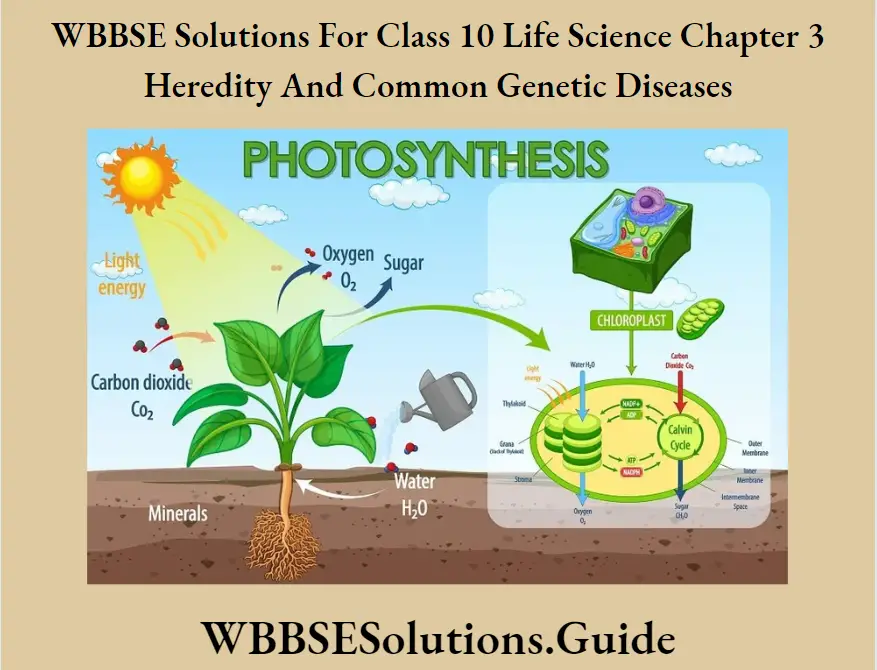
(2) Maintenace of CO2 and O, balance in the environment:—
The percentage of CO2 and O2 gas in (air and water) is maintained by photosynthesis. Autotrophs take in CO2 gas from their environment for the process of photosynthesis. They liberate O2 gas during this process. All living organisms take in O, gas and give out CO2 gas during respiration. Thus photosynthesis and respiration in a combined effect maintain the balance of CO2 and O2 in the environment.
Question 24. Explain the following reaction 6CO2 + 12H2O → C6H12O6 + 6H2O + 6O2 Where does the process related to the above reaction occur? Explain the significance of that process.
Answer:
1. Facts obtained by the reaction:-
(1) This reaction takes place in the presence of sunlight and chlorophyll.
(2) Carbon dioxide and water are reactants.
(3) Glucose, oxygen, and water are products.
(4) 6 molecules of carbon dioxide combine with 12 molecules of water to produce one molecule of glucose, 6 molecules of oxygen, and 6 molecules of water.
(5) Here water is oxidized to produce free oxygen and carbon dioxide is reduced to produce glucose.
2. This reaction occurs in the Grana and stroma region of the chloroplast of a plant cell.
3. Significance of photosynthesis:—
(1) Solar energy is entrapped and converted into chemical energy by this process. This chemical energy is stored within food (ex. glucose). This food is the source of energy for all living Autotrophs and Heterotrophs.
(2) CO, and O, balance is maintained by this process.
Question 25. Mention two differences between photosynthesis and respiration. Discuss the roles of sunlight and chlorophyll in the process of photosynthesis.
Answer:
(1) Two differences between photosynthesis and respiration:—
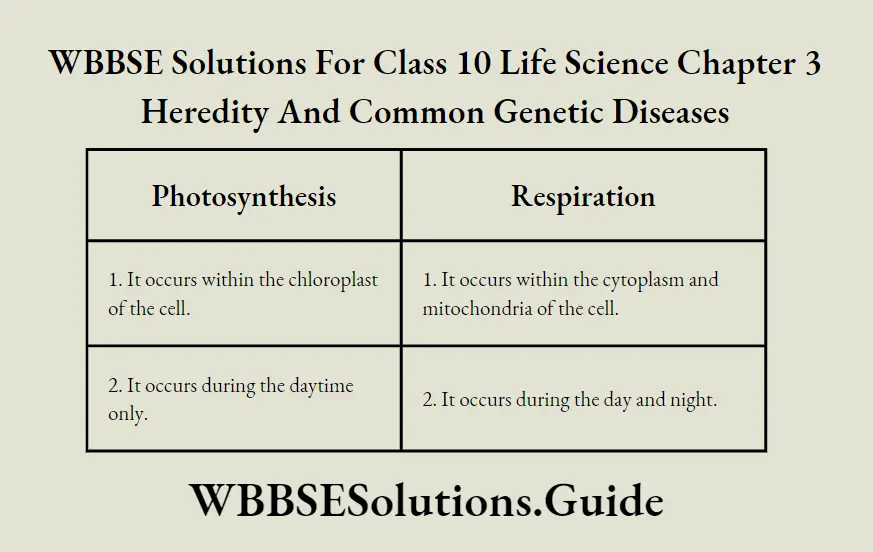
(2) Role of sunlight in photosynthesis:—
The intensity, quality, and duration of influences the rate of photosynthesis. Photolysis of water occurs in the presence of light. Too much high-intensity light may even stop the process of photosynthesis. The inhibition of photosynthesis due to high-intensity light which slows down its rate is called solarization. The rate of photosynthesis is directly related to the duration of light.
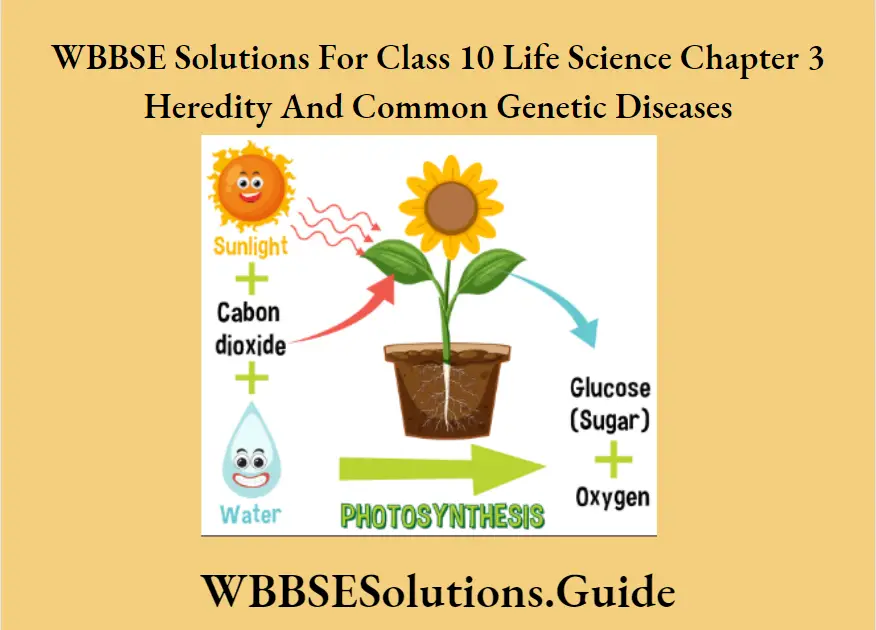
(3) Role of chlorophyll in photosynthesis:—
Chlorophyll is a magnesium-containing green pigment present in the chloroplast of green plants. The chlorophyll pigment first absorbs the incoming solar radiation. It results in the activation of the chlorophyll. Activated chlorophyll causes the dissociation of water. Hence chlorophyll helps in the photolysis of water.
Question 26. Describe briefly the process of photosynthesis.
Answer:
Process of Photosynthesis:—
The process of photosynthesis is completed in two main phases:—
Light Phase:—
This is the 1st phase of photosynthesis. It occurs in the grana
region of chloroplast. Light energy is necessary for the beginning of this phase.
This phase is divided into two parts:—
(1) Photolysis of water:—
When sunlight falls on the surface of the green leaves of plants, some part is absorbed by chlorophyll molecules, and the remaining part is reflected from the surface to the environment. The chlorophyll molecules are changed into activated chlorophyll after the absorption of light. Activated chlorophyll splits water molecules into H+ ions and OH ions. OH– ion loses one electron and is converted into OH radical. This OH radical is changed into water and oxygen gas. Water again takes part in metabolic reaction and oxygen comes out to the environment through stomata. H+ion gains one lost electron of OH– ion and is changed into a neutral hydrogen atom. It combines with NADP (Nicotinamide Adenine
Dinucleotide Phosphate) and reduces it into NADPH, At the end of this reaction, the activated chlorophyll molecule resumes its original state.
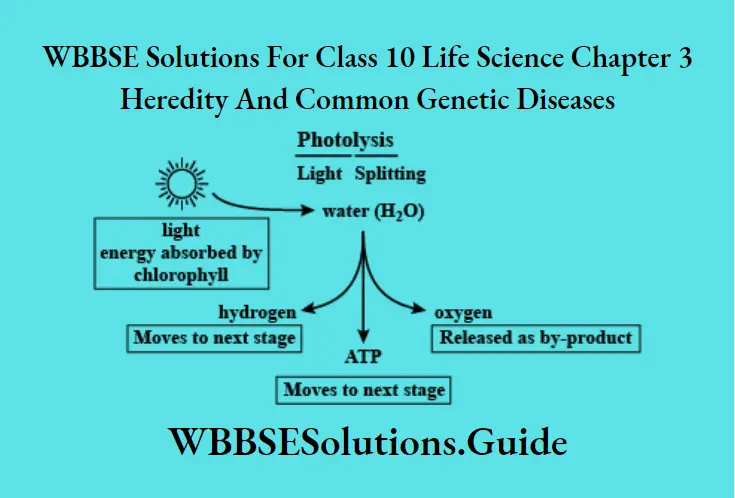
(2) Photophosphorylation:—
The tet formation of ATP in the presence of sunlight by Ree the combination of ADP and inorganic HeOGyatcy, Oe phosphorus is called photophosphorylation.
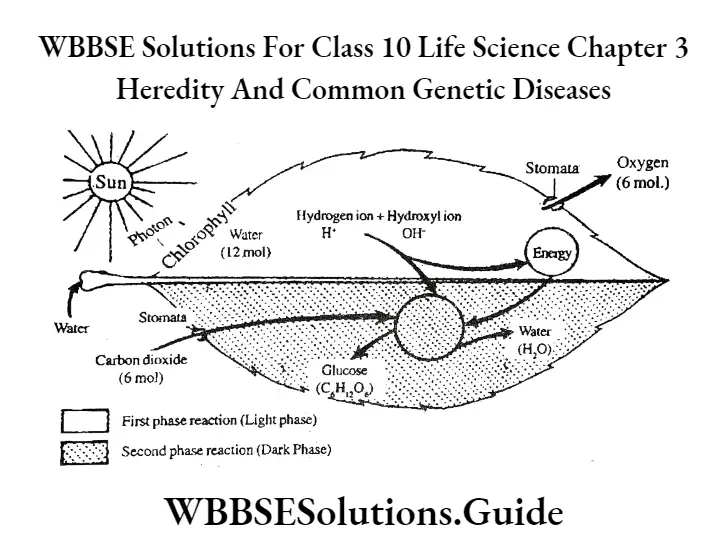
Dark reaction:-
This is the second and last phase of photosynthesis. It occurs in the stroma region of the chloroplast. It takes place after 1/1000th second of the end of the light phase. Light energy is not necessary for the beginning of this phase.
Ribulose Diphosphate (5-carbon organic compound) is already present in the stroma region. It combines with CO2 and forms a six-carbon unstable compound (C6H12O13P2,).
This unstable compound forms two molecules of the 3-carbon compound in a very short interval of time. The name of this 3-carbon compound is phosphoglyceric acid (PGA). It reacts with ATP and is converted into 1, 3 Diphosphoglyceric Acid (PGA).
DiPGA reacts with NADPH2 and forms 3, Phosphoglyceraldehyde (PGAID). Now the two molecules of phosphoglyceraldehyde react and form one molecule of Fructose Siphosphate.
Fructose Diphosphate forms one molecule of glucose phosphate and in the last one molecule of glucose is produced from one molecule of glucose phosphate.
Light Phase:
(1) Sunlight →Chlorophyll → Activated chlorophyll
Activated Chlorophyll → H2O →H+ + OH–
NADP + 2H = NADPH2, 4OH + 2H2O + O2
ADP + iP + energy = ATP
Dark Phase:
RuDP + CO2 = 6 carbon unstable compound
5C 1c
6 carbon unstable compound →2 molecules of PGA
(3C)
PGA + ATP > DiPGA (3C)
DiPGA + NADPH, → PG.Ald. (3C)
2DipGAld — Fructose Diphosphate
Fructose Diphosphate — Glucose phosphate
Glucose phosphate — Glucose.
Question 27. Write a short note on the role of photosynthetic pigments in the process of photosynthesis.
Answer:
Pigments — Chlorophyll and Carotenoids 3 The main photosynthetic pigment is chlorophyll.
Role — The photolysis of water during the light phase of photosynthesis is caused by excited chlorophyll molecules. The cause of their excitation is the absorption of highly energized invisible solar particle photons. H2O → H+ (Hydrogen ion) + OH– (Hydroxyion).
The entrapping of solar energy and its conversion to Genie energy in the form of ATP (Adenosine tri-phosphate) is carried out by activated chlorophyll molecules.
Plant pigments :
Plants may contain two types of piel seins green coloured ee chlorophyll and yellowish orange coloured carotenoid.
(1) Chlorophylls are of two types—Chlorophyll a(C55H72O5N4Mg) and Chlorophyll b(C55H70O6N4Mg), Chlorophyll c, d and e are also present. Chlorophyll atoms are arranged in a circle with the help of four pyrrole rings with the Mg atom at the center. Along with the pyrrole ring is attached phytol (a type of alcohol).
(2) Carotenoids are of two types—Carotene (C40H56)—the orange-colored can’t Xathophyll. (C40H56O2)—the yellow-colored pigments.
(3) Phycocyanin — the blue colored and Phycoerythrin — the lavender rec colored pigments.
II. Carotenoids :
Carotenoids are yellow, brown, orange, or yellow pigments found in close association with chlorophylls in all photosynthesizing cells. They occur in thylakoids and act as accessory pigments of photosynthesis. They are present in nearly all higher plants, algae, and some microorganisms. Goodwin (1960) suggested that the chlorophylls and carotenoids may be attached to the same protein, forming a complex known as phosynth.
Carotenoids are of two types:
(1) Carotenes — They are orange to yellow and are unsaturated hydrocarbons (C40H56). They are insoluble in water but readily soluble in chloroform ether and carbon disulfide. They absorb blue and green lights and transmit yellow and red lights. Four isometric forms of carotenes are now recognized. α, β, γ, and δ of which β-carotene is most common in all green plants.
(2) Xanthophylls or Carotenols — They are yellow with the empirical formula C40H56O2. In normal green leaves, proportionately there is more xanthophyll than carotene. The most common xanthophyll in green leaves is luteol or lutein.
Apart from their role in the absorption of light energy and its transfer to chlorophyll, the carotenoids play a very important role in protecting chlorophyll molecules from
photo-oxidation within the photosynthetic apparatus.
Question 28. Write a short note on the absorption and action spectra of photosynthesis.
Answer:
Absorption Spectrum :
All organic substances absorb light, but colored pigments absorb only visible light. The absorption spectrum is the pattern of absorption of light at the different wave, lengths by the object. Studying the absorption spectrum of chlorophyll a and b, it is revealed that these pigments absorb red and blue regions of spectra chiefly.
The plot of efficiency with which the different pigments like chlorophyll-a and chlorophyll-b absorb different wavelengths (or color) of light in the region of blue-violet, with peaks about 429 and 453 m µ respectively and the next maximum is in the red region of about 642 m µ and 660 m µ respectively, is called the absorption spectrum.
The carotenoid pigments play a role in photosynthesis by absorbing light and passing it to chlorophyll where it is used in the photosynthetic process.
Absorption spectra are one of the properties of chlorophyll, during which they can absorb certain wavelengths of light. When the chlorophyll solution is kept in between ordinary light and a spectrometer, then it is observed that certain wavelengths of light are absorbed more than others. Maximum absorption of chlorophyll-a and chlorophyll takes place in the blue-violet region and the next maximum in the red region.
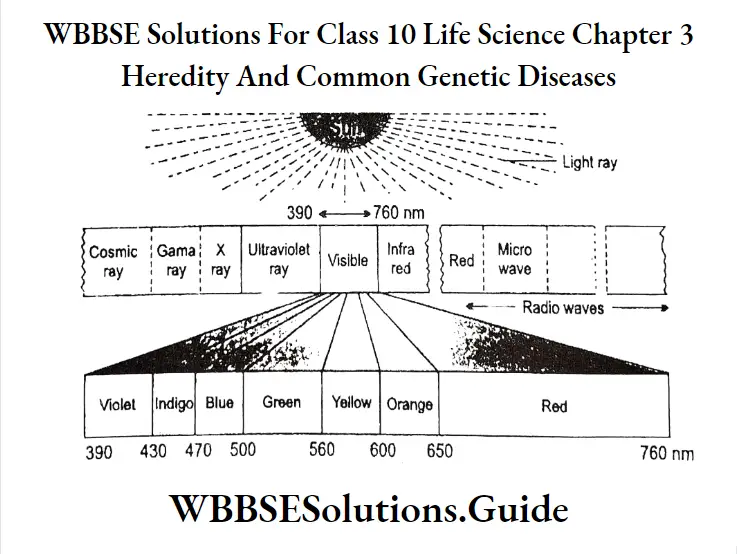
Action spectrum of photosynthesis :
When a beam of sunlight is passed through a glass prism the following colors are visible- violet, indigo, blue, green, yellow, orange, and red. The above component colors of light possess their range of wavelength. By utilizing the above component wavelengths of white light, it is possible to find out which wavelengths or colors of light help to run the process of photosynthesis most effectively and efficiently. A pattern can be drawn without any trouble by plotting the effectiveness of each wavelength of light that stimulates photosynthesis. Such a plot of the photochemical effect caused by equal energies of various wavelengths of light is called an action spectrum. This spectrum shows that blue and red light regions of the spectrum help to run the photosynthetic process more effectively.
Question 29. Write a short note on the site of photosynthesis.
Answer:
Site of photosynthesis :
The process of photosynthesis occurs within the chloroplastids of the mesophyll cells of green leaves. It also occurs in the chlorophyllous tissue of green-colored young stems, calyx of flowers, phylloclade of cacti fruit coat of young fruits, and aerial roots of orchids. It may also occur in lower plants like algae, bryophytes, and photosynthetic bacteria. It even occurs in the cells of certain protozoa, like Chrysamoeba and Euglena.
The leaves are the best site for photosynthesis. These are flattened structures having more surface area for trapping greater amounts of solar energy and absorbing CO2 from the air. Closely arranged cells of mesophyll tissue, which are the site of photosynthesis, are present in the leaves.
Question 30. Define nutrients. Differentiate between macro and micronutrients.
Answer: The organic and inorganic materials that provide energy to the body and keep the body in good and healthy condition are called Nutrients. All nutrients are food, but all foods are not nutrients.
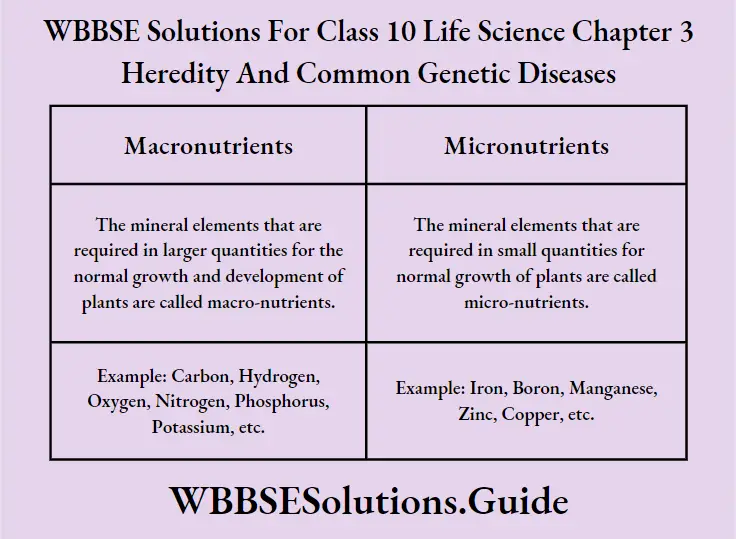
Question 31. What are the general functions of essential mineral elements?
Answer:
General functions of essential mineral elements
(1) Formation of protoplast — Certain elements play an important role in the formation of constituents of protoplasm like C, H, O, N, S, etc.
(2) Structure of enzymes — Elements like C, H, O, N, Mg, Fe, Zn, and Cu are involved in the formation of enzymatic components and their functions.
(3) Oxidation — Reduction reaction — elements like Iron and copper take part in electron transfer.
(4) Gsmotic balance — Inorganic salts in the cell sap like Cl–, K+, PO4-3, and SO4-2 are involved in maintaining the osmotic balance of the cell.
(5) Formation of chlorophyll — Magnesium is the chief component of chlorophyll.
(6) Buffer effect — Phosphate, bicarbonate, and carbonate act as buffers.
Question 32. Mention the functions of macro- and micro-elements in plants.
Answer:
(1) Potassium – Regulates intracellular fluid volume. Permeability of cell membrane Chlorophyll synthesis. Activator for many enzymes.
(2) Calcium – Constituent of middle lamellas up. An important role in ion transport. Act as an activator for enzymes.
(3) Carbon – Constituent of protoplasm, cell wall, and cell materials.
(4) Oxygen stra – Required for aerobic respiration
(5) Nitrogen – Constituent of protoplasm and almost all cellular materials, amino acid, protein, enzymes, nucleic acid, etc.
(6) Hydrogen – Constituent of protoplasm
(7) Sulphur – Constituent of protoplasm, some protein and vitamins.
(8) Phosphorus – Constituent of protoplasm, Nucleic acid, Nucleoprotein, Phospholipid, etc.
(9) Magnesium – Constituent of chlorophyll, an activator of many enzymes of photosynthesis, respiration, and nucleic acid synthesis.
(10) Manganese an important role in chlorophyll synthesis, and activates many respiratory enzymes.
(11) Boron – Help in translocation of sugar, active salt absorption, Murillo
(12) Copper – Constituent of oxidizing and reducing enzymes highly toxic in higher concentrations.
(13) Molybdenum – A component of enzyme, plays an important role in nitrogen metabolism.
(14) Zinc – Required for synthesis of auxin IAA.
Question 34. What is the significance of nutrition?
Answer:
Significance or Importance of Nutrition:
(1) promote growth, repair wear and tear of the damaged tissues, and gain energy to control the different metabolic processes are the main functions of nutrition.
(2) Through nutrition the potential energy stored within food is transformed into usable energy. The different physiological functions of the living body like movement, locomotion, excretion, reproduction, etc. are controlled by utilizing this energy.
(3), Through nutrition the disease-resistant power of the living body is developed.
(4) Through nutrition future food matters are stored within the living body. From those stored food (in the plant body mainly as starch and in animals as glycogen and fat) the future energy is produced during shortage of food.
(5) Nutrition plays a special role in the production of heat energy in the animal body to meet the caloric demands of an individual.
Question 35. Mention the general functions of essential mineral nutrients in plants.
Answer: The general functions of essential mineral nutrients are —
(1) Formation of protoplasm :
The formation of a major part of the protoplasm in a living cell needs mineral elements like carbon, hydrogen, and oxygen. Nitrogen, sulfur, and phosphorus also take part in the formation of protoplasm.
(2) Structure of enzyme :
Some mineral nutrients act in the formation of the structure of enzymes (act as catalysts) in many precursors. Some mineral elements like magnesium, ‘manganese, cobalt, etc. perform the functions of activators on inhibitors in the system of enzymes. Phosphorus helps in the formation of coenzymes like NAD, NADP, FAD, ATP, etc. Mg, S, and K, ct as an activator of enzymes.
Copper is a component of certain enzymes (i.e., phenolases, laccase, and ascorbic acid) oxidases sulfur contains coenzyme A. Calcium is an essential part of amylase, an enzyme that helps in starch digestion. Iron is noted in enzymes like peroxidases and catalases. Manganese helps in the formation of the enzymes decarboxylate and oxidase is citric acid.
(3) Oxidation-reduction reaction :
Oxidation is simply regarded as a chemical reaction with oxygen (loss of electrons). The reverse process of loss of oxygen is called reduction. Reaction with hydrogen is also regarded as reduction (gain of electrons).
(4) Osmotic balance :
Certain mineral nutrients counteract the poisonous effect of some other elements by maintaining the osmotic balance (an ionic balance). The behavior of one ion in reversing the normal effect of another ion is called antagonism. To this group of elements lies Ca, Mg, and K. They are termed balancing elements, whereby osmotic balance is maintained.
(5) Formation of Chlorophyll :
Magnesium and nitrogen play a great role in the formation of chlorophyll, the green pigments in plants. Iron takes part in chlorophyll synthesis.
(6) Buffer effect :
The effect produced when a solution resists change in pH when an acid or alkali is added or when the solution is diluted is called the buffer effect.
The mineral nutrients play a great role in the pH of all sap. Some of the vital buffer systems in an organism’s body are the carbonate-bicarbonate system and phosphate
buffer.
Question 36. What are the criteria for classifying mineral nutrients into macronutrients? and micronutrients?
Answer:
To categorize mineral nutrients as macronutrients or micronutrients, they should fulfill certain criteria. These criteria are discussed below.
Criteria for macronutrients :
(1) These elements are present in larger quantities (1-10 mg per gram dry weight of plants).
(2) They are mainly involved in the synthesis of structural components of the plants.
(3) They also participate in maintaining the osmotic potential of the plants.
Criteria for micronutrients :
(1) These elements are present in minute quantities (0.1 mg or less per gram dry weight of plant) and are also known as trace elements.
(2)High concentrations of micronutrients may prove to be toxic.
(3) They participate in the electron transport mechanism and act as cofactors for various enzymes.
Question 37. What are the different types of transpiration? Or, Classify transpiration based on its site of occurrence.
Answer: Based on the type of plant organs through which water is lost, there are three kinds of transpiration, viz. cuticular, lenticular, and stomatal.
I. Cuticular Transpiration
The physiological process of loss of water in the form of water vapor through the cuticle of the exposed surface of plant organs is known as cuticular transpiration.
The cuticle is a waxy layer on the leaf covering the epidermis and preventing transpiration. However, there are some scattered pores present in the cuticle which results in
the loss of water all through during the day and night.
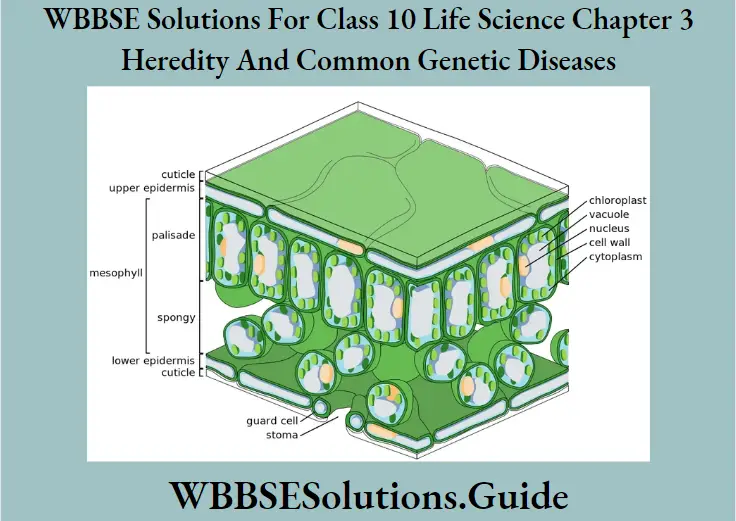
II. Lenticular Transpiration
The physiological process of water loss in the form of water vapor through the lenticels of woody stems and fruit walls is termed lenticular transpiration.
Structure of lenticel :
Lenticels are minute lens-shaped pores present in the secondary epidermis (periderm) of woody stem and fruit walls. They are constituted of a loose mass of complementary cells and intermediate air spaces. The minute opening of the lenticel always remains open because of the absence of guard cells.
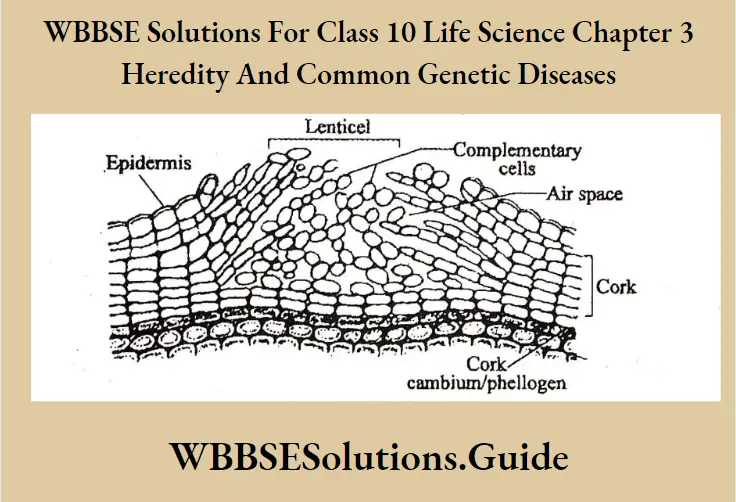
III. Stomatal Transpiration
The process of loss of water in the form of water vapor through the openings of stomata is termed stomatal transpiration. It accounts for 80-90% of transpiration in plants.
The stomata is a simple opening, guarded by guard cells, they have a sub-stomatal chamber surrounded by subsidiary cells.
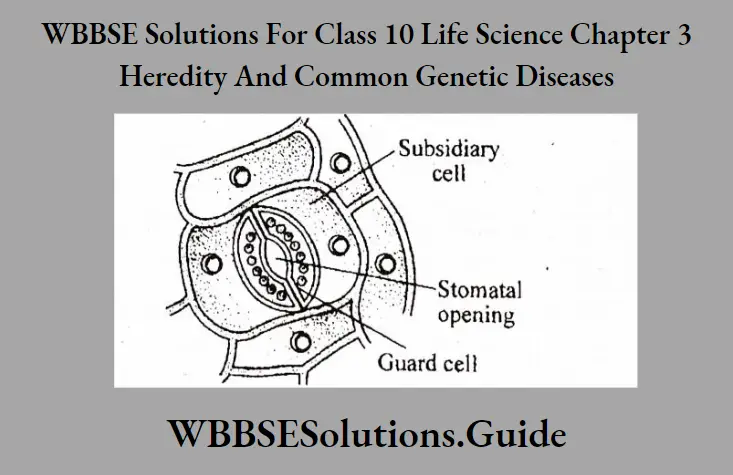
1. Distribution of stomata:
Stomata is present in the leaves, and also in the young stems, floral parts, and fruit walls of opening angiosperms except in submerged hydrophytes. It is also present in the leaves of pteridophytes and even in mosses.
Question 38. What are the beneficial and harmful effects of transpiration?
Answer:
Beneficial effects of transpiration :
[1] Ascent of sap :
By transpiration, water and minerals reach the top leaves of trees.
[2] Elimination of excess water :
By transpiration, excess water from the plant body is removed. It eases the physiological activities within the cells.
[3] Cooling plant body :
By this process, the latent heat of evaporation is lost from the plant body.
Harmful effects of transpiration :
[1] Drying of leaves and twigs :
Excess transpiration reduces water content in plant cells. As a result, leaves and softer parts of plants become dry.
[2] Wilting :
In case of excess transpiration, the cells lose turgidity and shrink. As a result, leaves and tender branches droop. This is called wilting. If the whole plant wilts and remains in that state for several hours, it may die.
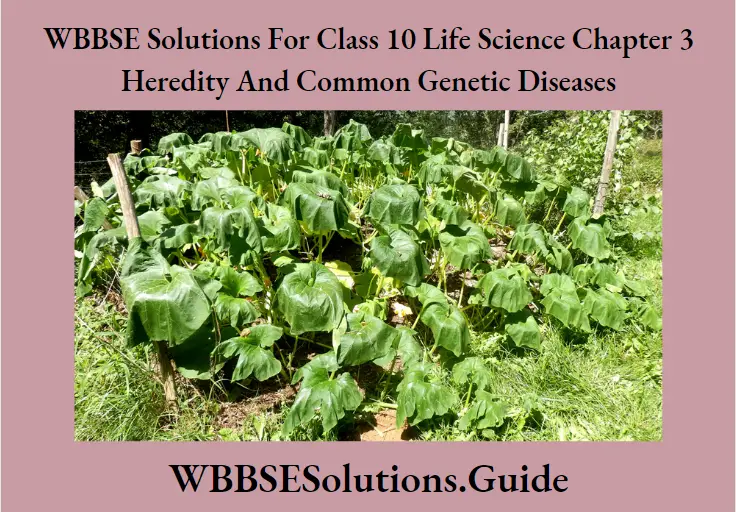
So, Curtis described the transpiration process as a “necessary evil” for the plants.
Question 39. Define plant circulation. Mention the medium of circulation.
Answer:
Plant Circulation :
The process by which the movement of food, water, and minerals takes place through the special conducting tissue like the xylem and phloem is called plant circulation.
The medium of circulation in plants is water.
Question 40. Differentiate between Diffusion and Osmosis.
Answer:
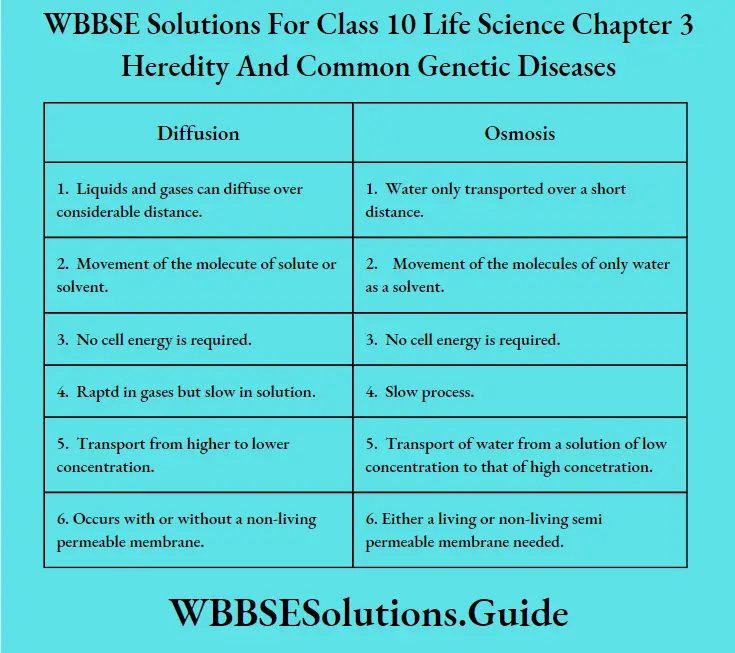
Question 41. Define active transport. Write the steps of active transport.
Answer:
Active Transport :
Active transport is the passage of a substance from its lower to higher concentration, using energy from the cell, through a living cell membrane. The transport of matter in the form of ions or molecules across the cell membrane utilizing metabolic energy is called active transport.
The process of active transport through carriers has the following steps —
It takes place against a concentration gradient, i.e., from lower to higher concentration. On the outer surface of the cell membrane substrate binds to the membrane protein carrier. The
carrier—substrate complex thus formed moves across the cell membrane. Reaching the inner surface of the cell membrane, the carrier substrate complex breaks. The molecules or ions are released and enter cells. The carrier returns to its original state and is free to accept other ions or molecules.
Question 42. Define the Ascent of Sap. Describe the factors affecting the ascent of sap.
Answer:
Ascent of Sap :
The transport of water and minerals from root to leaves through the xylem vessel, against the force of gravity is called the ascent of sap.
Factors:
(1) Root pressure :
The pressure develops in the roots due to the inflow of water, which helps in pushing the plant sap upward.
Root pressure is built up due to cell-to-cell osmosis in the root tissue. As one turgid cell presses the next cell, the force of the flow of water increases inward. When water
reaches the xylem vessels, it enters the pores of their thick walls with considerable force. Thus the root pressure is one of the forces to raise water through the stem into the leaves.
(2) Adhesion — Cohesion theory :
Water molecules remain attached by cohesive force and tend to adhere to the inner wall of the xylem vessel by adhesive force. The combined effect of these forces develops the continuation of water molecules in the xylem vessel, which extends from the roots to the stomata of leaves.
(3) Transpiration pull :
As the water is lost from the leaf surface by transpiration, more water molecules are pulled up due to the tendency of water molecules to remain joined and thus produce a continuous column of water through the stem.
Question 43. Write the concept of cell-to-cell transport.
Answer:
Concept of cell-to-cell transport
The process of transfer of water and other substances from one cell to another cell is called cell-to-cell transportation. It takes place by diffusion, osmosis, or active
transport methods.
Gases like O2 and CO2 move from one cell to another by diffusion process. Water passes by the osmosis process. Sugar is transported from the leaf to other parts by phloem tissue by
the active transport methods.
Question 44. Define translocation. Explain the mechanism of transportation of food in plants.
Answer:
Translocation :
The process of movement of water-soluble sugar from the leaves to other parts of the plant through phloem tissue is called translocation.
Mechanism :
Munch Mass Flow Hypothesis — According to Munch, leaves act as a source of food and have a higher concentration of food. From the leaves, it easily reaches the region of lower concentration with the help of diffusion pressure.
Various steps of translocation are —
(1) leaves as the supplying cells and the root as the receiving cells of any plant. The connecting link between leaves and roots can be represented by xylem and phloem tissue.
(2) Carbohydrates are continuously synthesized in mesophyll cells of leaves. The suction pressure of these cells increases, due to which water from adjoining cells is absorbed. This allows the movement of dissolved food into a sieve tube.
(3) Since the food is actively transported, it requires energy in the form of ATP. During active transport, a sieve tube of phloem tissue is located at the source (leaf) and unloaded at the sink (root) or consumption end.
Question 45. What are the types of Osmosis? What are the types of membranes?
Answer:
Types of Osmosis :
About any living cell, osmosis may be of two types—
(1) Endosmosis — The process by which the solvent molecules from outside enter into the cell, is known as endosmosis.
(2) Exosmosis — The reverse process of endosmosis which involves the exit of solvent molecules from the cell, is known as exosmosis.
Nature of membranes :
According to physical properties, the membranes are of three types.
(1) Permeable membrane—Such membrane allows all the molecules
or ions of a solution (both solute and solvent molecules) to pass through it, e.g., filter paper cell wall, etc.
(2) Semi-permeable membrane — Such membrane allows passage of water (solvent) molecules and positively charged hydrogen ions, but not the solute molecules nor the other positively charged and negatively charged particles, e.g., parchment
paper, air bladder of fish, egg’s membrane, etc. The semi-permeable membrane can be better termed as differentially permeable, which allows passage of some solutes, but holds back others at different rates of diffusion.
(3) Impermeable membrane — It does not allow either the solute or the solvent molecules to pass, e.g. rubber sheet, or plastic sheet.
A membrane that permits certain substances to pass through more easily than the other is said to be selectively permeable.
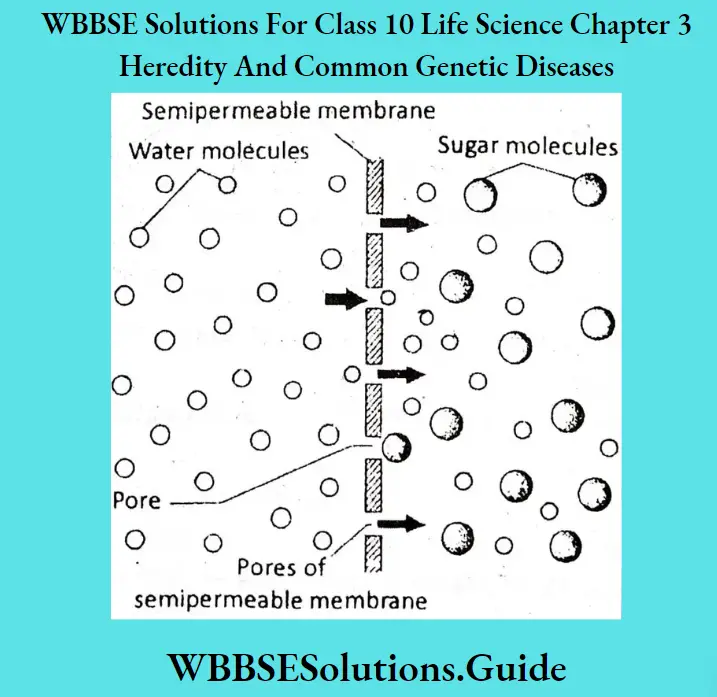
Question 46. Distinguish between upward circulation and downward circulation.
Answer:
Difference between Upward circulation and Downward circulation :
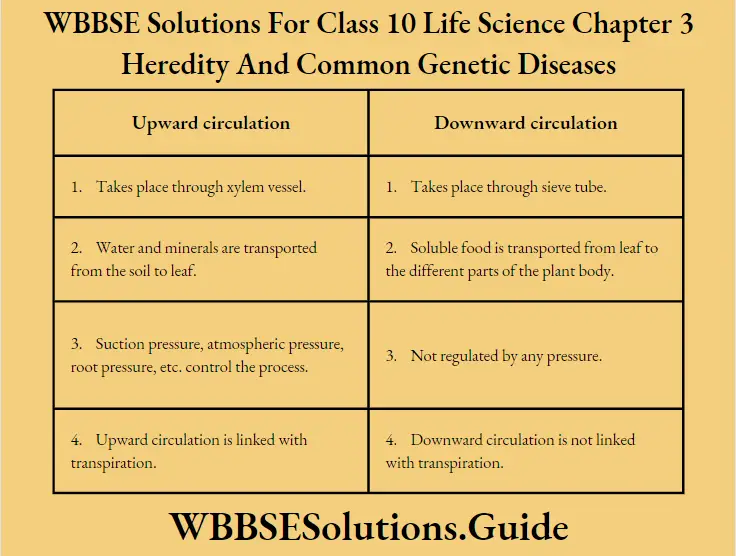
Question 47. Explain the movement of gases in plants.
Answer:
Movement of gases in plants
Photosynthesis in plants involves the intake of carbon dioxide and disposal of oxygen. During respiration plants use oxygen and give out carbon dioxide. In plants, there is no respiratorganizeriser: The elaborate liquid transport system cannot be used in the transport of gases. The leaves are well adapted to carry out gaseous exchange during photosynthesis. The rate of respiration in roots, stems, and leaves of plants is lower than that of animals. In the leaf and stem of plants the living cells are located close to the surface. The loosely arranged parenchyma cells with intercellular spaces in leaves, stems and roots provide an interconnecting system of air spaces. The diffusion of gases is faster through the air than through water. So diffusion of oxygen and carbon dioxide takes place rapidly through the interconnecting system of intercellular air spaces. These gases also pass through the cell wall and plasma membrane by a diffusion process. Aquaporin channels in the plasma membrane help in diffusion across the membrane.
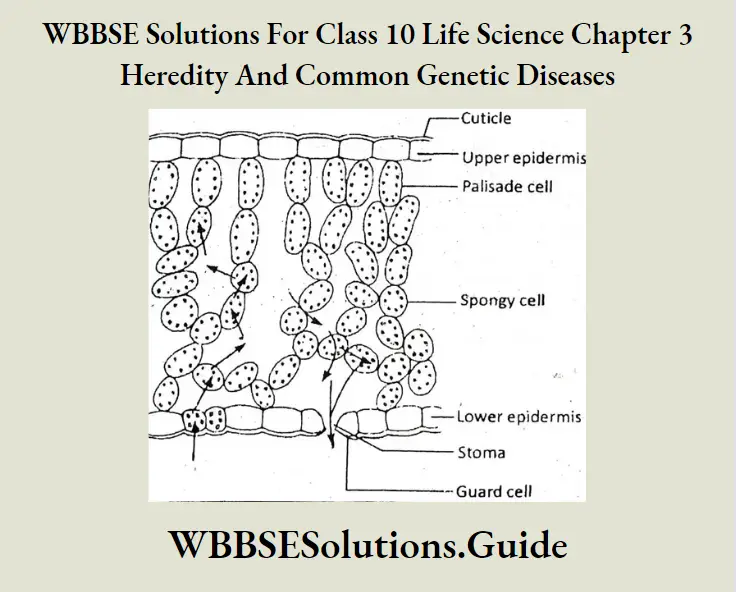
[1] Absorption of gases by leaves :
Gaseous exchange in leaves takes’ place through stomata when light falls on a leaf. These openings remain open in the morning and close during the night. This happens due to a change in the turgor of the guard cells. Guard cells possess a thick and elastic inner wall. When turgor develops the outer thin wall of the guard cell extends out forcing the inner walls into a crescent shape, resulting in the opening of the stomata.
Again, loss of turgor causes inner walls to regain their original shape resulting in the closing of stomata. During the day when osmotic pressure in the lower epidermal cells remains constant and the osmotic pressure of guard cells increases then the stomata open. In the evening stomata closes when the osmotic pressure of guard cells drops to nearly that of surrounding cells.
[2] Absorption of gases by Roots and Stems :
The dead cork cells present in mature roots and woody stems contain a waterproof substathathich makes the cork impervious to oxygen, carbon dioxide, and water.
Question 48. Explain the mechanism of cell-to-cell transport.
Answer:
Mechanism of cell-to-cell transport
The process of transfer of water & other substances from one cell to its neighboring cells, is known as cell-to-cell transport. This occurs either by diffusion or osmosis or by active transport.
[1] Diffusible materials like O2, CO2, etc. move from one cell to the next by diffusion.
[2] Water passes from one cell to another by cell-to-cell osmosis.
[3] Sugar is loaded into the phloem cells from the leaf cells by water-rich cells with means of active transport. Through this process, the food cell’s less water material is transported to all parts of the plant’s body.
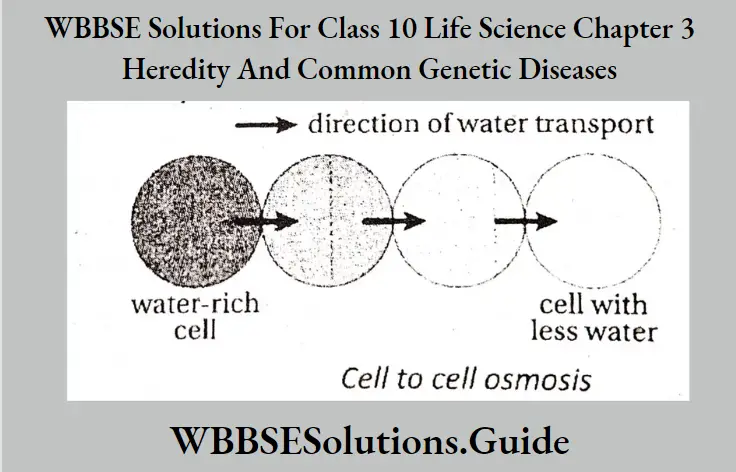
Question 49. What are the different steps in the ascent of sap?
Answer:
Steps in ascent of sap :
Transpiration is the process that acts as a driving force for the ascent of sap, from roots to the top of a tall tree via xylem elements. The sequence of events during the ascent of sap occurs in the following order.
[1] Evaporation of water through stomata, _”aspiration pull
[2] Lowering of turgor pressure of leaf cells.
[3] The cells uptake water from the xylem elements.
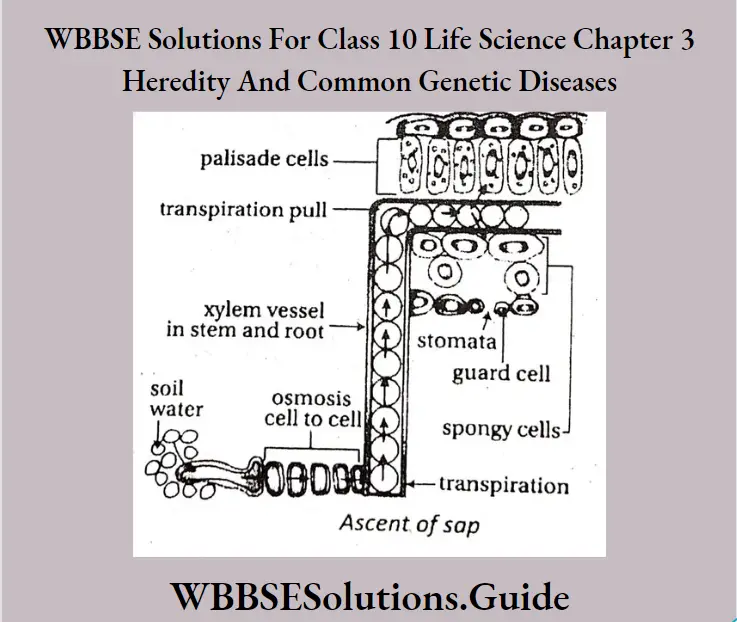
[4] The aylenivesel cohesive and adhesive forces of water molecules maintain the water column within the xylem vessels.
[5] Roots absorb water and minerals from the soil water cell to cell} spongy cells by transpiration imbibition and endosmosis, which Saran moves through the endodermis and reaches the xylem vessels. scent of sap
Question 49. Explain the process of transportation of food in plants.
Answer:
Transportation of food in plants :
Transportation of food in plants occurs through a sieve tube of phloem. Regarding the mechanism of this process, the pressure flow hypothesis by Ernst Munch is the most accepted one. According to this hypothesis, the following events occur during food transport in plants.
Transfer of food from mesophyll tissue to sieve tube :
In water and food mesophyll tissues, glucose produced by photosynthesis is soon converted into a larger sugar (sucrose). The sucrose solution is then transferred into the sieve tube via bundle sheath cells, phloem parenchyma, and companion cells by cell-to-cell transport.
Creation of pressure within the sieve tube :
With the entry of sucrose, the cytoplasm of the sieve tube becomes more dense. As a result, a concentration gradient develops between the sieve tube & neighboring xylem vessels. Due to this, water moves into the sieve tube from xylem vessels by osmosis, thereby, creating oc ’ additional pressure within the sieve tubes.
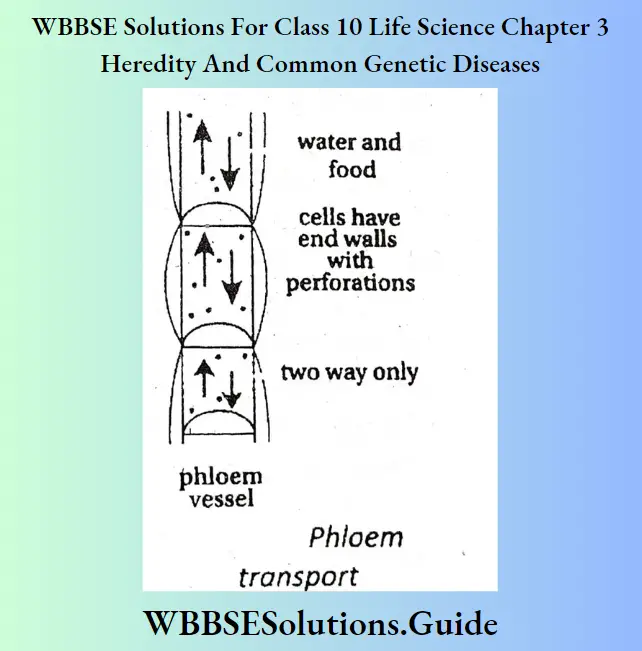
The flow of food :
This mounting pressure produced within the sieve tubes pushes the food solution down to different parts of the way only
the plant body. Finally, the sucrose solution enters into the tissue cells from the sieve tube. fiber According to another concept, some fin contractile protein fibril vessels
extend along the sieve tubes through the sieves. These fibrils contract and expand continuously to drive the food solution through a sieve tube.
Question 50. Mention the role of osmosis in plant circulation.
Answer:
Role of osmosis —
(1) Osmosis helps in the entry of water molecules from the soil into the root hair.
(2) The water molecules from the root hair cross the cortex of the root and come to the endodermis by the process called cell-to-cell osmosis.
(3) Osmosis is essential for making the cells turgid. Such turgidity is necessary for the enlargement of meristematic cells, growth of organ rigidity, and flaccidity of guard cells necessary for opening and closing of stomata.
(4) Osmosis in plants directly controls the dehiscence of other lobes, fruits, etc.
(5) Small weak herbs can stand erect due to an increase in turgidity of the cells in the stem by endosmosis.
(6) In unicellular organisms and simple multicellular ones, osmosis plays the most important role in the entry of water from the surroundings and the maintenance of water balance. (6) In higher animals, continuous exchange of water through osmosis takes place amongst blood, tissue fluid, tissue cells, and lymph in the capillary bed and this is very important in regulating the water balance in higher animals.
(7) Various plant movements are largely due to osmotic phenomena.
Question 51. Define transpiration. Mention the sites of transpiration.
Answer:
Transpiration :
The loss of water as water vapor from the aerial parts of the plant is called transpiration.
Transpiration is a very useful process for the plants for two reasons :
one, to get rid of the excess water absorbed, and two, for cooling the plant in hot weather.
Transpiration takes place in plants from three different regions :
(1) From the leaves through the stomata (Stomatal transpiration)
(2) Directly from the surface of the leaf and stem (Cuticular transpiration)
(3) From the lenticels which are the minute openings on the surface of the old stem (Lenticular transpiration).
Question 52. Name the factors controlling transpiration.
Answer:
(1) Temperature :
An increase in temperature allows more water to evaporate and a decrease in temperature reduces evaporation.
(2) Humidity :
Transpiration is reduced if the air outside is humid. High humidity in the air reduces the rate of outward diffusion of the internal water vapor across stomata, thereby reducing the rate of transpiration.
(3) Air movement (Velocity of wind) :
Transpiration increases with the velocity of the wind. If the wind blows faster, the water vapor released during transpiration is removed faster.
(4) Light :
During the day, the stomata are open to facilitate the. inward diffusion of CO, for photosynthesis. During the night they are closed. Therefore, more transpiration occurs during the day.
(5) Structure of leaf :
Narrow leaves, fewer stomata, rolled or folded leaves, and covering of leaves through the cuticle and sunken stomata reduce the loss of water in the transpiration process.
Question 53. Mention the significance of transpiration.
Answer:
(1) Elimination of excess water from the plant body.
(2) Evaporation reduces the temperature of the leaf surface and causes a cooling effect in hot summer days.
(3) Transpiration helps in the ascent of sap by producing a suction force acting from the top of a plant.
(4) It helps in the distribution of water and mineral salts throughout the plant body. The higher the rate of transpiration, the greater the rate of absorption of water and solute from the soil.
Question 54. Write three differences between Evaporation and Transpiration.
Answer:
Differences between Evaporation and Transpiration
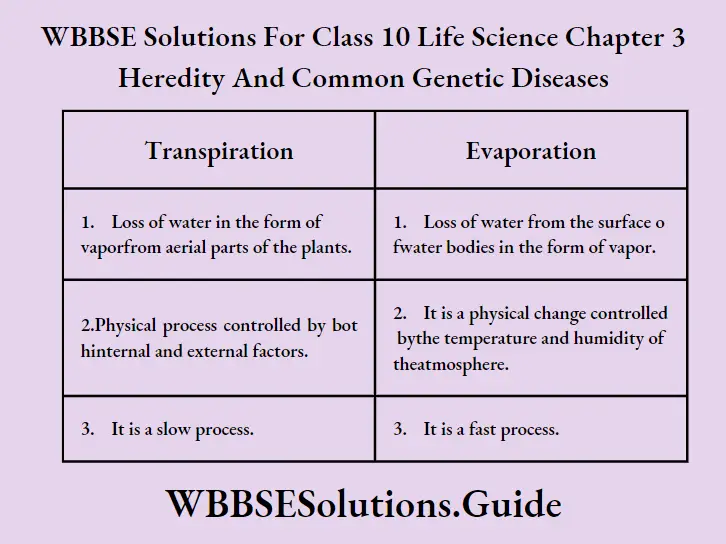
Question 55. Define antitranspirant, guttation, and bleeding.
Answer:
Antitranspirants
Antitranspirants are physical or chemical agents that help in reducing excessive loss of water by keeping stomatal pores closed, eg.-plastic film, wax emulsion, aspirin, and dimethyl silicon.
Guttation :
Loss of water in the form of water droplets along the margin of the leaf in the morning is called guttation. It takes place through the Aydathodes.
Bleeding :
The plant sap bleeds from the ruptured or cut surfaces of the plant. The root pressure generated by a plant assists in bleeding.
Question 56. What do you mean by “Ascent of sap”? What is the relation between transpiration and the ascent of sap?
Answer:
(i) Ascent of sap:—
The upward movement of water along with dissolved mineral
elements through the xylem vessels from root to leaf is known as the ‘Ascent of Sap’.
(ii) Relation between transpiration and ascent of sap:—
Transpiration:-
The loss of water in the form of water vapor from the aerial parts of the plant’s body is called transpiration.
Ascent of sap:-
The upward movement of sap from the root xylem to leaf mesophyll tissue through the stem xylem is called ascent of sap.
Relation:-
The ascent of sap supplies the raw material to the process of transpiration and transpiration provides a chance for the happening of ascent of sap. Thus both these processes are complementary to each other. The more the transpiration, the more absorption and ascent of sap.
Question 57. What is Circulation? Discuss how water reaches into the leaves from the roots in a plant body.
Answer:
(1) Circulation:—
The transfer of nutrients, gases, excretory products, hormones, etc. from one part of the living body to another part of the living body through a liquid medium is called circulation.
(2) Method of reaching water from root to leaves in a plant body:—
The process by which water moves upwards from root to leaf is called the ascent of sap.
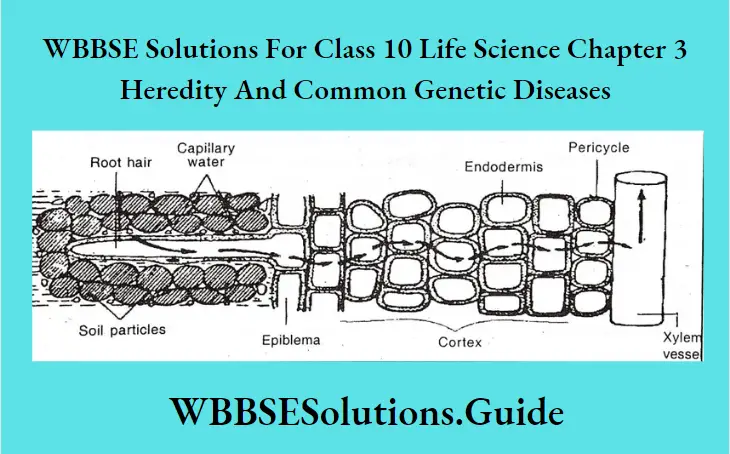
Many theories were put forward by various scientists from time to time but the “Cohesive adhesive force and transpiration pull theory” as proposed by Dixon and Jolly in 1894 is the most acceptable.
The cohesive force exists between two water molecules within xylem vessels. This force keeps the water column unbroken within xylem vessels.
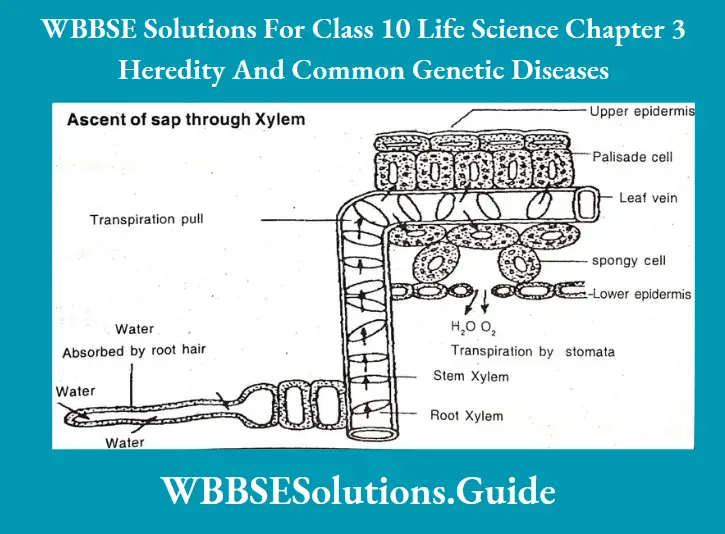
The adhesive force exists between the water column and the wall of the xylem vessel. The water present within intercellular spaces of mesophyll tissue is changed in the vapor by the process of transpiration. This phenomenon creates a pull in the water column of the xylem vessel. This pull acts from the upper part to the lower part of the column. So its effect is first realized by the water present in the leaf xylem then the stem and the last at the root xylem. Thus water uplifts and continues till the process of transpiration is in action.
“Heredity and Common Genetic Diseases WBBSE Class 10, short answer questions, with solutions”
Question 58. What is transpiration? What are the various factors which influence transpiration?
Answer:
Transpiration:—
The process of loss of water in the form of water vapor from the internal tissue of aerial parts of plants is known as transpiration.
Factors influencing transpiration:—
There are various factors which affect the rate of transpiration.
These factors are divided into two groups:—
1. External factors:—
(1) Light:—
Light is most important for the opening and closing of stomata. In the daytime, due to the presence of light, the stomata remain open and transpiration of water takes place normally. At night the stomata remain closed and consequently, the transpiration is checked. Thus the rate of transpiration increases in light and decreases in darkness. Light also affects transpiration by increasing the temperature of the leaf surface.
(2) Temperature:—
Temperature shows a direct effect on transpiration. Due to the rise of temperature, the relative humidity of the air decreases and then there will be an increase in the rate of transpiration. If temperature is low then there will be a decrease in the rate of transpiration.
(3) Humidity of air:—
There is an increase or decrease in the rate of transpiration according to whether the air is dry or moist. If the atmosphere is dry there will be more transpiration.
(4) Wind:—
During high velocity of wind, the transpiration becomes very active because the water vapors are instantly removed and the area around the transpiring surface is not allowed to become saturated. During a slow breeze, the water vapors are not so quickly removed, which reduces the rate of transpiration.
(5) Atmospheric pressure:—
The rate of transpiration increases due to a decrease in atmospheric pressure.
(6) Soil water:—
The rate of transpiration increases due to an increase in the quantity of capillary water in the soil.
2. Internal factors:—
(1) Presence of cuticles on the leaf surface:— The rate of transpiration decreases due to the presence of a cuticle layer on the surface of the leaf.
(2) Number of stomata:—
Several stomata directly affect the rate of transpiration. If the number of stomata is less, the rate of stomata will be low.
(3) Leaf area:—
There will be more water loss from a plant having a larger leaf area than a smaller area.
(4) Leaf structure:—
The structure of the leaf controls the rate of transpiration. In
xerophytes (ex. cactus) the rate of transpiration is low due to the modification of the leaf into the spine.
(5) Hormones:—
Cytokinin controls the opening and closing of stomata. This affects the rate of transpiration.
Question 59. Describe the experiment to measure the rate of transpiration by Ganong’s photometer.
Answer:
Ganong’s photometer:—
In this apparatus, there is a horizontal capillary tube which is graduated. One end of this tube is bent downward and at the lower end of this bent tube, there is a hole inside the wall, through which an air bubble can be introduced. The other end of the horizontal tube opens into another horizontal but wider tube that is bent upward to end in a smaller bell jar for holding the plant twig. The broader horizontal tube is also connected by a vertically raised water reservoir funnel which is provided with stop-cock in the connecting tube to control the water supply.
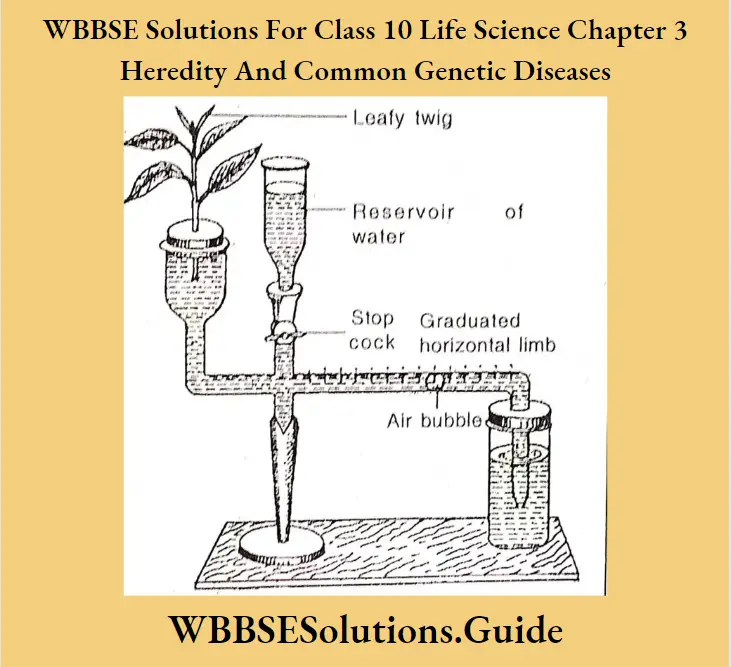
Method:—
In the beginning, water is a Demonstration of the rate of transpiration filled in all parts of the tubes by opening by Ganong photometer the stop-cock of the water reservoir. A plant twig is fixed in a one-holed rubber stopper, the latter being fixed to the end of the broad mouth in an air-tight manner. The lower bent end of the capillary. the tube is immersed in a beaker of water. At this point, water should fill all the horizontal tubes, the vertical cup tube containing twigs, and the capillary tube, and the stop-cock of the water reservoir is now closed. An air bubble is introduced through the hole of the downward-bent tube end. As the plant loses water by transpiration, it exerts a suction force, so the bubble moves forward. The number of divisions in which the air bubble travels in a limited time gives an idea of the rate of transpiration.
Chapter 3 Physiological Processes Of Life Respiration
Question 60. What is meant by the release of energy during respiration?
Answer:
Release of energy during respiration
The sun is the ultimate source of energy. Its solar energy is transformed into potential chemical energy by green plants during the process of photosynthesis. The potential chemical energy is stored within glucose which is a product of photosynthesis. We obtained energy from the food.
The simple forms of food like glucose, amino acids, fatty acids, etc. are oxidized within the cell. The potential chemical energy of food is transformed into kinetic energy by the process of respiration. Some part of this energy is stored within ATP molecules. Living organisms use the energy which is stored within ATP as per their requirement. Some part of chemical energy is also transformed into heat energy which is necessary for keeping our body temperature constant. A part of chemical energy is converted into light in some animals, like glow worms. In some animals, the chemical energy of food is converted into electricity.
Example — Electric ray fish.
Question 61. Glucose produced during the time in plants is stored in which form and where in the plant body? Why does that occur?
Answer:
(1) Glucose produced during the time in plants is stored in the form of assimilatory starch in leaves. During night the Glucose is stored in the form of permanent starch in the root cells.
(2) Reason:-
Glucose is produced by the process of photosynthesis during day time. It is soluble in water. Its high concentration reduces the rate of photosynthesis.
To avoid this condition, soluble glucose is converted into insoluble starch grains temporarily in mesophyll cells in the presence of the element potassium. This starch is called assimilatory starch. During the night, the assimilatory starch of mesophyll cells is converted into. soluble glucose and translocated to storage organs like root or stem through the sieve tube of phloem. Here soluble glucose is transformed into permanent insoluble starch with the help of amyloplast or leucoplast.
In many plants permanent starch is formed in storage tissue like the cortex or r pith or endodermis or in special organs like tubers and rhizomes.
Question 62. Discuss anaerobic respiration with an example.
Answer:
Anaerobic respiration
The process of respiration which occurs in the absence of free oxygen in the cytoplasm of a cell in the presence of enzymes comparatively less amount of energy is released, called anaerobic respiration.
Example — Tapeworm, Yeast.
Question 63. Write any three differences between photosynthesis and respiration.
Answer:
Differences between photosynthesis and respiration
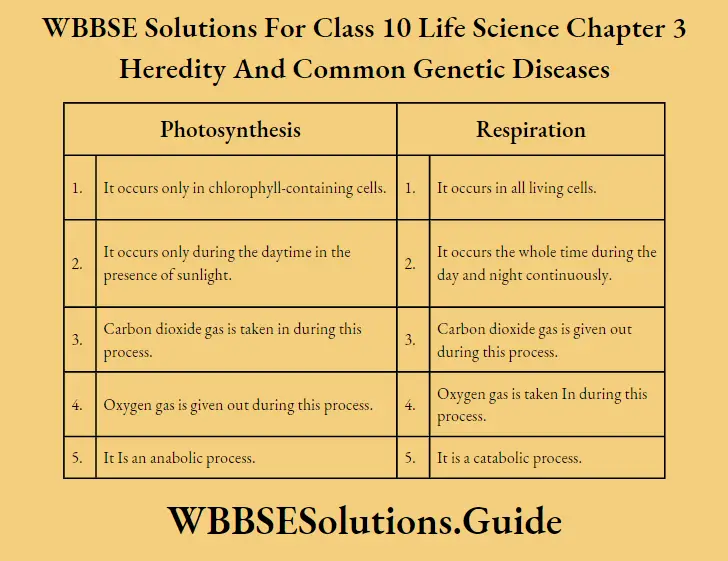
Question 64. Discuss the significance of Respiration.
Answer:
Significance of Respiration:-
(1) Release of energy:-
The potential chemical energy of food is transformed into kinetic energy by which different organs of the body work. Some quantity of this energy is stored in ATP and some quantity is used to keep body temperature normal.
(2) Maintain the balance of O, and CO2 in the environment:-
During respiration, living beings take O2 gas and give out CO2 gas, while during photosynthesis green plants take CO2 gas and give out oxygen gas. So, by the combined action of respiration and photosynthesis, the balance ofO2 and CO2 is maintained in the environment.
Question 65. What is respiration? Write two differences between aerobic and anaerobic respiration. What is meant by “release of energy takes place in respiration”?
Answer:
(1) Respiration:—
The catabolic reaction _ which occurs continuously within all living cells oxidizes food substances and changes the potential chemical energy of food into kinetic energy
is called respiration.
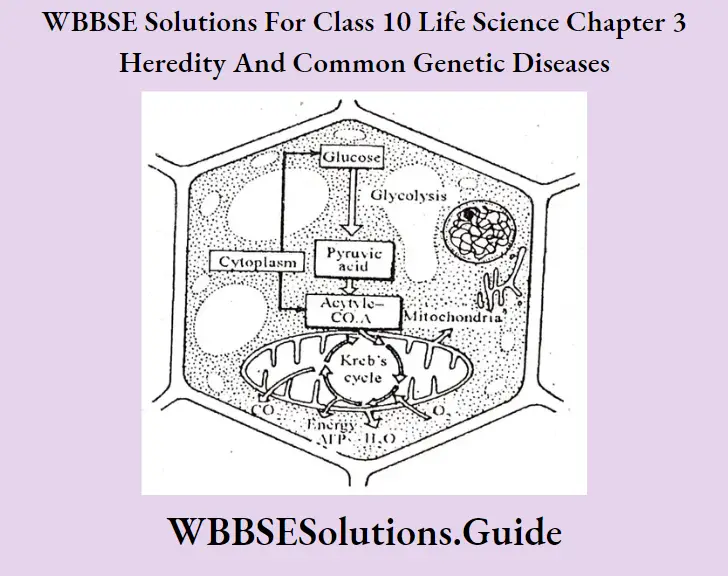
Equation:-
(2) Difference between aerobic and anaerobic respiration:—
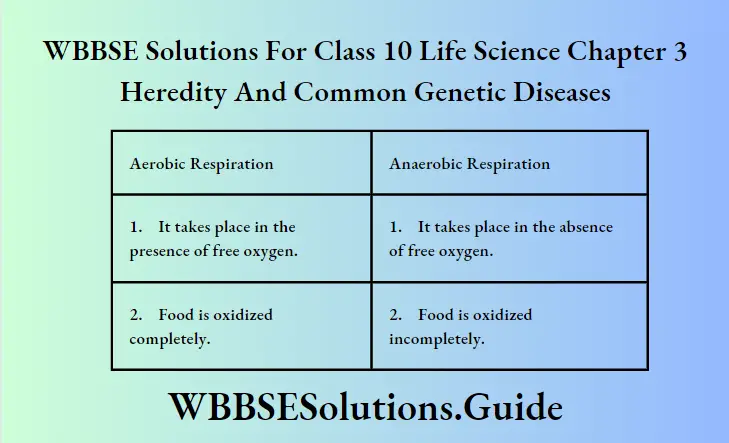
(3) “Release of energy takes place in respiration” —
Every living organism requires energy to perform various life– continuing activity. They obtain energy from the food. Food contains chemical energy which is the transformed form of radiant energy. Now the process of respiration changes this potential chemical energy into kinetic energy. in the form of ATP molecules. The conversion of potential chemical energy of
food into kinetic energy which is used by organs is the meaning of release of energy.
Question 66. Wherefrom do organisms get the oxygen necessary for their respiration? Discuss the importance of respiration in maintaining O2— CO2 balance in the atmosphere. Mentioning the environment of each write the names of the animals in which the gill and trachea act as respiratory organs
Answer:
(1) They get oxygen necessary for their respiration from their respective environment, i.e., aquatics from water and terrestrials from atmospheric air.
(2) Importance of respiration in maintaining O,- CO, balance in the atmosphere:-
The percentage of oxygen gas and carbon dioxide gas in the atmosphere is 20.60% and 0.03% respectively. The living organism takes in oxygen and gives out carbon dioxide during respiration, but green plant during day time takes in CO2 and give out O2 during photosynthesis. Thus we see that these two biological processes by their combined action maintain the balance of O2 and CO2 in the atmosphere.
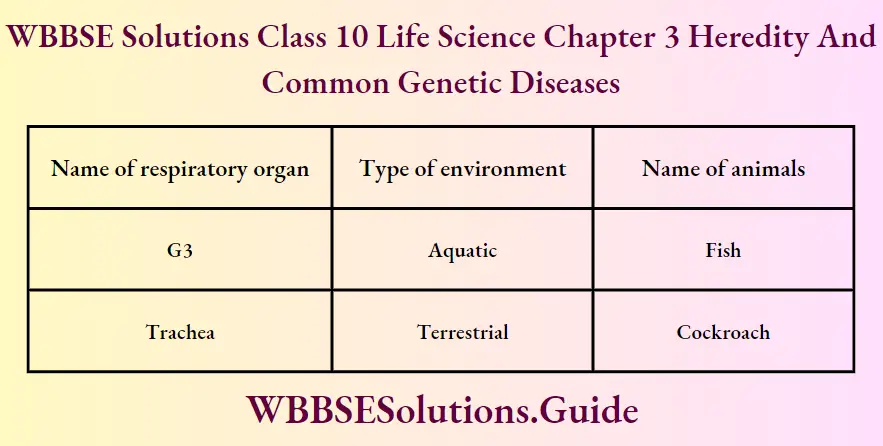
Question 67. Mention any two differences between photosynthesis and respiration. Explain the main two ways by which the living world benefits due to respiration. Wherefrom do fully submerged plants take oxygen for respiration?
Answer:
(1) Two differences between photosynthesis and respiration:
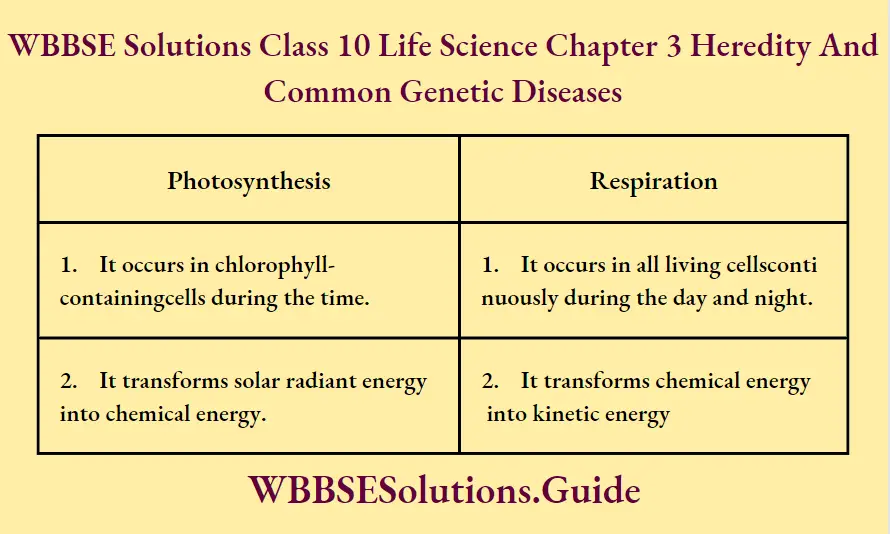
(2) Benefit obtained by respiration:—
(1) Release of energy:—
The chemical energy of the food is transformed into kinetic energy by the process of respiration. This kinetic energy is used by organs of the body to continue life.
The heat which is produced during this process is essential to keep our body temperature normal.
(2) Maintenance of O2—CO2 balance in the environment:— Oxygen gas is taken in and carbon dioxide gas is given out during respiration but during photosynthesis carbon dioxide gas is taken in and oxygen gas is given out. Thus the process of respiration takes part in the balance of O2-CO2 in the environment.
(3) From the water.
Question 68. How do photosynthesis and respiration take place simultaneously in green plants under the sunlight? Discuss the importance of respiration in maintaining O2
Answer:
(1) Way of occurrence of photosynthesis and respiration simultaneously in green plants under the sunlight:- Photosynthesis takes place within the chloroplast. Plants get CO2 from air and water from the soil. Glucose, water, and oxygen gas are produced as end products. Respiration takes place within the cytoplasm and mitochondria. Glucose and oxygen are its raw materials. Plants get these materials from the cell because they are produced during photosynthesis. CO2 and H2O are end products of respiration. These are utilized by plants for photosynthesis.
Thus we see that by supplying raw materials for each other, these processes occur smoothly in green plants under the sunlight.
(2) Importance of respiration in maintaining O2—-CO2 balance in the atmosphere :—
The percentage of oxygen gas and carbon dioxide gas in the atmosphere is 20.60% and 0.03%-—0.04% respectively. The living organism takes in oxygen and gives out carbon dioxide during respiration, but green plant during day time takes in CO2 and give out O2 during photosynthesis. Thus we see that these two biological processes by their combined action maintain the balance of O2 and CO2 in the atmosphere.
(3) Name of the respiratory organ in prawn – Gills.
Question 69. What is aerobic respiration? What is the difference between breathing and respiration?
Answer:
(1) Aerobic Respiration:-
The complete oxidation of food which occurs continuously within living cells, cytoplasm, and mitochondria in the presence of free oxygen to produce carbon dioxide, water, and 686 KCal energy is called aerobic respiration.
Equation:-
(2) Difference between breathing and respiration:-
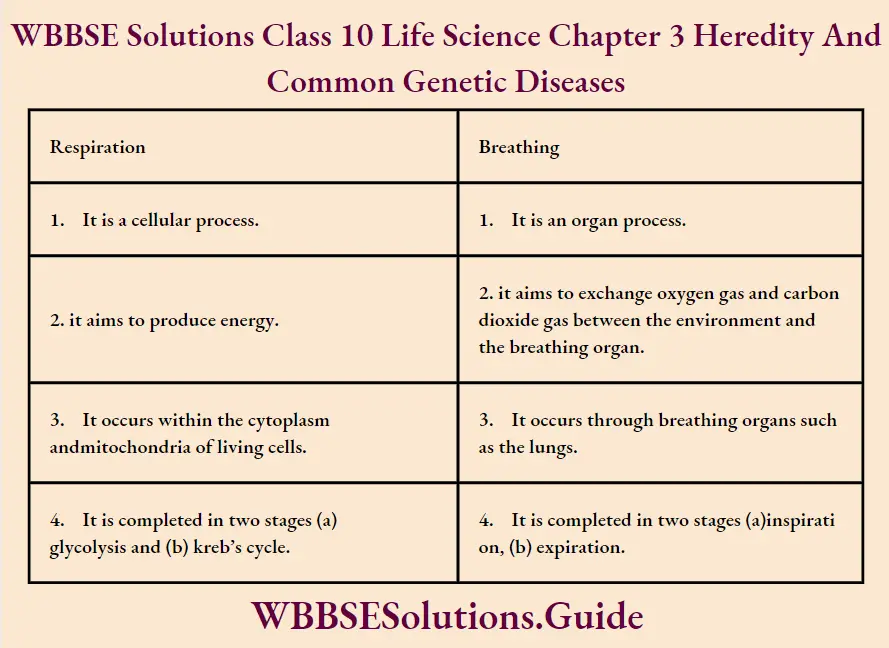
Question 70. Where does aerobic respiration take place in a cell? Name the chief respiratory organs of Amoeba, Cockroaches, Tadpole, and a bird. Through which part of plant body exchange of respiratory gases take place in case of fully merged aquatic ones?
Answer:
1. Place for aerobic respiration:—
(1) Cytoplasm,
(2) Mitochondria.
2. Name of respiratory organs:—
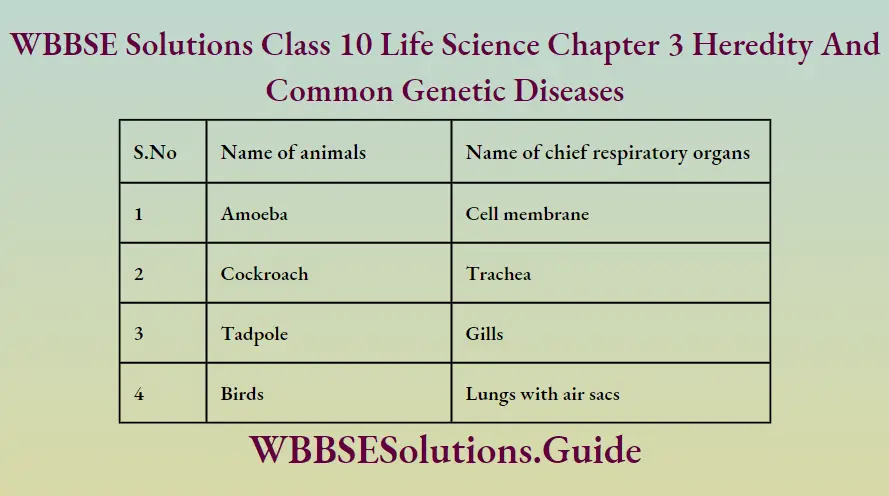
3. From all the parts of the plant body exchange of respiratory gases takes place in the case of fully merged aquatic ones.
Question 71. What is Respiration? How is it related to nutrition? Mention three main types of respiratory organs in animals.
Answer:
(1) Respiration:—
The catabolic reaction that occurs continuously within all
living cells to oxidize food substances and to change the potential chemical energy of food into kinetic energy is called respiration.
(ii) Relation between respiration and nutrition:—
Respiration :
The oxidative breakdown of substances in living cells to release energy is called respiration
Nutrition :
The total of processes like ingestion, digestion, absorption, assimilation, and egestion is called nutrition.
Relation:-
The process of nutrition supplies the raw materials such as glucose, amino acid and fatty acid for respiration and respiration liberates energy which is necessary for nutrition. Thus both these processes are complementary to each other.
(3) Name of three main types of respiratory organs:—
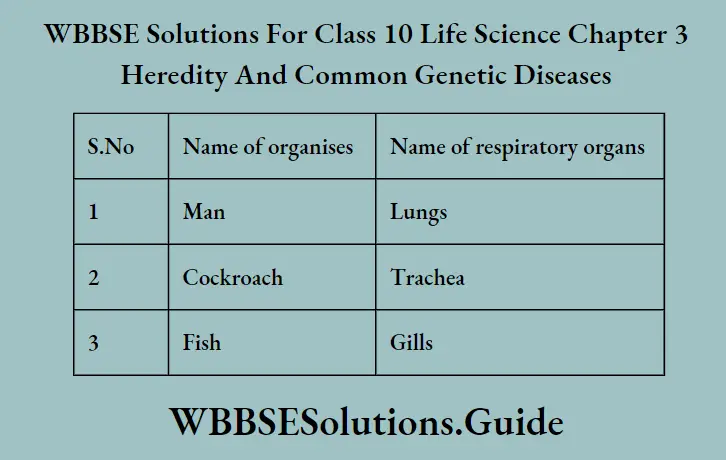
Question 72. Write three differences between anaerobic and aerobic respiration. Give two examples of fermentation.
Answer:
(1) Difference between anaerobic and aerobic respiration.
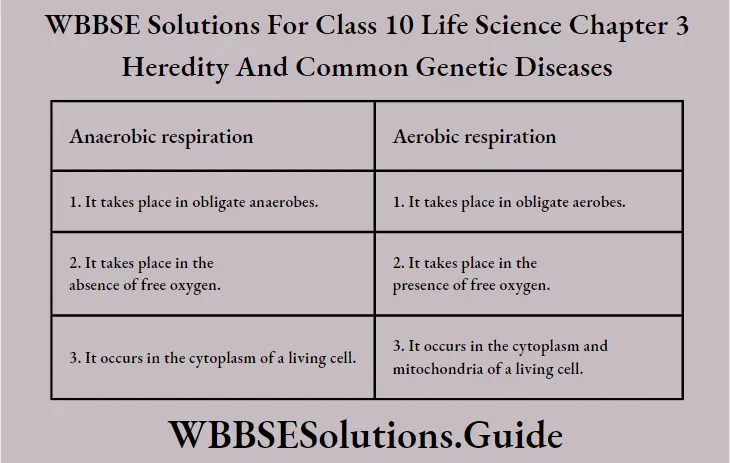
(2) Two examples of fermentation :
(1) Alcoholic fermentation.
(2) Lactic acid fermentation.
Question 73. Where and when does respiration take place in a cell of a living body? Define aerobic and anaerobic respiration.
Answer:
(1) Place – Respiration takes place within the cytoplasm and mitochondria of a living cell.
(2) Time – It takes place day and night continuously.
(3) Aerobic Respiration:—
The complete oxidation of food which occurs continuously within living cells, cytoplasm, and mitochondria in the presence of free oxygen to produce carbon dioxide, water, and 686 KCal energy is called aerobic respiration.
Equation –
(4) Anaerobic respiration:-
The incomplete oxidation of food which occurs continuously within living cells” cytoplasm in the absence of free oxygen to produce ethyl alcohol, CO2, and energy in plant cells but lactic acid and energy in animal cells is called anaerobic respiration.
Equation –
Question 74. How does aerobic respiration differ from anaerobic respiration? Mention two practical applications of alcoholic fermentation.
Answer:
(i) Difference between aerobic and anaerobic respiration:-
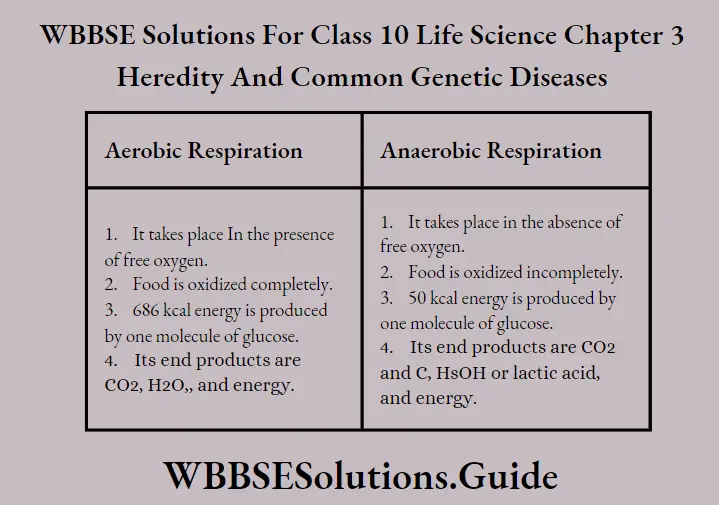
(ii) Practical application of alcoholic fermentation:-
(1) It helps in the production of ethyl alcohol. This alcohol is used in the production of medicine and alcoholic beverages.
(2) It also helps in the formation of double bread.
Question 75. What type of metabolic process is respiration? Why is it essential for living organisms? Write two practical importance of fermentation. What is the respiratory organ of grasshopper?
Answer:
(1) Respiration is a catabolic type of metabolic process.
(2) Respiration is essential for living organisms because it transforms the potential chemical energy of food into kinetic energy which is used by different organs and metabolic
reactions to continue the life of living organisms.
(3) Practical application of fermentation:-
(1) It is useful for the preparation of curd and vinegar.
(2) It is used in the preparation of biscuits and double bread.
(3) It is used in the preparation of ethyl alcohol.
(4) The trachea is the respiratory organ of grasshoppers.
Question 76. How are respiration and breathing interrelated?
Answer: Respiration is a cellular continuous process. Glucose, amino acids, fatty acids, and oxygen are its raw materials. They reach cells by the process of circulation.
The taking in of oxygen and giving out CO2 by them is breathing. This process occurs between the breathing organ and the environment of living. Oxygen gas reaches within the breathing organ through the process of breathing (Inspiration). This gas mixes with blood and reaches to cell by the process of circulation. Thus breathing supplies oxygen gas for the process of respiration. It also removes CO2 gas which is produced during the process of respiration.
Question 77. What are respiratory organs? Discuss their characteristics.
Answer:
Respiratory organs
Respiratory organs are the special type of organs that help in the process of exchange of gases, i.e., O2 and CO2 between the environment and the organism.
Characteristic features of respiratory organs:
(1) The respiratory membrane must be thin and permeable so that there is easy gaseous exchange.
(2) The respiratory surface must be extensive to provide a greater surface area for gaseous exchange.
(3) The respiratory organ must be always kept moist to facilitate the diffusion of gases.
(4) In higher animals, the respiratory organ is highly vascularised so that blood can transport respiratory gases—O2 from respiratory organs to different cells of the body
and vice versa for CO2.
Question 78. Explain the common respiratory sites in plants.
Answer:
Common respiratory sites in plants are as follows :
1. Stomata :
These are microscopic apertures in the leaf epidermis of plants, guarded by two guard cells. Stomata are generally present on the ventral surface in dicot plants and both on the dorsal and ventral surface in monocot plants. Through the opening of stomata gaseous exchange takes place.
2. Lenticels :
Lenticel is a porous tissue consisting of cells with large intercellular spaces, generally on the bark of woody stems of dicot plants. It functions as a pore that provides a pathway for the direct exchange of gases between the internal tissues and atmosphere through the bark. (Tough thick bark is otherwise impermeable to gases).
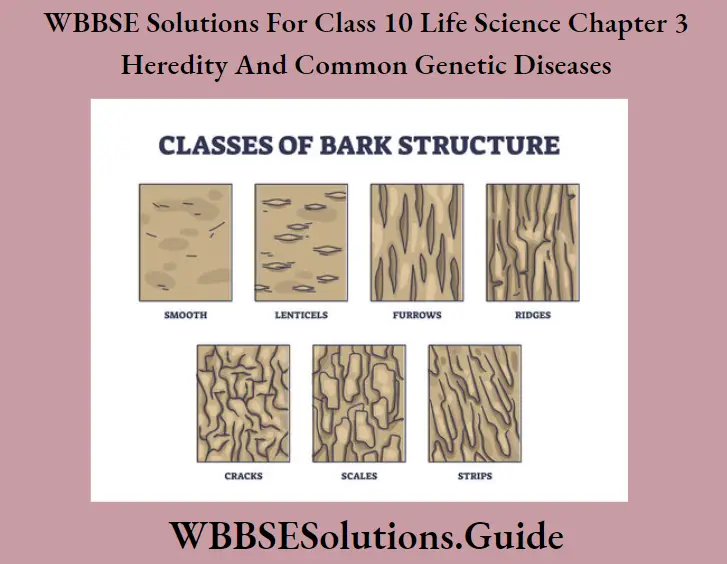
3. Pneumatophores :
These are breathing roots, found in mangrove trees and they are negatively geotropic adventitious branches of the root. In fact, in saline soil, the capillary space of the soil is almost blocked by a huge deposition of NaCl. So there is less capillary air, hence the root suffers from O, deficiency. So, some of the adventitious roots bend upward and come above the soil surface to absorb O2 directly from the air, e.g. pneumatophores in Sundri Plant.
Question 79. Discuss the various respiratory organs of animals.
Answer:
Various respiratory organs of animals
Introduction :
Usually, respiration in different animals is performed by the definite organs called respiratory organs In lower animals, the exchange of gases takes place through the body surface, whereas in higher animals, there are complex organs like trachea, lungs, etc. The following is a brief account of the different types of respiratory organs found in different animals.
1. Body surface :
In the case of aquatic animals like Amoeba, Sponges, Paramoecium, Hydra, etc. exchange of gases between cells and their environment takes place by simple diffusion through the cell membrane (body surface).
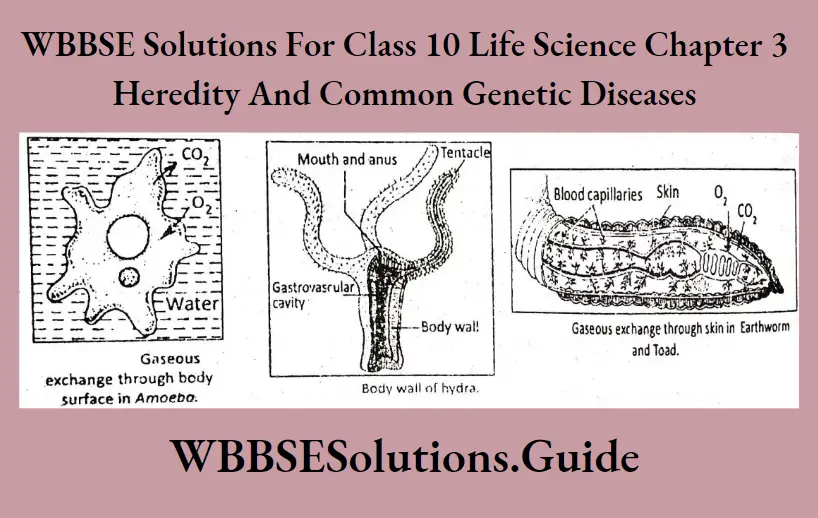
2. Skin :
Terrestrial animals like earthworms, leeches, etc. respire partly or wholly through thin and highly blood-supplied moist skin.
3. Trachea :
Insects and varieties of arthropods have elaborate networks of air-filled tubes called tracheae which open onto the body surface through the small pores called spiracles or stigmata. The trachea branches repeatedly into tubes called tracheoles through which gaseous exchange takes place.
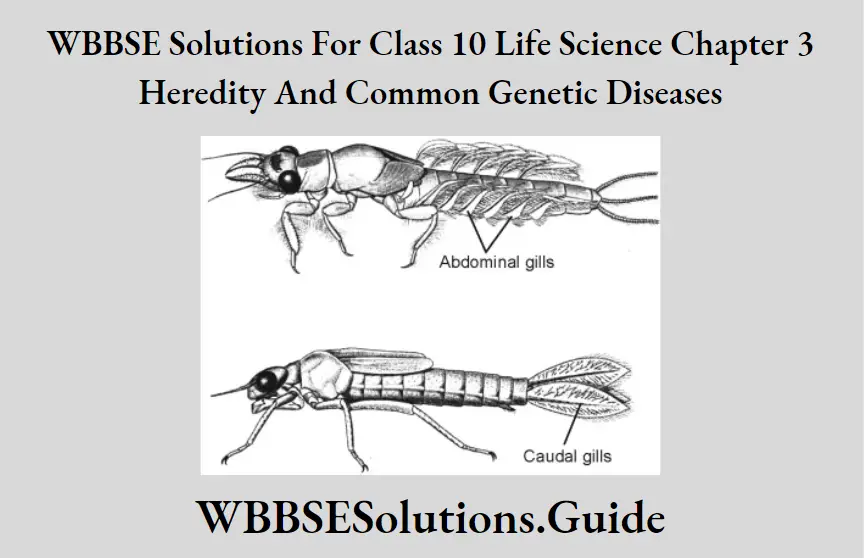
4. Gills :
In aquatic animals like fishes, the external respiration takes place through gills. These are specialized structures dark red, provided with thin walls and blood capillaries that favor easy diffusion of gases between dissolved O2 in water and the circulating blood passing through them. The actual site of gaseous exchange in fish is the gill lamella of the gill filament.
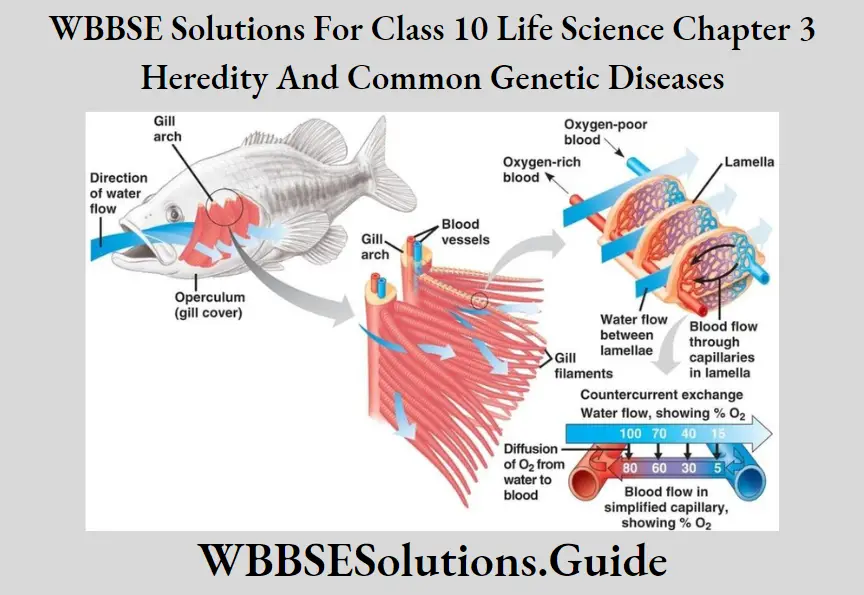
Accessory respiratory organs :
The organs that partly accomplish respiration and are additional complementary respiratory structures are called accessory respiratory organs (other than gills). Some jewel fishes like Koi, Magur, and Singhi are provided with these organs.
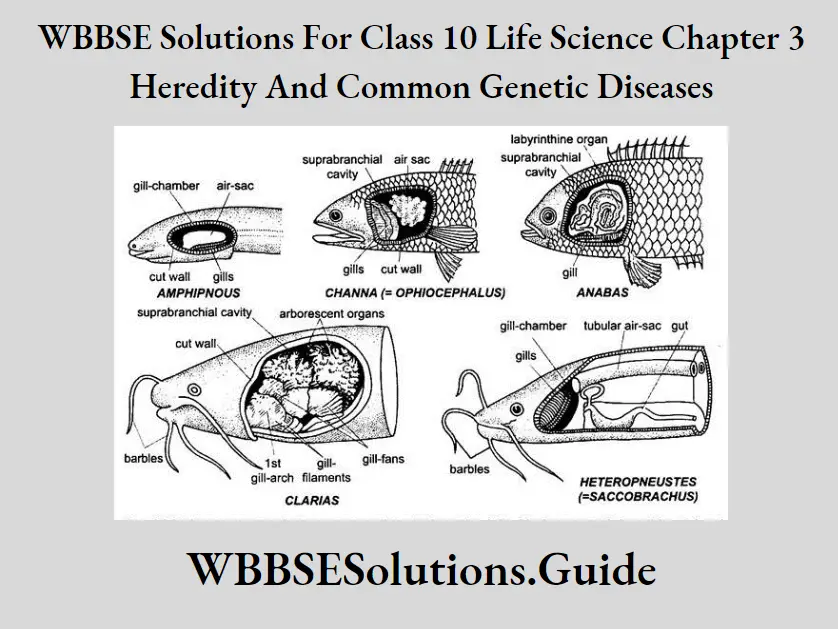
Accessory respiratory organs develop in addition to the normal pharyngeal gills, to help the fish live in aquatic environments with low oxygen concentration or to breathe
oxygen directly from the air, aestivate over prolonged droughts during summer, and meet extra demand for oxygen. However, accessory respiratory organs in fishes can perform gaseous exchange so long as they remain moist. Gills are incapable of utilizing oxygen in the air, so accessory respiratory organs are useful adaptive features of some fishes. Those that possess these adaptive features are called jellyfish.
6. Lungs :
Lungs are the specialized respiratory organs of all land vertebrates, e.g. birds (pigeons), reptiles (lizards, snakes), amphibians (frogs, toads), and mammals (rats, cows). [eects The aquatic mammals (e.g. whale, dolphin) are also provided with lungs. That is why | so” some animals (Whale, Dolphin, Crocodile) | senay— AS often come above the surface of the water for |°°” S\N aerial respiration.
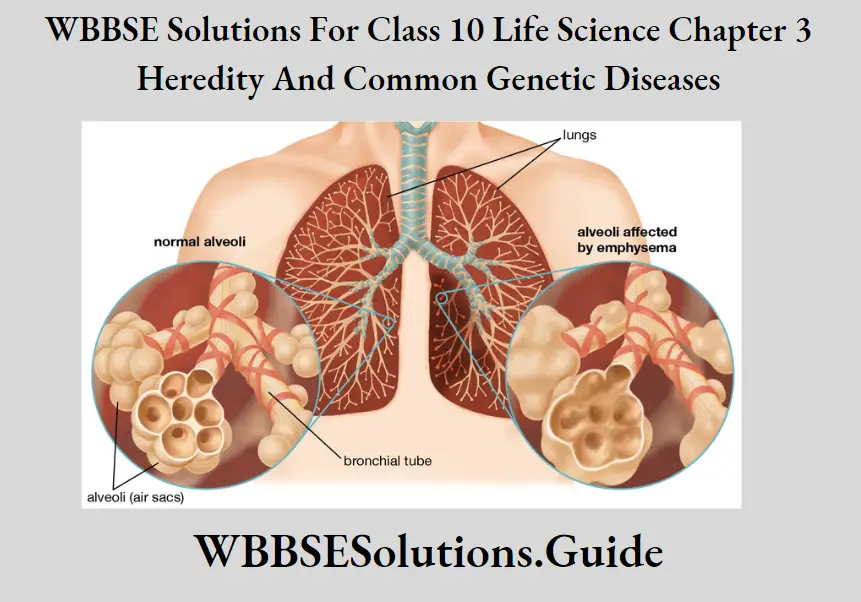
The lungs of amphibians reptiles and mammals are paired sac-like spongy foPe contact with other structures due to the presence of air-filled alveoli. Alveoli are provided with numerous blood vessels (capillaries) for gaseous exchange. The lungs of pigeons are more compact and are supplemented by. thin-walled 9 air sacs for storage.of air that also helps to increase buoyancy.
Question 80. Discuss the concept of cellular respiration.
Answer:
Concept of cellular respiration
What is Cellular Respiration? Cellular respiration is the oxidative, catabolic, enzymatic breakdown of organic substances when potential energy is released in the form of kinetic energy.
C6H12O6+6O2 __ Enzymes , 6CO2 + 6H2O + energy
All organisms require energy to maintain the vital function of the body. This energy is derived from the food they take. During photosynthesis, solar energy is fixed in food as potential chemical energy. This food is used as a cellular respiratory substrate which is oxidized to release energy. In the presence of O, (aerobic respiration), there is complete oxidation of food that results in a greater amount of energy release whereas, in the absence of O2(anaerobic respiration), there is incomplete oxidation of food that yields less energy. However, the energy released by cellular respiration is stored temporarily in ATP (Adenosine Triphosphate). This ATP (energy currency) is broken to release energy for various activities of the body.
Question 81. Explain the breathing mechanism in humans
Answer:
Breathing mechanism in humans:
The human respiratory organ is a pair of lungs, present in the chest cavity. Each lung remains covered with a double-layered membrane, called pleura. The space in between these two layers is called intrapleural space, which remains filled with pleural fluid.
The organ-level respiration or breathing in man involves two phases —
(1) Inspiration and
(2) Expiration. The mechanism of breathing is discussed below.
Inspiration :
Following events occur during inspiration.
(1) Diaphragm muscles contract and move down towards the abdominal cavity.
(2) Intercostal (in between ribs) muscles contract to pull the ribs upward to some extent.
(3) By these two actions, the space inside the ribcage increases. This reduces the pressure inside the chest cavity and in the pleural fluid.
(4) In this situation, thoracic pressure reaches below the atmospheric pressure. As a result, oxygen-rich air from the atmosphere rushes into the body through the nostrils, nasal passage, glottis, larynx, trachea, bronchus, and bronchioles to reach the alveoli.
Gaseous exchange occurs between alveolar air and capillary blood. After this exchange, the air inside the lungs becomes rich in carbon dioxide (CO2). Now the brain sends a signal for expiration and the events follow.
Expiration :
(1) The diaphragm expands and moves towards the chest cas
(2)Intercostal muscles relax and the ribs go downward to their normal position.
(3) Due to the above two actions the internal volume of the chest cavity is reduced. As a result, pressure increases in the pleural fluid & as well as in the lungs.
(4) The lungs contract and the air inside the lungs is pushed out along the reverse path.
Question 82. Write a short note on fermentation.
Answer:
Fermentation :
In this process, partial breakdown of respiratory substrates occurs in totally oxygen-free conditions.
Occurrence :
This is a special type of physiological process that occurs in different microorganisms. These include some bacteria (Lactococcus lactis, Acetobacter aceti, etc.) and fungi (yeast). In higher animals, this type, of respiration occurs in skeletal muscles. Among higher plants, this process mainly takes place in seeds, potato tubers, etc.
Process of oxidation :
Certain enzymes are secreted from some microorganisms, which help in this process. During fermentation, different organic substances such as ethanol, lactic acid, acetic acid, etc. are produced. The nature of these products upon the enzyme sécreted by the participating cell.
Fermentation occurs in skeletal muscles due to a short supply of oxygen during long and heavy exercise. In this case, lactic acid is produced as a by-product. This lactic acid, when deposited in muscles in larger quantities, causes pain and muscle cramps.
Production of energy :
In this process, only 2 molecules of ATP are produced from one molecule of glucose. The quantity of heat, generated by this respiration, varies in different types of fermentation reactions, which are as follows.
Overall equation :
Alcoholic fermentation by yeast : C6H12O6 —-> C2H5OH (Ethanol) —–> + 2CO2 + 50 kcal|mole.
Lactic acid fermentation by Lactobacillus: C6H12O6 —-> 2CH3CHOHCOOH (Lactic acid) + 116 kcal|mole.
Acetic acid fermentation by Acetobacter : C6H12O6 —-> C2H5OH (Ethanol) —–> + CH3COOH (Acetic acid) + H2O + 116 kcal|mole.
Question 83. Explain the significance of respiration.
Answer:
Significance of respiration :
(1) Release of energy :
Respiration is a physiological process in which energy is
liberated. During photosynthesis, a part of the solar energy that falls on the leaves of green plants is stored as potential energy in the synthesized food. During respiration,
this potential energy is transformed into kinetic Serge which performs the following functions —
(1) A part of the released energy is eee and stored as ATP (adenosine triphosphate, an energy-rich compound) for future uses. Energy in this form can only be used in performing various physiological functions.
(2) The remaining part of the released energy raises the body temperature and is partly released as heat.
(3) The energy for emitting light by glowworms and some sea animals is derived from released heat.
(4) The energy for generating electric current by electric ray, a type of fish, comes through respiration.
(5) The calorie needs of human subjects are fulfilled through the oxidation of food (that the subject consumes) during respiration.
(2) Maintenance of O2 — CO2 balance :
Respiration helps to maintain oxygen and carbon dioxide balance in the environment. During photosynthesis, green plants utilize CO2 and release O2 in the atmosphere. This may bring about a fall in CO2 content and an increase in O, content in the atmosphere. But it never happens because during respiration all living organisms (except anaerobes) take up O2 and release CO2, In this way, the process of respiration helps to maintain O2 – CO2 balance in the environment.
Question 84. Mention the economic importance of fermentation.
Answer:
Economic importance of fermentation :
(1) Alcohol is useful in the wine industry, preparation of different medicines, tonics, biochemical and medicinal research, biological experiments, cosmetics, etc.
(2) Vinegar contains acetic acid which is produced by acetic acid fermentation of Acetobacter.
(3) Curd contains lactic acid which is produced by lactic acid fermentation of lactobacillus.
(4) Lemon squash contains citric acid which is produced by the citric acid fermentation of Citrobacter.
Question 86. What is meant by assimilation? Mention the organs related to absorption and assimilation.
Answer:
(1) Assimilation :
The process of conversion of simple digested food within cells into complex organic substances like protoplasm is called assimilation.
In animals digested foods like glucose, amino acids, and fatty acids reach different cells from the small intestine through the process of blood circulation. Glucose is converted
into glycogen within liver cells. Excess fatty acids are deposited in various parts such as below the skin and around the liver etc.
Amino acids are converted into urea within liver cells by the ornithine cycle. Urea is excreted in the form of urine through the kidney.
(2) Organs related to absorption: villi of small intestine.
(3) Organs related to assimilation: cells of the body.
Question 87. What is the importance of the digestion of food? What type of digestion is found in man? Mention the roles of enzymes in the digestion of food.
Answer:
1. Importance of digestion of food :
(1) Digestion converts complex and insoluble food substances to simple soluble and absorbable food substances.
(2) Glucose, amino acids, and fatty acids which are the end products of digestion are absorbed through villi and mixed with blood.
(3) The digested food reaches cells by the process of circulation.
(4) These substances take part in the metabolic reactions of the cell.
Thus the process of digestion is essential for the continuation of life.
2. Holozoic type or extracellular digestion is found in man.
3. Roles of enzymes in the digestion of food substances:—
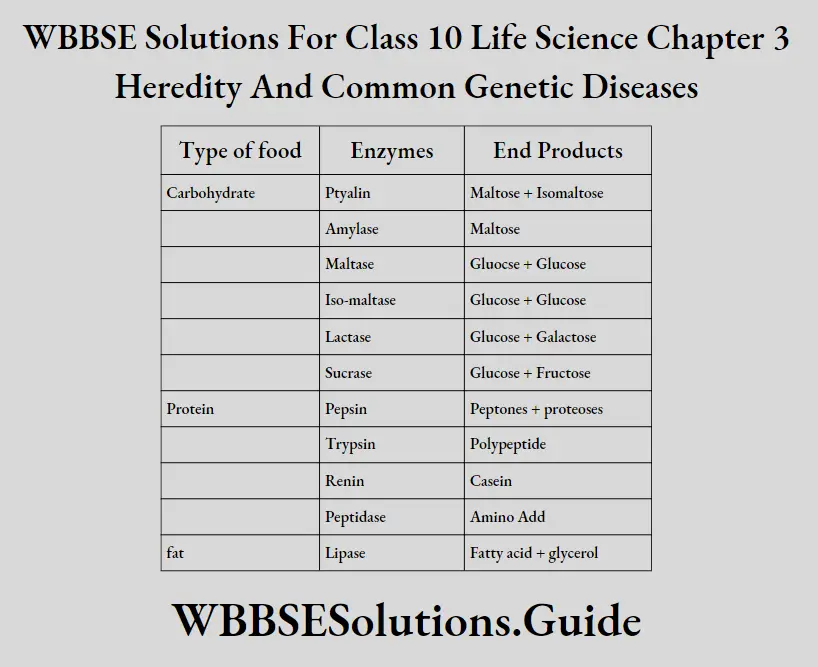
Question 88. Mention any two functions of Vitamin A’. Explain the importance of vitamins.
Answer:
Function of Vitamin A:-
(1) It keeps eye-sight healthy.
(2) It helps in proper growth.
Importance of vitamins in the human body:—
(1) Vitamins help in the regulation of metabolic reactions in the living body.
(2) Vitamin A is necessary for proper growth. It also helps in maintaining normal eye sight.
(3) Vitamin C keeps gums and teeth healthy.
(4) Vitamin D is necessary for the proper growth of bones.
(5) Vitamin E is necessary for the proper functioning of the reproductive system.”
(6). Vitamin K is necessary for the normal clotting of blood.
Question 89 Why are enzymes called biocatalysts? Sequentially mention the names, sites of secretion, substrate, and product of various enzymes that help in the digestion of starch in the human body.
Answer:
Enzymes are called biocatalysts because:-
(1) They are proteins by nature and are produced in living cells.
(2) They remain unchanged after the reaction is over.
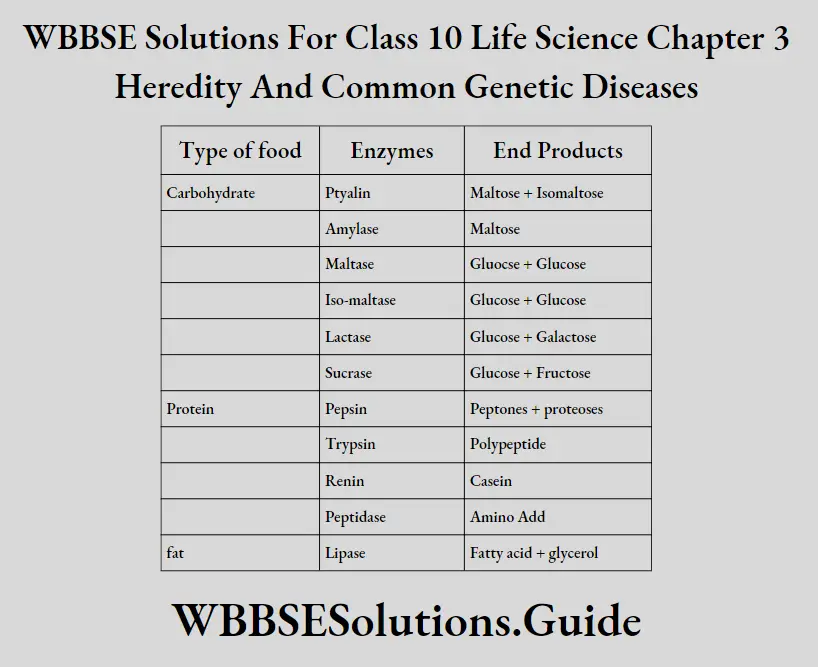
Question 90. Which type of food material fulfills the nitrogen demand of the animal body? What is the end product of the digestion of that food? Write the nutritional importance of carbohydrate type of food.
Answer:
(1) Protein type of food fulfills the nitrogen demand of the animal body.
(2) The end product of protein digestion is amino acid.
(3) Nutritional importance of Carbohydrate:-
(1) It is the main source of energy for our body.
(2) Its other forms like glycogen are stored in muscle cells and act as the source of energy in the future.
(3) It is required to prevent ketosis.
(4) It helps in the development of the brain indirectly by taking part in the formation of galactolipid which is essential for the development of the brain.
Question 91. What is chyme? Explain the action of pancreatic amylase and trypsin.
Answer:
(1) Chyme :
partially digested acidic food present in the stomach is called chyme.
(2) Action of pancreatic amylase:—
It acts in an alkaline medium on starch in Duodenum and converts it into maltose.
Starch + amylase = Maltose.
(3) Action of pancreatic trypsin:—
In Duodenum it acts upon peptone and converts it into peptides.
Question 92. Write about the chemical composition of proteins. Name any two proteolytic enzymes found in the alimentary system of man. What is roughage?
Answer:
(1) Chemical composition of protein:—
Protein molecules are large. They are formed from the combination of simple nitrogenous substances, and amino acids. Amino acids are made up of C, H, O, N, P, and S.
(2) Name of proteolytic enzyme:—
(1) Trypsin.
(2) Pepsin.
(3) Roughage:—
Non-digestible constituents of our diet which are used to prevent constipation, are called roughage.
Question 93. What is the importance of the digestion of food? What is an enzyme?
Answer:
1. Importance of digestion of food:—
(1) It converts complex and insoluble forms of food into simple, soluble, and absorbable forms of food.
(2) This process is indirectly necessary for absorption.
(3) This process prepares the raw materials for respiration.
(4) It is a basic process that helps the organism to survive.
(2) Enzyme:—
The organic compounds that are produced by living cells but without taking part in biochemical reactions within or outside a cell change the rate of chemical reaction, are called enzymes.
Question 94. Write any two general characteristics of enzymes. Mention the names of the main three types of enzymes and indicate their roles in the digestion of food substances.
Answer:
1. Two general characteristics of enzymes:-
(1) All enzymes are chemically protein in nature.
(2) Their action depends on the nature of the medium of food substances, i.e., acidic, basic, or neutral.
2. Name of main three types of enzymes –
(1) Amylolytic enzymes,
(2) proteolytic enzymes,
(3) lipolytic enzymes.
Question 95. Mention one source (from plants) for each type of food and discuss the importance of those three types of food in nutrition. Mention the importance of iodine in the food of man.
Answer:
(1) Name of three types of body-building food in man :
carbohydrate, protein, and fat.
(2) Importance of Iodine:—
It helps in the formation of ‘thyroxine’ hormone. This hormone controls different types of metabolic reactions.
Question 96. What is the importance of nutrition? Explain autotrophic and heterotrophic nutrition in plants with one example of each type.
Answer:
1. Importance of nutrition:—
(1) This process supplies nutrients to the cell. Nutrients are the raw materials for the formation of protoplasm.
(2) It helps to provide new materials to repairer replace the protoplasm in damaged tissue.
(3) It helps for protection against diseases through the assimilation of vitamins and minerals.
2. Autotrophic nutrition:—
The type of nutrition performed by the organism that prepares its food either by the process of photosynthesis or chemosynthesis is called autotrophic nutrition.
Ex – Green mango tree.
(3) Heterotrophic nutrition:—
The type of nutrition performed by all nongreen plants and all animals is called heterotrophic nutrition.
Ex – Mucor.
Question 97. Write with examples the definitions of Autotrophic and Heterotrophic nutrition in plants. Discuss briefly the first three phases of animal nutrition
mentioning the related organs.
Answer:
(1) Autotrophic nutrition:—
The type of nutrition performed by the organism that prepares its food either by the process of photosynthesis or chemosynthesis is called autotrophic nutrition.
Example of Autotrophic Nutrition:—
Nutrition in green neem plants, nutrition in sulfur bacteria.
(2) Heterotrophic nutrition:—
The type of nutrition performed by all non-green plants and all animals is called heterotrophic nutrition.
The organism in which such a type of nutrition is found is called a heterotroph. There are five types of heterotrophs:—
(1) parasite,
(2) saprophyte,
(3) insectivorous,
(4) symbiont and
(5) epiphyte.
Example of Heterotrophic Nutrition:—
Cuscuta, yeast, nepenthes, rhizobium, orchid.
(3) Name of first three phases of animal nutrition:—
(1) Ingestion,
(2) digestion,
(3) absorption.
(1) Ingestion:—
After the selection of food taking its proper quantity into the mouth cavity through the mouth is called ingestion.
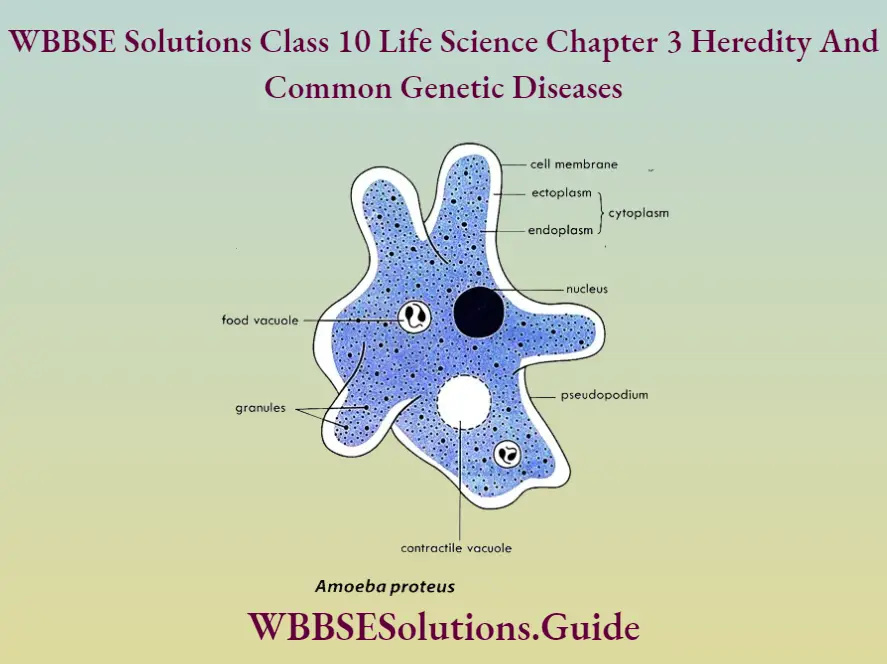
Organ related to this phase —
Hand in case of man.
(2) Digestion:—
The conversion of a complex and insoluble form of food with the help of digestive enzymes into a simple or soluble form of food is called digestion.
Organs related to this phase —
Different parts of the alimentary canal such as the mouth cavity, stomach, and small intestine.
(3) Absorption:—
The transfer of simple food substances such as glucose, amino acid, and fatty acid from the last part of the small intestine to the blood of veins through villi is called absorption.
Organ related to this phase —
Villi of the internal wall of the last part of the small intestine.
Question 98. What are the end products of digestion of carbohydrates, proteins, and fats in the case of man? Name the sources of each carbohydrate, protein, and fat considering one from plants and one from animals.
Answer:
(1) Sources:—
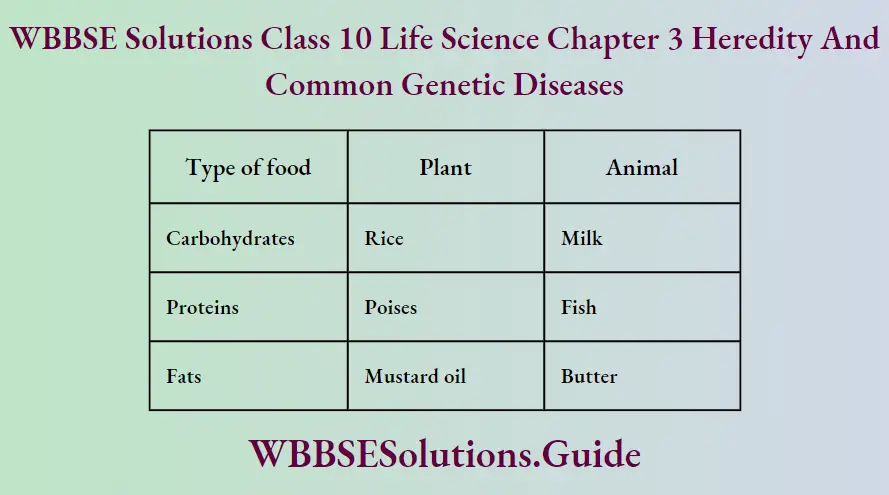
(2) End products of digestion:—
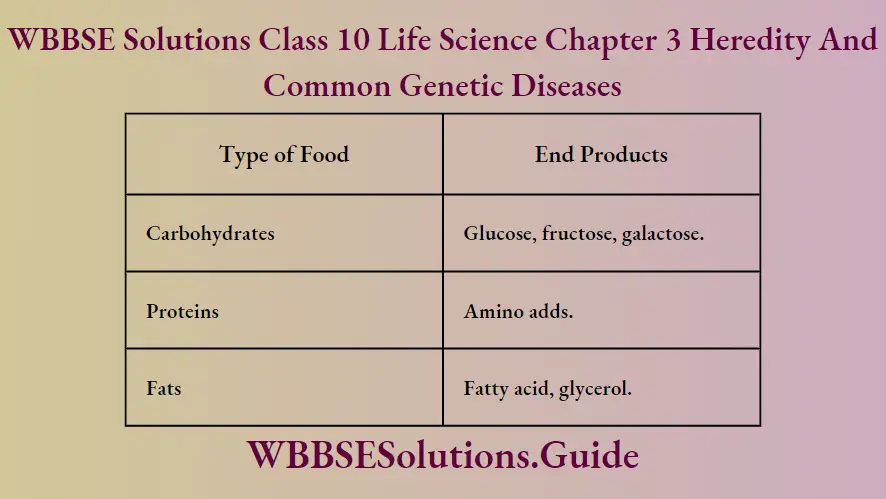
Question 99. What is Enzyme? Mention the names of three major types of food-digesting enzymes. From which parts of the digestive system protein protein-digesting enzymes are secreted?
Answer:
1. Enzyme —
The organic compounds are produced by living cells. but without taking part in bio-chemical reactions within or outside a cell change the rate of chemical reaction, are called enzymes.
2. Name of three major types of food-digesting enzymes —
(1) Amylolytic enzymes,
(2) proteolytic enzymes,
(3) lipolytic enzymes.
3. Name of parts of the digestive system:—
Stomach, Pancreas, and small intestine.
Question 100. What is meant by essential macro elements? Mention the sources of C, H,0, S, P, and K for plants.
Answer:
(1) Essential macro elements:—
The elements which in large quantities are required by living organisms for performing their different types of functions in their body are called essential macro elements. Example:- Carbon, Hydrogen, Oxygen, etc.
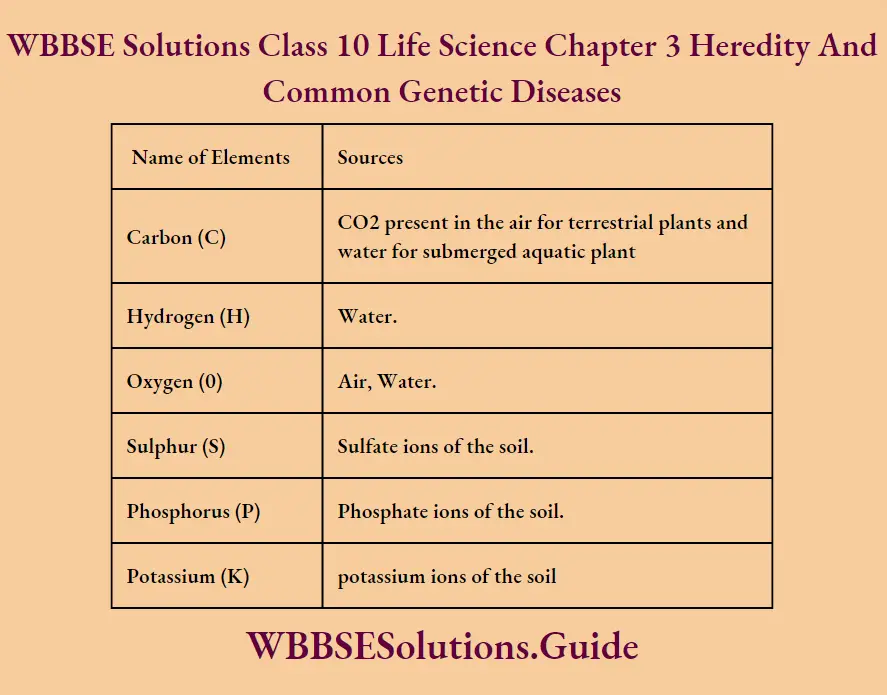
Question 101. What is food? What are the major types of food? What are these? What are their sources?
Answer:
(1) Food:—
The nutrients which supply energy and help in the formation of body substances are called food.
(2) Major types of food:—
The nutrients that supply energy and whose large quantities constitute our diet are called major types of food.
(3) Name of major types of food:—
Carbohydrate, protein, fat.
(4) Sources:
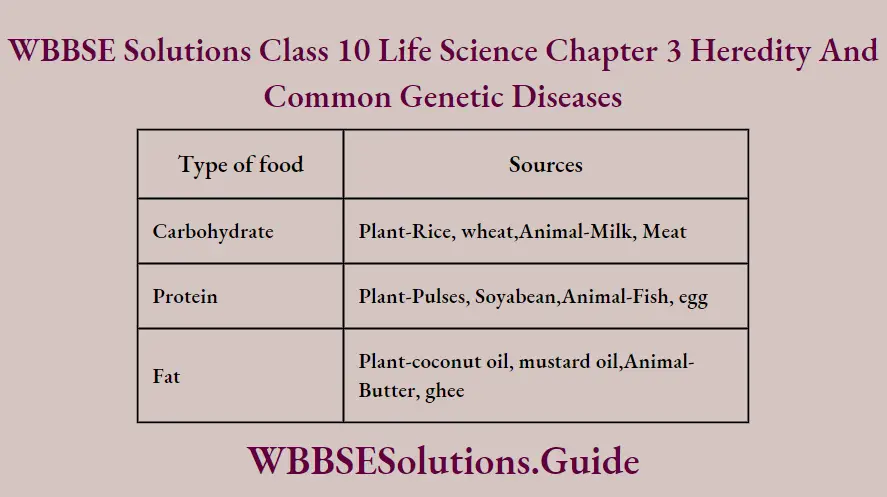
Question 102. Explain with the help of examples the differences between the process of nutrition in plants and animals. Mention the importance of the alimentary system in animals and indicate the place where fat is digested.
Answer:
(1) Difference between plant nutrition and animal nutrition:—
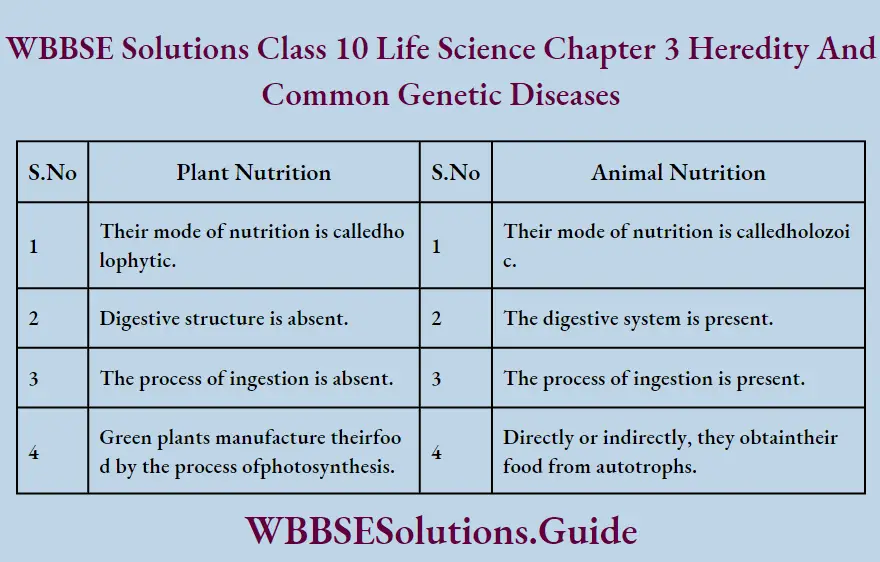
(2) Importance of the alimentary system in animals:—
(1) It helps to store food for a long time.
(2) It produces different types of enzymes from its different parts.
(3) It is the site for proper digestion.
(4) Its some part helps in the absorption of digested food.
(5) The remaining foods after absorption are stored in their last part from where it is ingested.
(3) Place of fat digestion:—
Fat is digested in the stomach and small intestine of the alimentary system.
Question 103. (1) What defects might an infant of 5-6 months develop if it fails to procure sufficient calcium from its mother’s milk to find supplementary food?
Answer:
1. The defects that develop in 5-6 month infants are as follows:-
(1) Retarted bone growth and reduced mineralization of teeth.
(2) Stunded growth will occur.
(3) He will be physically and mentally weak.
(4) He will suffer from Ricket disease.
2. Which types of food must be supplied to a normal healthy adult male in his daily diet, and each in what amount?
Answer:
Type of food Quantity of food
1. Carbohydrate 416 gm.
2. Protein 100 gm.
3. Lipid 100 gm.
3. Write a characteristic feature of each of anabolism and catabolism such that they may be termed processes of opposite nature.
Answer: In anabolism, energy is entrapped, while during respiration energy is released.
Question 104. Define five steps of animal nutrition and mention the organs involved in each step.
Answer:
Five steps of animal nutrition:-
(1) Ingestion:—
The method of capture and intake of food is called ingestion.
Related organ — Man hand.
(2) Digestion:—
The process using which complex food substances are broken down into simpler absorbable forms is called digestion.
Related organs — Mouth and mouth cavity, stomach, small intestine.
(3) Absorption:—
The process using which the digested simpler food materials enter into the cell or blood vessels or lymph from the intestine is called absorption.
Related organs — Villi of small intestine.
(4) Assimilation:—
The process by which the absorbed food substances enter into the Protoplasm and become part of the protoplasm of a cell is called assimilation.
Related Organs — Cells.
(5) Egestion:-
The process by which the undigested food substances are eliminated from the body is called egestion.
Related Organs — Anus.
Question 106. What is a nutrient What is the importance of nutrition?
Answer:
Nutrient :
The organic and inorganic materials that the living organism collects from nature to perform all the fundamental activities of the body are called nutrients,
e.g. Protein, fat, carbohydrates, vitamins, minerals, and water.
Significance / Importance of nutrition :
(1) Growth promotion, repairing wear and tear of the damaged tissues, and gaining energy to control the different metabolic processes are the main functions of nutrition.
(2) Through nutrition the potential energy stored within food is transformed into usable energy. The different physiological functions of the living body like movement, locomotion, excretion, reproduction, etc. are controlled by utilizing this energy.
(3) Nutrition helps to develop the disease-resistant power of the living body.
(4) Nutrition helps to store food in the body for future use. From that stored food (in the plant body mainly as starch and in animals as glycogen and fat) the future energy is produced during shortage of food.
(5) Nutrition plays a special role in the production of heat energy in the organisms to meet the caloric demand.
Question 107. What is Parasitic Nutrition? Classify it with examples.
Answer:
Parasitic Nutrition :
The process by which the plants obtain their necessary nutrition from any other living plants or animals of different species (host) is called parasitic nutrition. Plants drawing in nourishment are called parasites and from which nutrients are drawn in are called hosts. Parasites generally suck in the nutrients by the haustoria of their adventitious roots.
(1) Total Parasite or Holoparasite —
Plants that draw their total nourishment from their respective hosts.
Examples :
Total stem parasite — e.g. Cuscuta reflexa (dodder, swarnalata).
Total root parasite — e.g. Balanophora dioica, Rafflesia Arnoldi.
(2) Partial parasite or Semi-parasite —
Plants can prepare food as they contain chlorophyll but are dependent on the host plants for water and minerals.
Examples —
Partial stem parasite — e.g, Viscum album, Loranthus longiflorus.
Partial root parasite — e.g. Santalum album (B. Chandan).
Question 107. What is Saprophytic Nutrition? Classify it with examples.
Answer:
Saprophytic Nutrition — The nutrition of certain non-green plants that draw their nourishment from the dead and decomposed organic substances formed as a result of the decay of plants and animals is termed saprophytic nutrition.
(1) Total saprophytes— Saprophytes dependent fully on dead decaying organic substances for their nutrition are called total saprophytes.
Examples :
total saprophyte — Mucor, Penicillium, Agaricus, Monotropa uniflora (devoid of roots and chlorophylls).
(2) Partial saprophytes — Green plants that depend partially on dead decaying organic matter for nutrition are called partial saprophytes.
Examples :
Partial saprophyte — Pinus (they absorb organic substances with the help of certain fungus (mycorrhiza) growing on their roots).
Question 108. Discuss Symbiontic Nutrition in animals with examples.
Answer:
Symbiotic nutrition (Mutualism ) :
When two different species of organisms live together enjoying the mutual benefit of nutrition it is called symbiotic nutrition and each species is called a symbiont.
Examples:
The symbiosis between animal and Plant :
Green Hydra and Zoochlorella (algae) live together where green hydra provides protection and shelter to zooxchlorella. In turn, Zoochlorella performs photosynthesis and provides O, to Hydra.
The symbiosis between animals and protozoa :
Termites feed on wood but they do not contain cellulase enzyme. In the digestive system of termites, there are a large number of flagellate protozoa named Trichonympha that can produce the enzyme cellulase which helps in the digestion of cellulose. Thus termites provide shelter to protozoa and protozoa provide cellulose to termites— so both of them mutually benefit
The symbiosis between Ruminant mammals and bacteria :
Ruminant mammal also needs cellulase enzyme for the digestion of cellulose which is produced by symbiotic Rumenococcus bacteria and get food and shelter, in turn, from cattle.
Question 109. Write a short note on the glands of the digestive system.
Answer:
Certain glands such as salivary glands, liver, and pancreas form the accessory organizer:
1. Salivary glands — Three pairs of salivary glands are present in the mouth cavity.
(1) Parotid gland — It is located at the corner of the mandible and ear-lobe on each side of the face.
(2) Submaxillary or Submandibular gland — It is situated in front of the sternomastoid muscle on each side and is surrounded by. the mandible:
(3) Sublingual gland — It is situated beneath the mucous membrane of the floor of the mouth and below the tongue. Salivary ducts, carrying the saliva, open into the mouth near the ‘molar teeth and also on the floor of the mouth.
Function — Salivary glands secrete saliva.
2. Liver — The liver is the largest gland of the body. It is situated below the diaphragm and above and on the right side of the stomach. It is divided mainly into the right and
left lobes. The gall bladder is an elongated, pear-shaped, muscular elastic sac about 7-8 cm long, lying under the lower surface of the liver. Bile secreted by the liver comes
out. through the hepatic and cystic and remains stored in the gall bladder. From the gall bladder, bile passes through the common bile duct into the duodenum.
Functions —
(1) Liver secretes bile.
(2) It acts as an important metabolic as well as excretory organ of the body.
3. Pancreas — Pancreas is a mixed gland that is about 20 cm long and 4 cm broad situated beneath the stomach, within the ‘C’- shaped speed of duodenum.
Functions —
(1) It is composed of pancreatic alveoli which secrete pancreatic juice (digestive juice).
(2) The cells of @ and cells of islets of Langerhans tissue of the pancreas secrete two hormones in the blood, insulin and glucagon.
“WBBSE Class 10 Life Science Chapter 3 important short answer questions, for board exam”
Question 110. What are the functions of the alimentary system
Answer:
Functions of the Alimentary System:
The main functions of the alimentary system are —
(1) Ingestion — Food is taken by the mouth cavity.
(2) Digestion — The complex food is converted to simple food by the process of digestion in the stomach and small intestine. Different digestive glands take part in this
process.
(3) Absorption — The digested simple food is absorbed by the villi of the small intestine of the alimentary canal.
(4) Egestion — Temporarily stored undigested food in the rectum is eliminated as stool.
Question 111. Discuss the process of digestion.
Answer:
1. Mechanical (Physical) events during digestion :
(1) Chewing (Mastication) :
It is the physical process by which solid food breaks into small fragments by teeth. These smaller fragments of food mixed with saliva form bolus that are easily swallowed. The total surface area of fragmented food particles is increased so that digestive enzymes can act better.
(2) Swallowing (Deglutition) :
The physical process (movement) by which food bolus passes from the mouth cavity into the stomach through the esophagus is called swallowing or deglutition. It is a complex inborn reflex process.
(3) Peristalsis :
It is the slow but lateral wavy movement of the alimentary canal consisting of waves of alternate contraction and relaxation by which food materials move downward in the alimentary canal. Peristalsis helps in digestion by proper mixing of food with digestive juice. It also helps in the absorption of digested food and the digestion of faces.
2. Biochemical (Enzymatic) events during digestion :
Protein, fat, carbohydrate and other macromolecules must be properly digested into soluble micromolecules so that they can be properly absorbed. During this digestion, there are profound chemical changes. Various digestive enzymes are responsible for biochemical reactions at different parts of the alimentary canal.
(1) Hydrolysis :
It means the breakdown of chemical bonds of macromolecules of food by the addition of water during enzymatic digestion.
Example : Sucrose + H2O __Sucrase _> glucose + fructose
(C12H22O11 (C6H12O6) (C6H12O6)
Question 112. Write a short note on digestive enzymes.
Answer:
Digestive Enzymes :
Enzymes take part in digestive enzymes. They are of three types —
(1) Proteolytic enzymes or Protein — hydrolyzing enzymes — These enzymes hydrolyze proteins into polypeptides and amino acids, e.g. — Pepsin, Trypsin, Chymotrypsin, Erepsin, Renin.
(2) Lipolytic enzymes or Lipid hydrolyzing enzymes — These enzymes hydrolyze lipids (fats) into fatty acid and glycerol, e.g. Lipase (Gastric Lipase, Pancreatic Lipase,
Intestinal lipase).
(3) Amylolytic enzymes or Carbohydrate hydrolyzing enzymes — These enzymes hydrolyze the carbohydrate into needed items (glucose), e.g. — Amylase, Sucrase, Lactase, Maltase, etc.
Question 113. Write a short note on metabolism.
Answer:
Metabolism:
Definition :
Metabolism is the total of biochemical reactions in the living cell of an organism, which involves the synthesis of complex substances from simple ones with the utilization of energy, and the breakdown of complex substances into simpler ones with the release of energy.
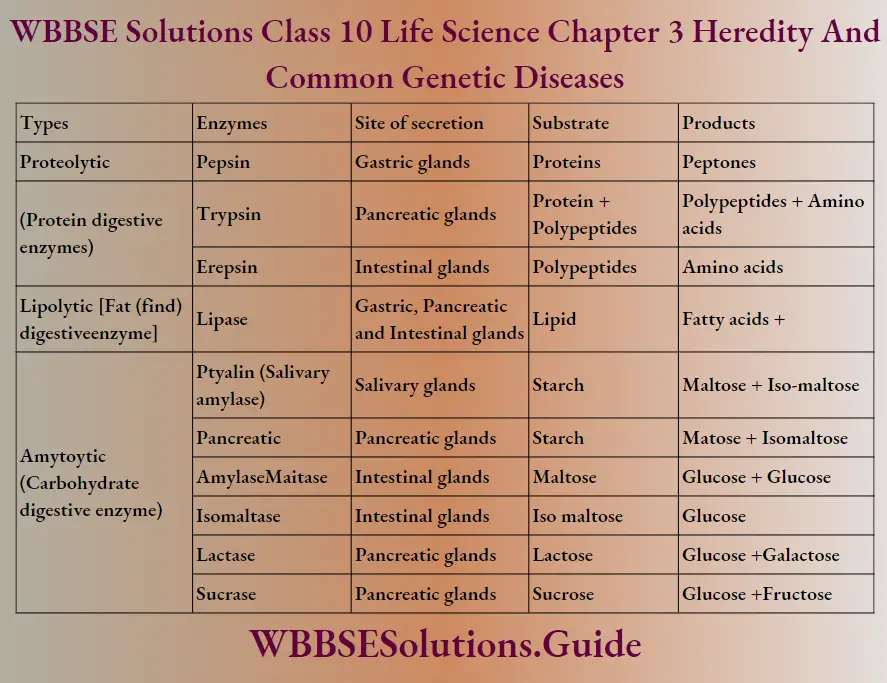
The process of metabolism is completed in two steps — anabolism and catabolism.
Anabolism :
It is the constructive process by which complex molecules are formed from simpler units with the help of energy increasing the dry weight of the organism.
Example: Formation of glycogen from glucose; formation of protein from amino acids, etc.
Catabolism :
It is the destructive process by which complex molecules are broken into simpler units with the liberation of energy resulting in a decrease in the dry weight of the organism.
Example: By respiration, glucose is broken into CO2 and H2O with the release of energy.
Anabolism and catabolism are opposite processes of reversible chemical reactions which may be represented as follows :
anabolism
Small molecules <——-> Large molecules
catabolism
Question 114. State the significance of metabolism. Define a balanced diet.
Answer:
Significance of metabolism:
1. The functional activities of the body depend on various metabolic reactions continuously taking place within the cells of an organism.
2. Various anabolic reactions result in the formation of macromolecules like fat, glycogen, etc. that are stored in respective organs, e.g. fat in adipose tissue, glycogen in liver and muscle, etc.
3. Many enzymes participate in all metabolic reactions resulting in intramolecular or intermolecular transformation.
Question 115. Calculate the daily energy requirement for an adult human.
Answer:
Calculation of energy required daily for an adult human :
Calorie (cal) is the unit of energy and is defined as the amount of heat energy which can raise kilocalorie (Kcal).
For daily calorie requirements of an adult healthy man, weighing about 60 — 70 kg and doing moderate work is about 2500 — 3000 Kcal. This amount of energy is derived from energy-yielding food like carbohydrates, proteins, and fats. On complete oxidation (combustion) these types of food yield the following amount of energy :
1 gram of carbohydrate ——>yields —4.0Kcal
1 gram of protein ——-> Yields — 4.1 Kcal
1 gram of fat ——-> Yields — 9.3 Kcal
Therefore, a man (60 — 70 kg body weight) doing moderate work requires about 3000 Calories. Thus to fulfill this calorie requirement he should consume the following amount of carbohydrates, proteins, and fats in the ratio of approximately 4: 1: 1, (Carbohydrate: Protein: Fat) along with vitamins, minerals, and water to satisfy his or her daily calorie (energy) requirements.
Carbohydrates 415 gram =415 x 4.0 = 1660 Kcal
Proteins 100 gram 100 gram =100×4.1 = 410 Kcal
Fats 100 gram 100 gram =100 x 9.3 = 930 Kcal
—————————————————-
Total energy yields = 3000 Kcal
Question 116. Describe the different types of plant nutrition.
Answer:
Nutrition in plants :
Plants and animals do not obtain food by the same processes. Plants and some bacteria have the green pigment chlorophyll to help synthesize food, while animals, fungi, and other bacteria depend on other organisms for food.
Based on this, there are two main modes of nutrition: autotrophic and heterotrophic.
1. Autotrophic nutrition :
The term ‘autotroph’ is derived from two Greek words autos (self) and trophe (nutrition). In autotrophic nutrition, an organism makes its food from simple raw materials.
2. Heterotrophic nutrition :
Unlike autotrophs, which manufacture their food, heterotrophic organisms obtain food from other organisms. All animals and non-green plants come under this category.
Depending upon the mode of living and the mode of intake of food, heterotrophs may be parasitic, saprophytic, symbiotic, and insectivorous.
(1) Parasitic :
Parasites, obtain their nutrition from hosts. These parasites maintain physical contact with the host plant through haustoria (parasitic roots). These haustoria penetrate host tissue make connections with the conducting elements of the host and draw nourishment.
Example :
Total stem parasites like Cuscuta and root parasites like Orobanche are never green and consequently, they have no power to prepare their food. They get all their food supply from the host plants.
(2) Saprophytic :
Saprophytes get their nutrition from dead and decaying organic matter.
Example :
Neottia (Bird’s nest plant) and Monotropa (Indian pipe) are flowering plants whose roots constitute a mycorrhizal association with fungal hyphae, which helps in absorption.
(3) Symbiotic :
Symbiosis is the habitual living together of organisms of different species. The term is usually restricted to a dependent relationship that is beneficial to both participants (also called mutualism). Symbiotic relationships in plants include the interdependence of the algae and the fungus that form a lichen and the relationship between leguminous plants and the nitrogen-fixing bacteria, which is important in agriculture (nitrogen cycle).
(4) Insectivorous :
They are said to be partly autotrophic and partly heterotrophic. These autotrophs supplement their nutritional requirements by trapping and digesting insects and other small animals. The trapped insects are killed and their proteins are digested by proteolytic enzymes secreted by the epidermis of the leaf.
Question 117. Describe the different types of animal nutrition.
Answer:
Nutrition in animals :
Animals are generally heterotrophic and perform holozoic nutrition. Holozoic nutrition involves the ingestion of complex organic substances. The food of most animals contains large organic substances. In this mode, small or large particles of food are consumed through an opening called mouth (ingestion). Then these are hydrolyzed into simpler and soluble forms (digestion). Simplified products are absorbed into the body and the undigested product is removed from the body and the undigested product is removed from the body (egestion).
Holozoic nutrition is broadly classified into the following categories —
1. Parasitic nutrition is a mode of heterotrophic nutrition where an organism (known as a parasite) lives on the body surface or inside the body of another type of organism (known as a host). The parasite obtains nutrition directly from the body of the host. Since these parasites derive their nourishment from their host, this interaction is often described as harmful to the host. A few examples of parasites are tapeworms, fleas, and barnacles.
2. Symbiotic nutrition :
Symbiotic nutrition is close and often long-term interaction between two or more different biological species. A symbiotic relationship is where two organisms depend on each other and are both benefited by their relationship.
Examples :
A certain kind of bacteria lives in the intestines of humans and many other animals. The human cannot digest all of the food that it eats. The bacteria eat the food that the human cannot digest and partially digest it, allowing the human to finish the job. The bacteria benefit by getting food and shelter, and the humans benefit by being able to digest the food they eat.
3. Saprozoic nutrition :
Nutrition of an animal by absorption of dissolved salts and simple organic nutrients from the surrounding medium; also refers to feeding on decaying organic matter. In this kind of nutrition, the process is started from half or fully broken down macro molecules and is a kind of extracellular digestion that is most often carried out through active transportation.
For example: spiders, house flies, etc.
4. Coprophagy :
Coprophagy is the consumption of feces. Coprophagy refers to any kind of feces eating including the eating of other species (heterospecifics), other individuals (allocoprophagy), or its own (autocoprophagy). These feces contain substantial amounts of semi-digested food.
The most notable feces-eating insect is the dung beetle and the most common is the fly. Pigs eat the feces of humans that leave a significant amount of semi-digested matter.
5. Sanguinivory :
Sanguinivory or hematophagy is the habit of certain animals feeding on blood. Sanguinivores feed on the blood of the vertebrates.
Examples :
Female mosquitoes, leeches, vampire bats, etc.
Question 118. Write a short note on human dietary needs.
Answer:
Human dietary needs :
The human diet must provide the following :
1. Calories — enough to meet our daily energy needs.
2. Amino acids — There are nine, or so, “essential” amino acids that we need for protein synthesis and that we cannot synthesize from other precursors.
3. Fatty acids — There are three “essential” fatty acids that we cannot synthesize from other precursors.
4. Minerals — Inorganic ions. We probably need 18 different ones: a few like calcium in relatively large amounts; most, like zinc, in “trace” amounts.
5. Vitamins — A dozen, or so, small organic molecules that we cannot synthesize from other precursors in our diet.
Question 119. What is the importance of a balanced diet?
Answer:
Importance of a balanced diet:
A balanced diet is important because your body’s organs and tissues need proper nutrition to work effectively. Without good nutrition, your body is more prone to disease, infection, fatigue, and poor performance. Children with a poor diet run the risk of growth and developmental problems. Bad eating habits can continue for the rest of their lives.
A balanced diet is nothing but eating the right amount of food every day. How much food you need every day depends greatly on the activities you do. Other factors like age and gender also affect the amount of energy needed by every person every day. A balanced. diet provides the body with all the necessary nutrients and vitamins, thereby improving the functioning of the immune system. This not only reduces the possibility of being infected by seasonal allergies but also prevents serious health risks, like cancer, diabetes, cardiovascular diseases, etc. Such a diet also keeps you mentally by keeping your mind more alert.
Let us get introduced to the Healthy Diet Pyramid or the Food Pyramid. The Food Pyramid is widely used as a guide to eating the right amount of food every day. In the food pyramid, we can find 4 main groups of foods. A pyramid shape is used because it fits very much to illustrate the amount of food we need every day. If you take a look at the pyramid, its base is winder and as it goes higher it becomes narrower until it reaches its tip. As we go higher to the top, we eat a lesser amount of each food and as go lower, we eat more.
Question 120. Describe the different metabolism-related problems.
Answer:
The different metabolism
An abnormal diet may lead to certain metabolism-related problems, in which a person suffers from different health hazards. A few of those are mentioned below.
1. Diabetes :
In this disease, the blood sugar level goes above normal [70 — 110 mg/ dl in fasting]. It may lead to dysfunction of the kidneys, eyes heart nerves, and other organs
2. Liver cirrhosis :
This is caused by the consumption of excessive alcohol and fatty food. In this disease, liver tissue is seriously damaged, which may transform into liver cancer if not treated early.
3. High blood pressure :
Systolic and Diastolic pressure above 140 and 90 mm Hg respectively is treated as high blood pressure. This disease increases the risk of cardiac and cerebral attack, kidney dysfunction, and many other health problems.
4. Obesity :
It is a metabolism-related problem that occurs due to excess intake of calories. This disease leads to elevated blood sugar, blood pressure, and cardiovascular diseases.
5. Atherosclerosis :
This is a cardiovascular disease in which the walls of arteries become rigid and the lumen reduces. It is caused by to deposition of fat derivatives and other materials in the walls of arteries.
6. Arthritis :
This is a painful inflammatory disease, caused by due deposition of some toxic metabolic wastes within bone joints.
7. Ketosis :
Prolonged fasting leads to excessive protein breakdown and discharge of ketone through urine.
8. Goitre :
A deficiency of iodine in food leads to this disease, where the function of the thyroid gland is affected.
Question 121. What are biomolecules? What is the average composition of plant and animal cells?
Answer:
Biomolecules:
Building block molecules are called biomolecules. They make up the body of organisms, cells, and cell organelles.
It is of two types —
(1) Macromolecules :
Small molecule size with low molecular weight.
eg. minerals, water, gases, carbohydrates, etc,
(2) Macromolecules :
Large molecule size with high molecular weight. It is formed by polymerization of many micromolecules of one type.
eg: Protein, Polysaccharides, Nucleic acid.
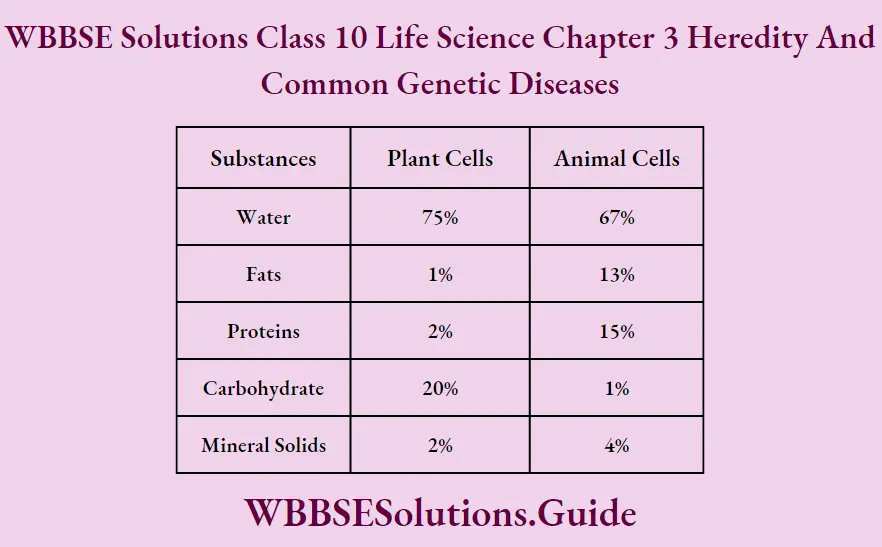
Question 122. Write the roles of inorganic compounds in the body of a living organism.
Answer:
Water :
It is the most abundant inorganic compound in living organisms. On average water forms 65-75% of protoplasm.
It acts as a solvent for all soluble substances in the cell. It provides an aqueous medium for various cellular reactions. It provides proper hydration to protoplasm. It provides turgidity to the cells in plants. Water maintains constant body temp. In plants and animals. Water acts as a source of hydrogen in photosynthesis.
Gases :
The main gases which play an important role in metabolism are O2 and CO2. Oxygen is needed for the aerobic breakdown of organic food and the release of energy for life. Carbon dioxide is used by photosynthetic autotrophs for the synthesis of carbohydrates.
Question 123. What are carbohydrates? Write its functions.
Answer:
Carbohydrates:
Organic compound containing carbon, hydrogen, and oxygen. Its general formula is Cn(H20)n. Based on the number of sugar units in the molecule, it is classified as –
(1) Monosaccharides :
Contain only one sugar unit known as glycoses or simple sugar. These are the reducing agents.
Eg. Glucose (C6H12O6)
(2) Oligosaccharides :
Carbohydrates with 2-9 monosaccharides joined together.
glucose + glucose -» Maltose
glucose + fructose -» Sucrose
glucose + galactose -» Lactose
(3) Polysaccharides :
Carbohydrates with 10 or more monosaccharide units. These are macromolecules.
Eg: Starch and cellulose.
Functions :
(1) These are structural components
(2) Play an important role in metabolic functions
(3) as a potential source of energy in cells.
“WBBSE Class 10 Life Science Heredity and Genetic Diseases, short Q&A, solved questions”
Question 124. What are Amino Acids and proteins? Write their functions.
Answer:
Amino Acids and proteins
Amino acids are microbiomolecules with low molecular weight. It contains C, H, and N, S.
These are essential and non-essential amino acids.
Essential amino acids are 8 in number. These are not synthesized in animal cells and obtained through diety only. eg. Valine, Leucine, Methionine, Lysine, etc.
Non-essential amino acids are 10 in number and naturally synthesized in the body.
eg. Alanine, Arginine, Aspartic acid, Serine.
Semi-essential Amino Acid :
Only 2 in number can be synthesized in animal cells but not enough. Eg. Arginine and Histidine.
Amino Acids are used in Protein Synthesis, glucose, vitamins, and hormone synthesis.
Question 125. Write the structure and functions of the protein.
Answer:
These are long-chain polymers of amino acids with very high molecular weight. It contains C, H, O, N, S and P. The bond which joins two amino acid molecules is a peptide bond.
Types of protein :
(1) Simple protein :
made of only amino acids.
eg: albumin, histone.
(2) Conjugated protein :
made of amino acid + some non-protein group.
eg: Nucleoprotein, Glycoprotein.
(3) Derived protein :
These are intermediate degradation products of protein, obtained on hydrolysis of protein.
Functions of Protein:
(1) These are structural constituents of protoplasm, protoplasmic organelle, and cell membrane.
(2) Enzymes are proteins, essential for metabolism.
(3) Cytochrome pigment helps in photosynthesis and Respiration.
(4) Haemoglobin transports oxygen in the body.
(5) Actin and myosin help in muscle contraction.
(6) Fibrinogen and thrombin help in blood clotting.
Question 126. Write the structure and functions of lipids in the human body.
Answer:
Lipids are oily, greasy organic compounds, insoluble in water. Lipid molecule contains C, H, and O. They have less percentage of oxygen.
These are :
(1) Simple lipids :
are esters of fatty acids with alcohol.
(2) Compound lipids :
These are fatty acids + Alcohol + Some other group.
eg. Phospholipid, Glycolipid, Steroids Carotenoids.
Functions of lipids:
(1 Release more energy than carbohydrate
(2) Constituent of cell membrane
(3) Acts as a solvent for fat-soluble vitamins
(4) Acts as insulator.
Question 127. What are Nucleotides and Nucleic Acids?
Answer:
Nucleotides :
Nucleotides are the building block unit for Nucleic acid. These are macromolecules with low molecular weight.
Nucleotide = Pentose Sugar + Nitrogenous base + Phosphate group.
Nucleic Acid :
These are long-chain polynucleotide macromolecules. These are the most important biomolecules, and control most biological processes, including heredity.
There are two types of Nucleic acid – DNA and RNA.
DNA (Deoxyribose Nucleic Acid) :
double-stranded helical structure. Two strands are antiparallel and coiled around each other. Complementary base pairs are :
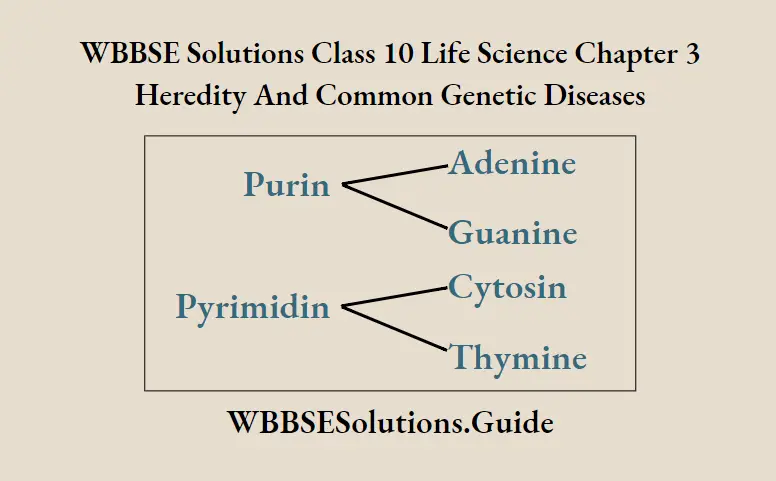
Adenine is attached to thymine with a double hydrogen bond. Guanine with cytosine with a triple hydrogen bond. DNA has the unique ability of self-replication.
Functions of DNA:
(1) It is the genetic material of all organisms (except some viruses)
(2) It takes part in genetic recombination.
(3) It can replicate itself.
RNA (Ribose Nucleic Acid): Single stranded, long chain polynucleotide. Complementary base pairs are — Adenine, Guanine, cytosine, and Uracil. These are mainly. present in cell cytoplasm.
Types:
Messenger RNA (mRNA)
Transfer RNA (tRNA)
Ribosomal RNA (rRNA)
Functions :
(1) Involved in protein synthesis
(2) In certain viruses acts as the genetic material.
Question 128. What are vitamins? Writes their roles in the human body.
Answer:
Vitamins :
Vitamins are complex organic chemicals that are present in our food in small quantities. Vitamins are essential for growth, good health, proper vision, normal digestion process, and coordinated activities of our body.
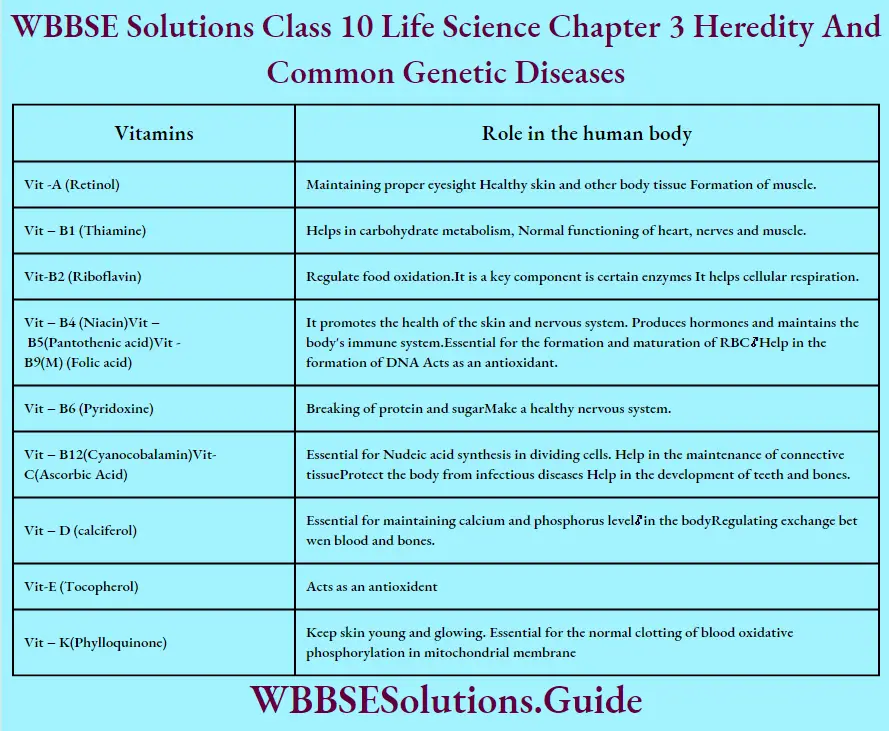
These are :
(1) Fat-soluble vitamins — A, D, E, K
(2) Water soluble vitamins — B complex and C
Question 129. What are minearls? Write the role of minerals in human body.
Answer:
Minerals :
These are an inorganic element, occurring in the form of their salts.
Elements that are required in larger amounts for normal nutrition are called macroelements. Eg, C, H, N, O, P, Ca.
Elements which are reuiqred in very small amount for normal nutrition are called microelement. Eg, Iron, Copper, Zinc, Iodine.
Question 130. (1) Define excretion. How does it differ from secretion ?
Answer:
Excretion
The process by which living organisms get rid of their metabolic wastes from the body, through the excretory organs is called excretion.
Secretion is the process of discharge of essential substances from the cell, through the cell membrance for special function within the body is called secretion. Eg. enzyme from exocrine gland and hormones from endocrine glands.
(2) Why is excretion necessary?
Answer:
(1) Excretory products are harmful to the body. So it is necessary to remove them.
(2) To maintain the contents of the protoplasm.
(3) Most of the plant excretory materials have great economic and medicinal importance. _
(4) To maintain water balance and osmotic equilibrium.
(3) Why is excretion a catabolic process ?
Answer:
(1) Formation of excretory products occurs by catabolic process (Break down).
(2) Elimination of metabolic waste products from the body takes place (wieght decreases).
(3) Result in decrease in dry weight of the organism.
Question 131. Name the excretory products in plants in tabular form with their uses.
Answer:
Non nitrogenous excretory products — Latex, Resin Tannin, gums, crystal, organic acids, essential oils.
Nitrogenous waste products — Alkaloids like Morphine, Quinine, Nicotine, Atropine, Reserpine, Caffeine, Thein etc. i
Non-nitrogenous waste products
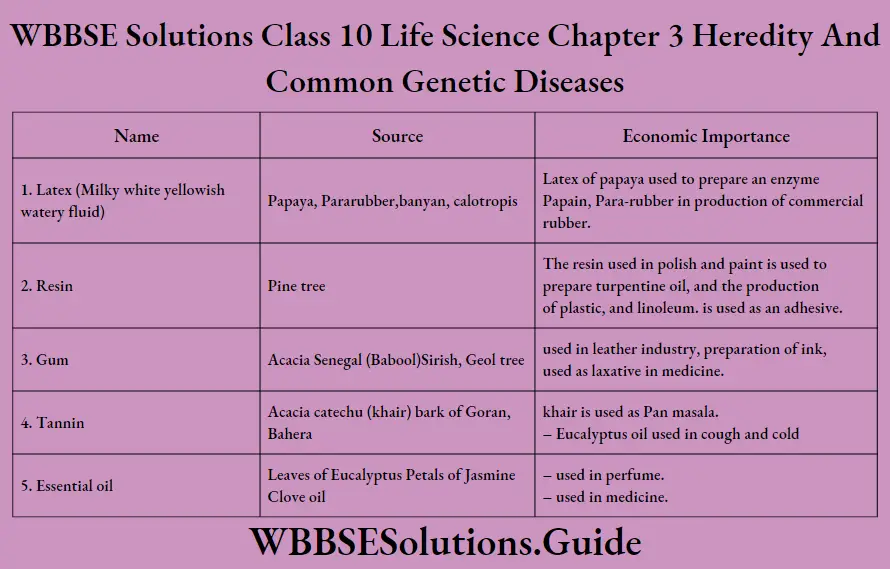
Non-nitrogenous waste products
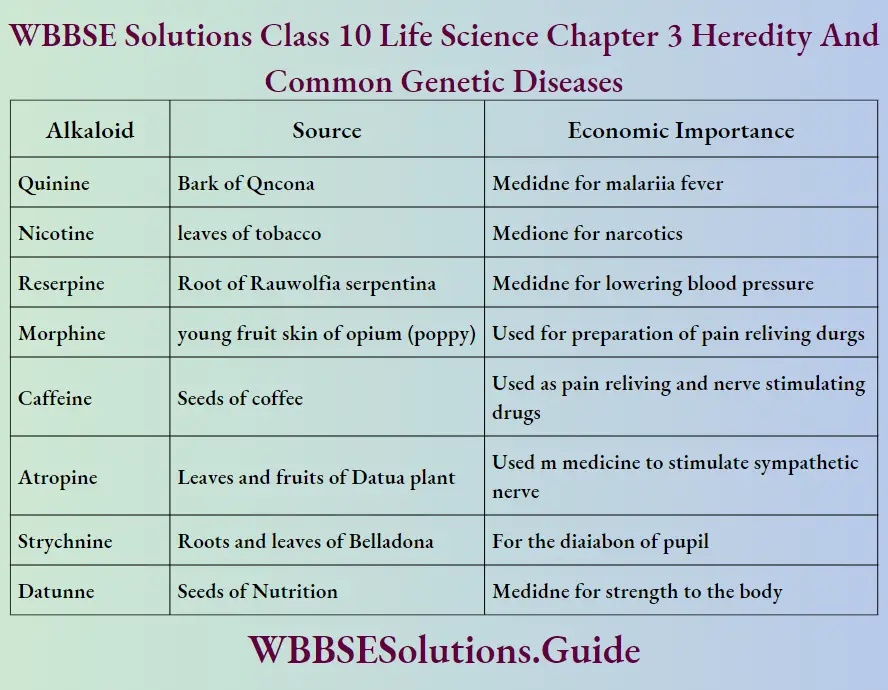
Question 132. What is the process of excretion in plants ?
Answer:
There are no speical excretory organs in plants. The metabolic waste products are stored in root, stem, leaves, flowers and fruits. There is less formation of excretory products in plants and have no harm if stored in their body.
The process of excretion in plants are —
(1) Shedding of bark :
Plants like Arjun, Guava store their excretory products in the bark, and is eliminated at regular interval through the removal of bark.
(2) Shedding of leaves :
In deciduous plants metabolic wastes are transported and stored in the cells of leaves, and these wastes are eleminated by following of leaves. eg. Silk cotton, Sirish, etc.
(3) Shedding of flowers :
Metabolic wastes stored within the flower petals and also in the bract, are removed along with shedding of these organs
(4) Shedding of fruits :
Fruits like apple (malic acid), tamarind (tartaric acid), lemon (citric acid), removed by falling of fruits.
Question 132. “All excretory products are waste products but all waste products are not excretory products” Comment.
Answer: All excretory products are waste products but all waste products are not excretory products because they are toxic to the body and causes harm, if they store for longer time. Stool is not produced out of metabolism, hence it is not counted as an excretory substance.
Question 133. Name the excretory organs in animals.
Answer: The organs which are related to the removal of excretory products are called excretory organs
Different animals have characteristics of excretory organs as :
1. Contractile vacuole -—Amoeba, Paramecium, chlamydomonas
2. Flame cells — Flatworm. A bunch of flame cells called protonephridia
3. Nephridia — Earthworm, Leach
4. Malpighian tubule — Cockroach
5. Green gland — Prawn
6. Kidney ___ Vertebrates (fish, amphibia, birds, reptiles, and mammals)
7. Scorpion — Coxal gland
8. Snail —- Nephridia
Question 134. Explain with diagram the excretory system of human.
Answer:
Excretory system of human
The excretory system of human comprises two kidneys, two ureters, one urinary bladder and one urethra. A sphincter muscle is present at the junciton of Urinary bladder and Urethra, by which we can evacuate urine as our desire.
Each kidney is bean shaped, dark reddish brown in colour situated on the posterior portion of abdominal cavity on either side of vertebral column. Right kidney is slighly smaller than the left and the left is situated slightly above the right one. In adults its weight is 125-170 grms. The lateral margin is convex, while the medium margin has a concavity in the middle called hilum.
Internally each kidney is distinguished in two zones — an outer dark red zone — cortex and inner zone — medulla. Ureter entering through the hilum expands forming wide a funnel shaped str. called Pelvis which has at its free end, a number of cup like cavities called colyces. The inner border of medullary region is extended into a series of 15-16 cone like projections called renal pyramids. Fach kidney contains about
one million of nephron.
Functions of kidney :
(1) It excretes nitrogeneous and sulphur containing waste products of protein metabolism.
(2) It helpes in the osmo-regulation of the body.
(3) It helps to keep acid-base balance.
(4) It eliminates drugs and various toxic substances from the body.
(5) It regulates blood pressure.
(6) It helps in maintaining the osmotic pressure in blood and tissue.
(7) It plays an important role in Vit D metabolism.
(8) It synthesizes ammonia, hippuric acid and other substances.
Ureter :
Ureter are two in number 35 cm long, slightly curved tube, emerging from the renal pelvis. It connects kidney to the urinay bladder.
Urinary bladder and Urethra :
Urinary bladder is a muscular sac located in abdominal cavity. Urethra is a muscular tube that arises from bladder. Urinary bladder retains urine for some time when the bladder is full, the muscles of bladder contracts and urine goes out.
Question 135. What are Nephrons ? Write the structure and functions of nephron.
Answer:
Nephrons :
Nephron is the structural and functional unit of kideny. Each kidney consists millions of nephron. Average length of each nephron is 5 cm.
There are two types of nephrons :
(1) Superficial nephrons :
Present in the outer 2/3 of the cortex. They are smaller in size and constitute 85% of the total nephron. They work in normal condition.
(2) Juxtamedullary nephrons :
Present in the inner 1/3 of the cortex. They are larger in size and constitute 15% of total nephron. They work under stress condition.
Histologically, a nephron is made up of 2 parts, viz. Malpighian corpuscle and Renal tubule.
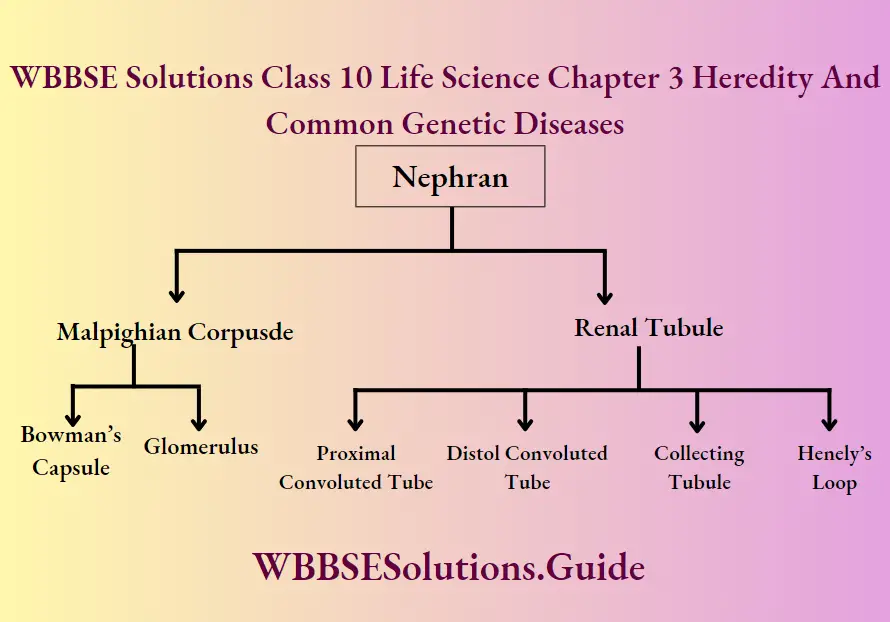
The free and blind end of nephron forms a cup shaped double walled structure called Bowman’s capsule. The outer layer of capsule is caled Parietal layer and the inner layer is called visceral layer.
Glomerulus :
It is a bunch of loop like capillaries ean eige within the Bowman’s capsule, formed by short and wide affarent arteriole (a branch of renal artery) and long and narrow efferent arteriole.
Malpighian corpusels forms the filtering bed and help in urine formation.
Renal Tubule is tubular portion of nephron.
(1) PCT :
descending tubule, highly coiled, situated in the cortical region of kidney. The inner wall is lined by cuboidal epithelium. It absorbs essential nutrients and huge amount of water.
(2) Henley’’s loop :
is U shaped middle portion, situated in the medullary region of the kidney. It absorbs water and electrolyte.
(3) DCT:
It is ascending tubule, situated in the cortical part of kidney: Inner wall is cuboidal epithelium. It reabsorbs sodium ion, water and bicarbonate.
Question 136. Write the steps of urine formation in human kidney.
Answer:
Urine formation involves three main steps :
Ultrafiltration, tubular reabsorption and tubular secretion.
“Best short answer questions for WBBSE Class 10 Life Science Chapter 3, with solutions”
(1) Ultra filtration (Glomerular ultrafiltration) :
The diameter of the afferent arteriole is double that of the efferent arteriole. Hence more blood comes in the glomerulus and less blood goes out of the glomerulus.
It creates a, pressure and causes filtration of various materials from blood. This process of filtration of blood is called ultrafiltration. The Glomerular Filtration Rate in normal healthy person is 125 ml/minute i.e 180 Ltr/day.
Tubular Reabsorption :
The glomerular filtrate contians many essential substances like phosphate, bicarbonate, chlorine ions, vit-C, amino acid, glucose, absorbed by the tublues. All these reabsorbed materials then return to blood. The process of tubular reabsorption is influened by hormone ADH and Aldosterone.
Tubular Secretion :
During urine formation, tubular cells secrete substances like H* K*and ammonia, creatinine, hippuric acid, penicillin, etc..These secretion, play an important in urine formation as it helps in the maintence of ionic and acid-base balance of body fluid.
Question 137. Write the role of Liver, Lungs and skin in the process of excretion.
Answer:
Liver, lungs and skin are accessory excretory organs in human.
Role of Liver :
Within liver, ammonia is converted into Urea in ornithine cycle. Liver also secretes bile which containes some excretory substances like cholesterol, drugs, steroids and bile pigment-bilirubin and biliverdin which is eliminated front the body in the form of facaes.
Role of Lungs :
CO2 which is produced by the catabolic process of glucose in the cells reacts with water to form carbonic acid (C6H12O6 ). This CO2 along with water vapour, alcohol, acetone, ammonia are excreted during expiration through the lungs.
Role of skin :
Normally skin is the protective layer of the body. It contains numerous sweat glands which secrete sweat. Sweat contains urea, lactic acid, creatinine, uric acid, salt, etc. These excretory products along with water are excreted. The sweat secretion also keep our body cool in summer.
Question 138. What is Urine? Write the composition of Urine.
Answer:
Urine:
Urine is clear, yellow coloured weakly acid, aromatic watery solution of different metabolic wastes formed in the nephron of kidney.
Normally urnie consists 94.96% water, 4-6% of solids, Inorganic substances like Na, Cl, KCI, PO4, SO4, Ca, and organic substance like urea, uric, acid, creatinine, ammonia, hippuric acid, urochrome, oxalic acid, latic acid, ketone bodies, etc. are present.
Among abnormal constituents of urine are glucose, bile pigment, blood and pus, protein and ketone bodies.
11. Give an account of different essential oils produced from plants and their economic importance.
Answer:
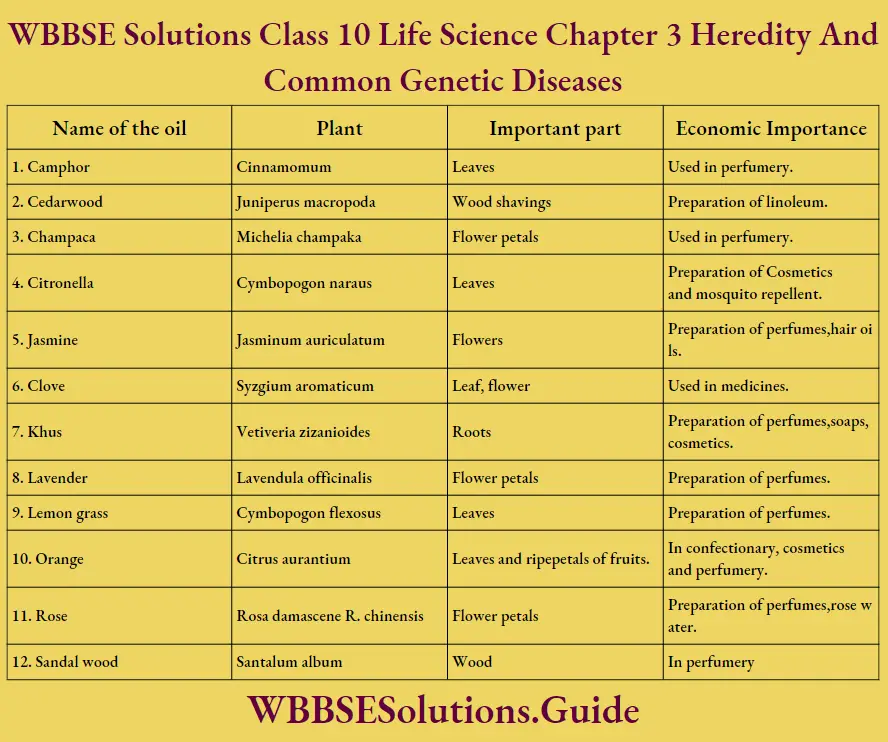
Question 139. State the importance of Excretion.
Answer:
Importance / Significance of Excretion :
1. Maintenance of normal health — The excretory products are harmuful to the body. Excess amount of excretory substances when accumulated in the body causes toxic effects or even may cause death to the organism. Thus regular excretion of these excretory products prevents from toxic effects and keeps body fit.
2. Maintenance of protoplasmic substances — Excretion has some role to maintain the balances of different protoplasmic substances in the cell, the protoplasm in turn helps to keep normal life processes of the organism.
3. Maintenance of osmosis — Excretion has some role on the regulation of osmosis.
4. Role in ecosystem — The excretory products are formed by the breakdown of nutrients.
5. Economic importances — The economic importances of excretory products of the plants are vast for human aswell as animal kingdom.
6. Maintenance of water balance — In various organisms mainly in animal and from human body excess amount of body water is excreted (eliminated) to maintain the water balance by this process.
“Class 10 WBBSE Life Science Chapter 3 short answers, Heredity and Genetic Diseases, study guide”
Question 140. Why are lesser excretory materials formed in plant ?
Answer:
Reasons which cause lesser formation of excretory materials in plants:
1. Ammonia produced due to metabolism is utilized in the formation of various nitrogenous compounds by plants.
2. Carbon dioxide and water obtained due to respiration are used during photosynthesis. The oxygen obtained from photosynthesis is used in the respiration.
3. In plants the materials are formed.
4. In plant body the excretory materials which do not contain nitrogen are often stored within certain organs as they are not toxic.
5. In plant body the protein and nitrogenous compounds are broken down to ammonia which act as an useful substance.
From all these above reasons we can find that plant excretory products are less harmful than anumal excretory products.
Question 141. Write a note different excretory organs in animals with their functions.
Answer:
Different animals have characteristic excretory organ that has various shape, size and structure but perform same function of excretion as well as water balance of the body called osmoregulation some common examples of animal excretory organs are as follows :
(1) Contractile vacuole :
It is a subcellular membranous organelle, mainly found in protists (e.g. Amoeba, Paramoecium) and unicellular algae (e.g. Chlamydomonas), which primarily helps in osmoregulation.
Excess water is collected in the contractile vacuole and so the vacuole swells. Then the vacuole comes in contact with cell membrane, contracts and releases excess water out of the cell.
(2) Flame cell :
It is a specialized excretory cell found mainly in Platyhelminthes or flatworm (e.g. Taenia solium or Tape worm), that removes excretory product out of the body. Bunch of flame cells are together called as protonephridia.
Flame cell is a nucleated cup-shaped cell body with bunch of flagella inside that looks like flame of fire, Many flame cells are attached with common excretory canal. Collected excretory product from the cells is released in excretory canal and then goes outside.
(3) Nephridia :
This is the excretory as well as osmoregulatory organ found mainly in Annelida like earthworm, leech, etc. There are two basic types of nephridia — metanephridia (larger) and protonephridia (smaller). In earthworm, metanephridia is found.
In consists of ciliated funnel called nephrostome the collects excretory product from coelom. The product flows through nephridial tubule and finally goes out through nephridiopore. In the tubule, however, various necessary substances are reabsorbed,
(4) Malpighian tubule :
This is tubular excretory as well as osmoregulatory organ found in different Arthropoda (primarily in insects like cockroach and others).
These are bunch of slender tubules, located at the junction of midgut and hindgut. Most tubules are highly convoluted. The number tubules varies. These tubules collect excretory product from haemolymph and drain it into hindgut, from where the product moves through hindgut into rectum and finally goes out through anus.
(5) Kidney :
This is the most important excretory oragan in higher animals. All vertebrates have kindney. Like human kidney, they are made up of many nephrons (the structural and functional unit of kidney).
Kidney is mainly responsible for elimination of toxic metabolic waste product as well as osmoregulation, mineral balance and so on.
Question 142. What is blood ? What are the different components of blood?
Answer:
Blood :
Blood is a fluid connective tissue that circulate in the conducting vessels carrying nourishment and oxygen to all parts of the body and bringing metabolic wastes from them. It looks red due to the presence of an iron pigment namely haemoglobin.
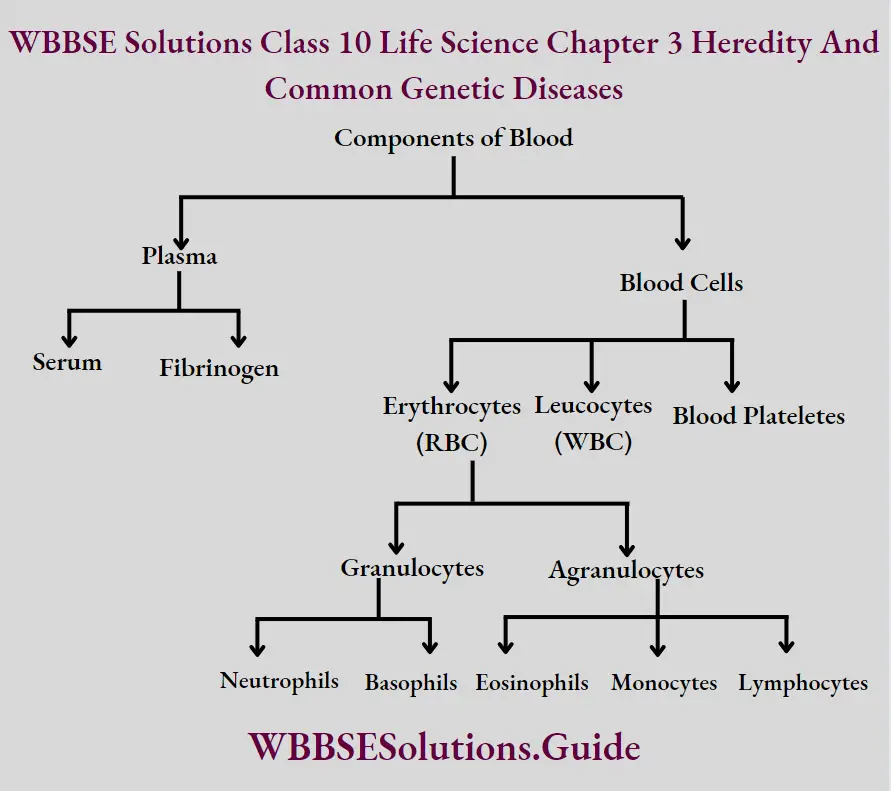
Question 143. Define and exemplify universal donor and universal recipient blood groups.
Answer:
The persons who can give blood to the persons having blood of any of the four blood groups is called universal donor. Example : ‘O’.
The person who can receive the blood from the persons having blood of any of the four blood groups is called universal recipient, e.g. the person having blood group ‘AB’
is called universal recipient.
Question 144. Why does the heart palpitate sometimes rapidly and sometimes very slowly ?
Answer:
The rate of heartbeat depends upon the following factors :
1. Quantity of blood,
2. Rate of respiration,
3. Emotional disturbance,
4. Systole and diastole of heart.
If the blood from left ventricle through the aorta abruptly increases or decreases, it will change the heart-beat accordingly.
The emotional disturbance and the release of hormones which in fluences the heart, obviously the heart-beat is altered. If the rate of respiration sharply increases, the
heart beat is effected, as 1 respiratory cycle under normal circumstances is equal to 4 cardiac cycles. We resipre 18 times per minute and the heart beats 72 times within the
same period.
Question 145. Why does the blood flow in the body of a vertebrate animal ?
Answer:
Blood flows in the body of a vertebrate animal due to the rhythmicity of the heart. This can be explained as follows :
Blood flows in the body of a vertebrate animal due to the pumping action of the heart which acts as a double force pump. When the blood enters the right auricle (artrium) through superior and inferior venacavae, and the left auricle (atrium) through pulmonary veins, the systole movement (contraction) occurs in the both auricles which is initiated by the sinoauricular node (SA NODE) or the Pace-maker. The pacemaker than imparts kinetic energy to the blood which flows further. The presence of valves at different places prevent the back flow of blood. The presence of valves at different places prevent back flow of blood. The valves and kinetic energy maintain the unidirectional flow of the blood. Due to the regular rhythmic relaxation and contraction of the heart:the blood never stops and continues to flow.
Question 146. State the importance of circulation.
Answer:
Importance (Functions) of Circulation :
Circulation of blood acts mainly as ta support medium and helps the living body to perform several important functions as stated below :
(1) Transportation of nutrients — The digested food substances are absorbed from the digestive canal and carried by blood or lymph to all living body cells to provide nutrition.
(2) Transportation of respiratory gases — The oxygen (O2 ) for respiration is carried from lungs to the tissue cells and carbon dixide (CO2 ) produced in the tissue cells are carried by blood to the respiratory organs from where it goes out.
(3) Transpotation of enzymes and hormones — The enzymes, hormones, etc. are essential for proper functioning of the living body. They are synthesized and liberated from several sources and are carried by blood to the respective sites of action.
(4) Transportation of waste products — Various toxic metabolic waste products formed as a result of cellular metabolism are liberated out from the body through circulation.
(5) Helps in storage — The essential substances or other organic matters formed in excess within the living body are carried by circulation to the storage organs for future use.
(6) Maintenance of blood pressure — Blood circulation maintains blood pressure and thus regulates exchange of fluids and ions between blood and tissues.
(7) Transportation of minerals — Various minerals are transported by circulation from one part of the body to other.
(8) Generation of heat — By circulation the cells receive food (respiratory substrate) and O2 and then the cells produce heat energy by respiration.
Question 147. What is coagulation of blood? What are the fectors involved in it ? Briefly describe the process of blood coagulation.
Answer:
Coagulation of blood:
1. The process by which blood oozing out from the ruptured blood vessels loses its fluidity in a few minutes and sets into a semi solid jelly-like mass, is called coagulation.
2. Factors involved in blood coagulation :
Blood coagulation is a complex process which requires about 13 factors. All these factors are present in plasms except factor Ill (thromboplatin). Except factor IV (calcium ion) all other factors are protein in nature. Some important factors are — Factor | (fibrinogen), Factor II (prothrombin), Factor Ill (thromboplastin), Factor IV (Ca++) and son on.
3. Process of blood coagulation :
It taken place in three steps —
(1) When blood comes out of an injured area, the platelets come in contact with ruptured blood vessels (rough surface). The platelets are broken in the presence of several clotting factors of blood and produce intrinsic thromboplastin.
Thromboplastin is also produced from the damaged tissue cells (extrinsic thromboplastin or tissue thromboplastin) in presence of Ca++ and other factors.
(2) Prothrombin of plasma is converted to thrombin in the presence of Ca ++ and thromboplastin.
(3) Thrombin reacts with soluble fibrinogen to convert it into insoluble fibrin. In the mesh work of fibrin fibres, the blood corpuscles are entangled forming a plug which is called clot.
Equations:
1. Normally in circulating blood :
Platelets + Prothrombin + Fibrinogen —> no clot
2. After shedding of blood :
Releasing
(1) Broken platelets or damaged tissues ——-> Thromboplastin.
Ca+
Thromboplastin
(2) Prothrombin ———–> Thrombin.
Thrombin
(3) Fibrinogen Fibrin (clot). ———-> Fibrin (clot).
Question 7. Classify body fluids on the basis of fluid compartments.
Answer:
Fluid Compartments :
Body fluids can be discussed in terms of their care
fluid compartment, a location that is largely separate from another compartment by some form of a physical barrier. The intracellular fluid (ICF) compartment is the system that includes all fluid enclosed in cells by their plasma membranes. Extracellular fluid (ECF) surrounds all cells in the body. Extracellular fluid has two primary constituents the fluid component of the blood (called plasma) and the interstitial fluid (IF) or tissue fluid that surrounds all cells not the blood.
Intracellular Fluid :
The ICE lies within cells and is the principal component of the cytosol/ cytoplasm. The ICF makes up about 60 per cent of the rotal water in the human body. This fluid volume tends to be very stable, because the amount of water in living cells is closely regulated.
Extracellular Fluid :
The ECF accounts for the other one-third of the body’s water content. Approximately 20 per cent of the ECF is found in blood plasma. Plasma travels through the body in blood vessels and transports a range of materials, including blood cells, proteins (including clotting factors and antibodies), electrolytes, nutrients, gases and wastes. Gases, nutrients and waste materials travel between capillaries and cells through the IF. Cells are separated from the IF by a selectively permeable cell membrane that helps regulate the passage of materials between the IF and the interior of the cell.
“WBBSE Life Science Class 10 Chapter 3 solutions, short answer questions, exam-focused”
The body has other water-based ECF. These include the cerebrospinal fluid that bathes the brain and spinal cord, lymph that helps in transport and immunity, the synovial fluid in joints which helps in mobility, the pleural fluid in the pleural cavities, the pericardial fluid in the cardiac sac, the peritoneal fluid in the peritoneal cavity,
and the aqueous humor of the eye. Because these fluids are outside of cells, these fluids are also considered components of the ECF compartment. Fluid is lost from our body through urine, sweat, etc.
Chapter 3 Physiological Processes Of Life Difference Type Questions
1. Photosynthesis and Respiration:—
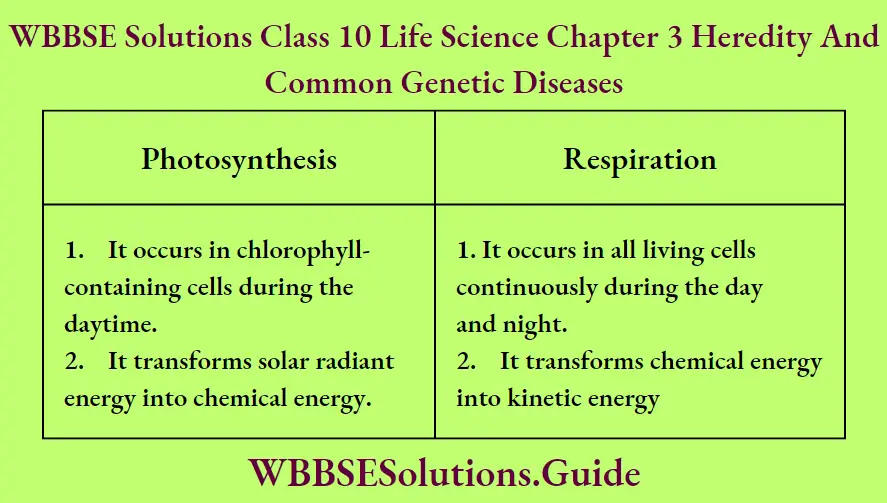
2. Respiration and Breathing:-
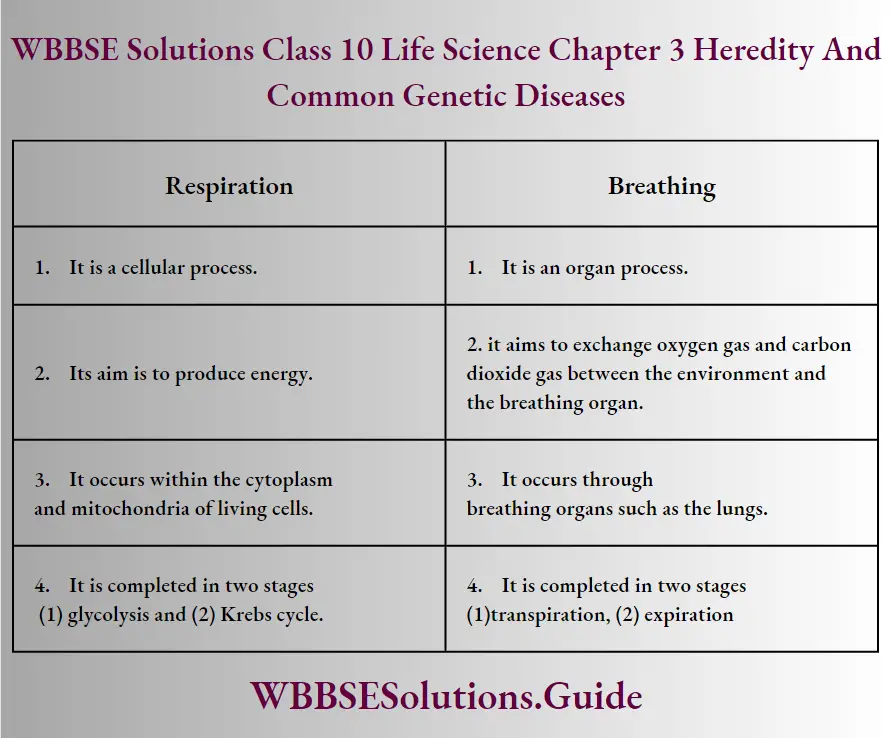
3. Aerobic Respiration and Anaerobic Respiration:-
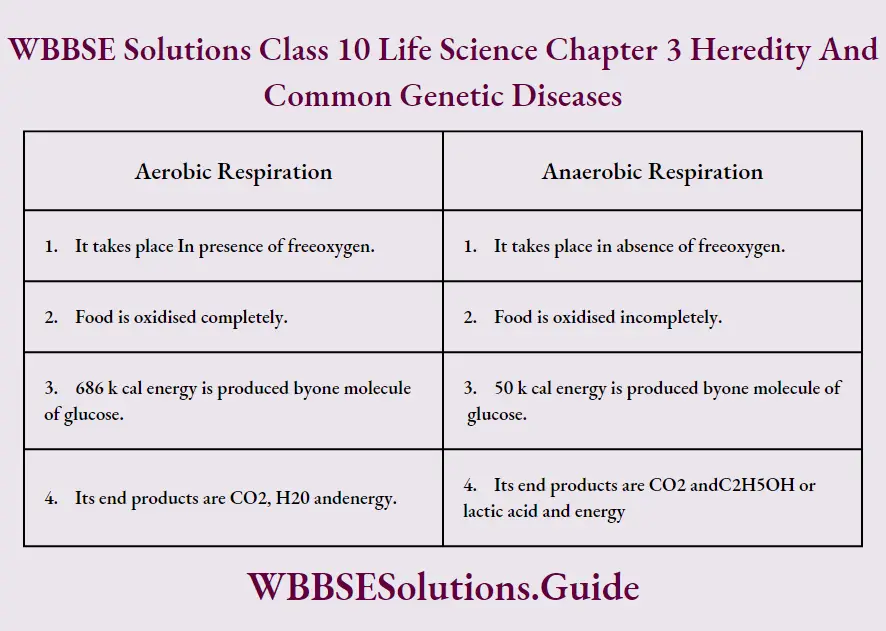
4. Respiration and Combustion:—
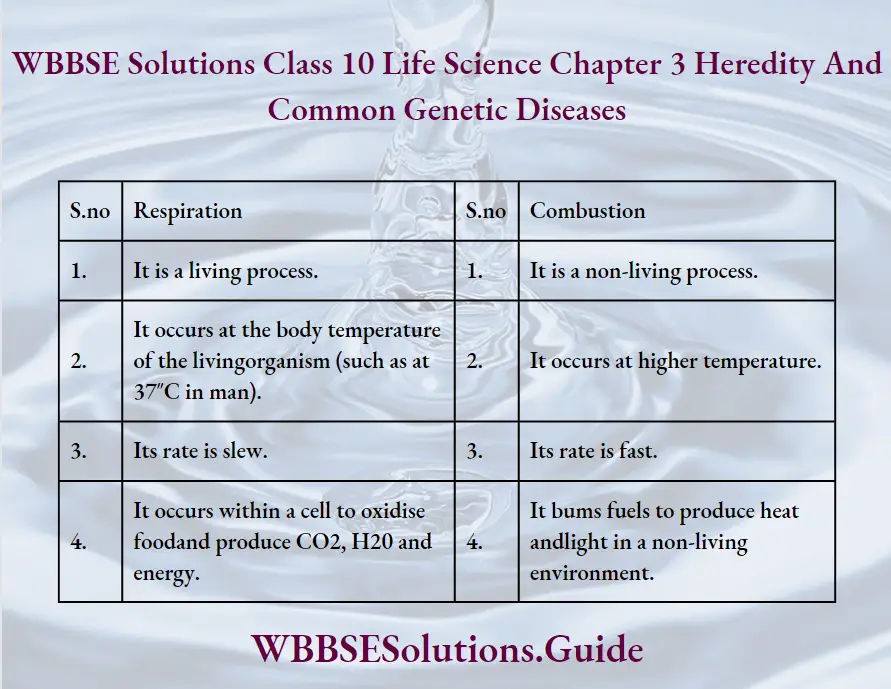
5. Anaerobic Respiration and Alcoholic Fermentation :—
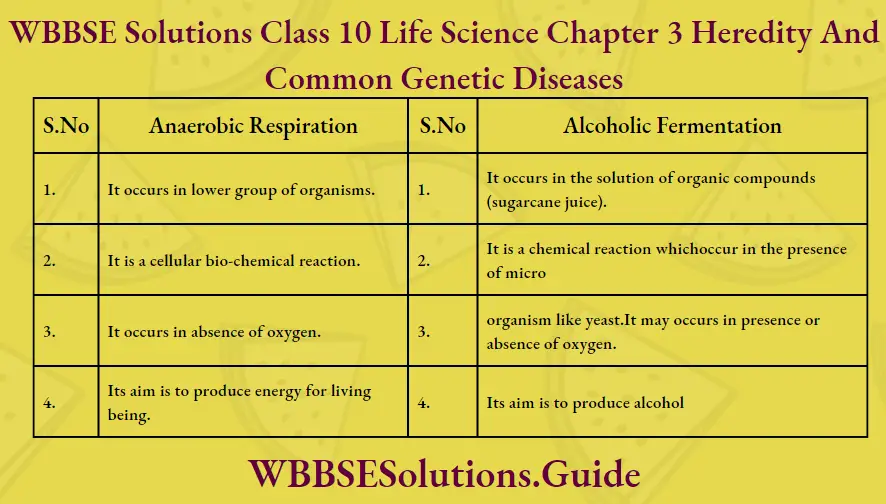
6. Aerobic Respiration and Combustion :-
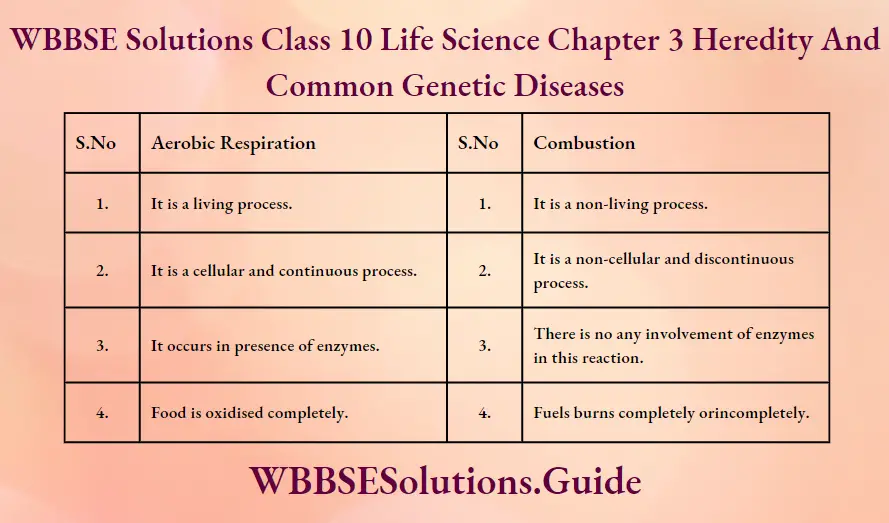
7. Anaerobic Respiration and Fermentation:-
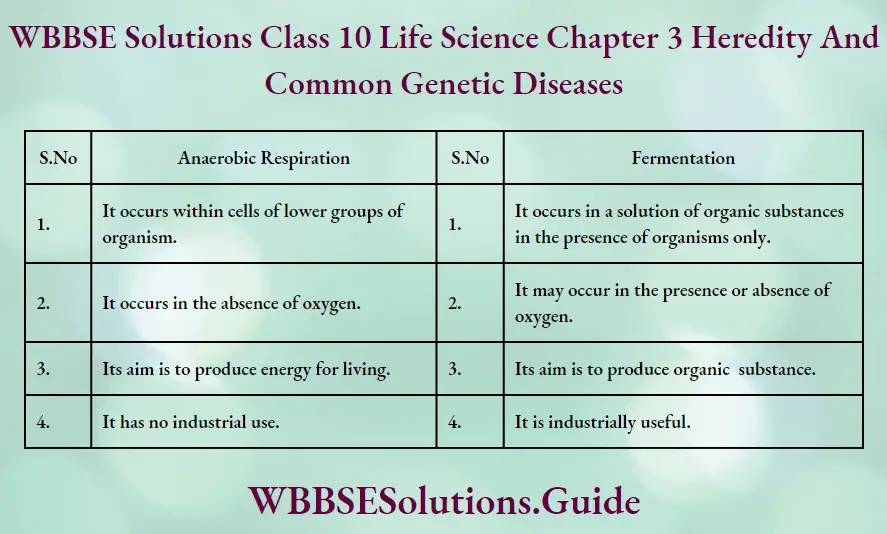
8. Aerobic Respiration and Fermentation :—
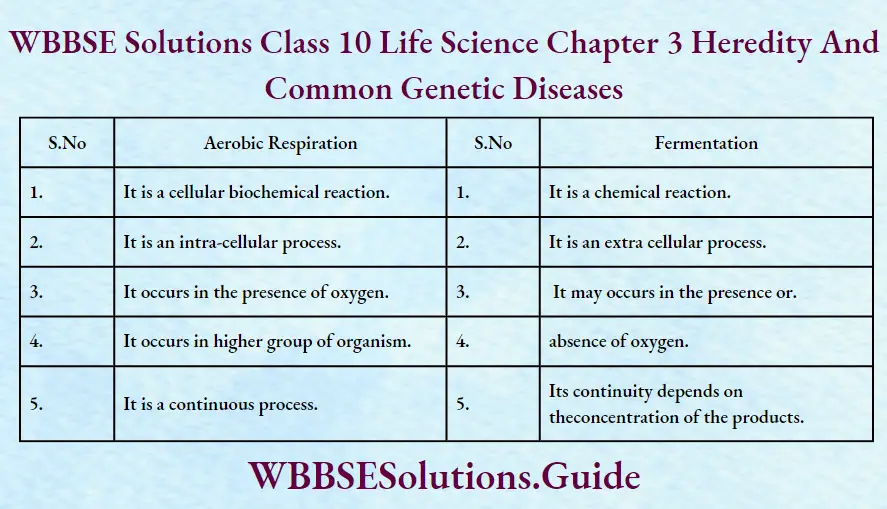
9. Plant Respiration and Animal Respiration :—
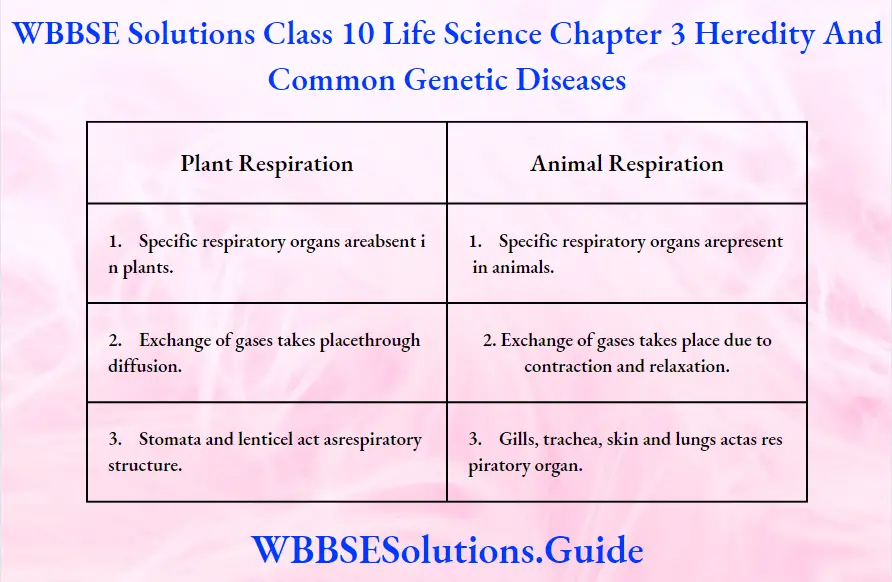
10. Plant Nutrition and Animal Nutrition :—
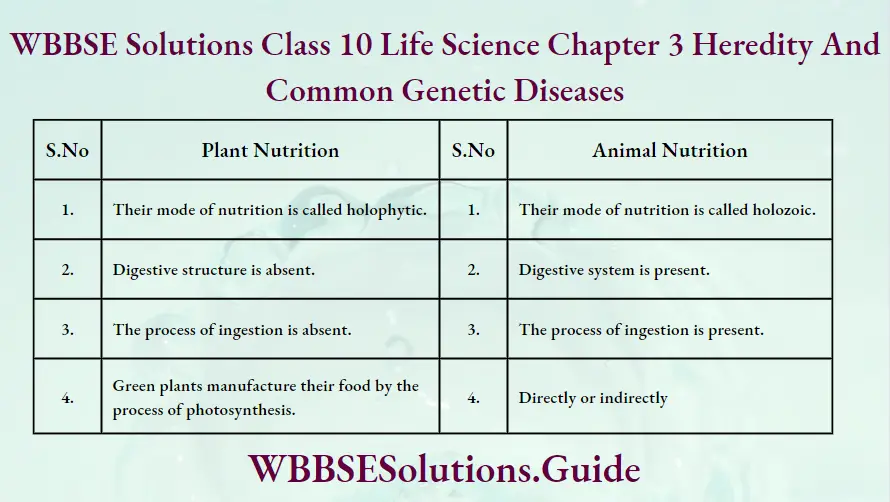
11. Fat and Protein :—
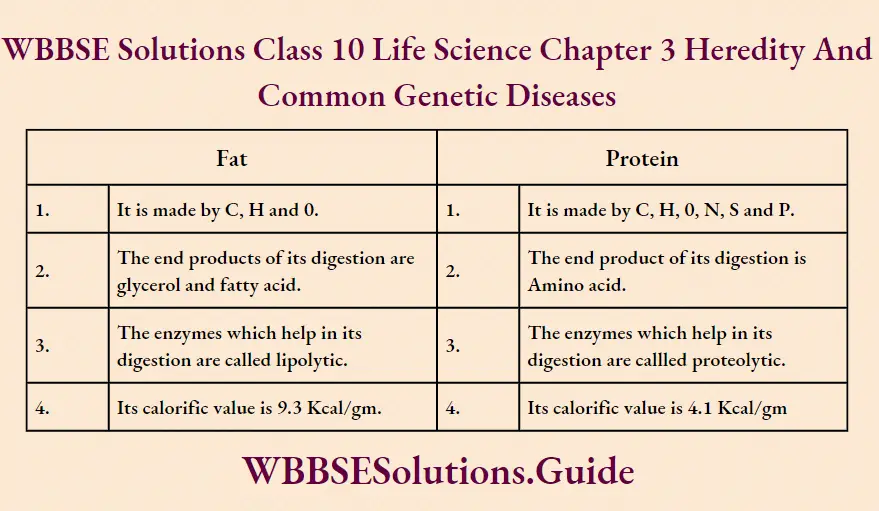
12. Autophytes and Heterophytes :—
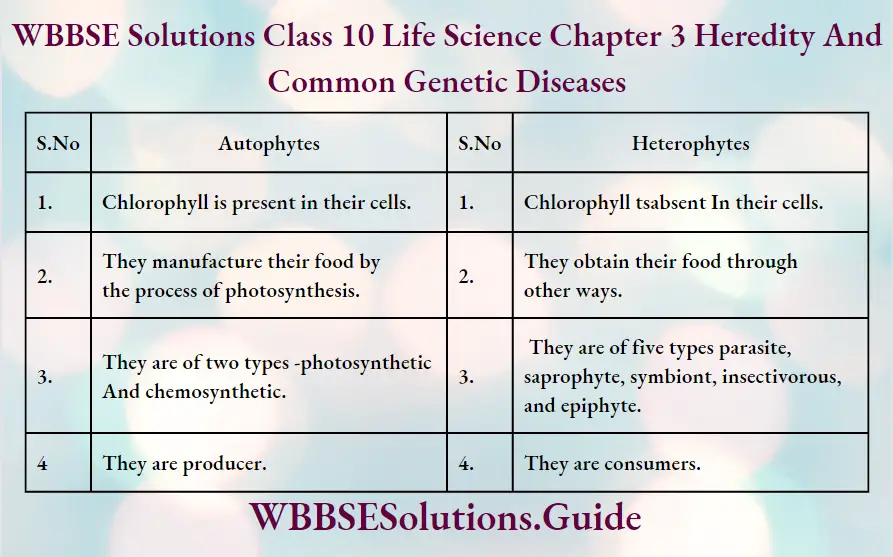
13. Parasite and Saprophyte :—
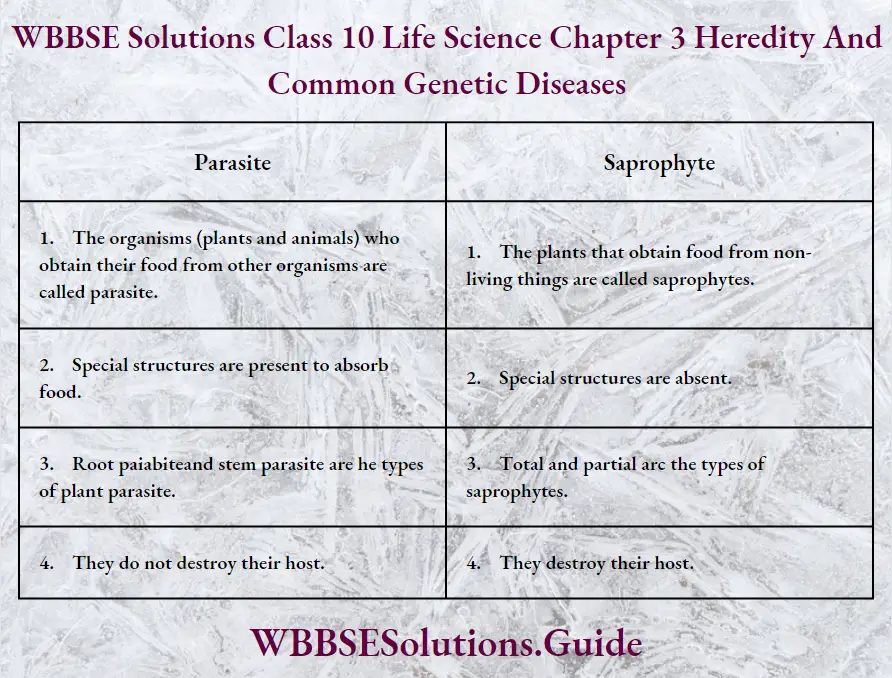
14. Parasite and Saprotroph :—
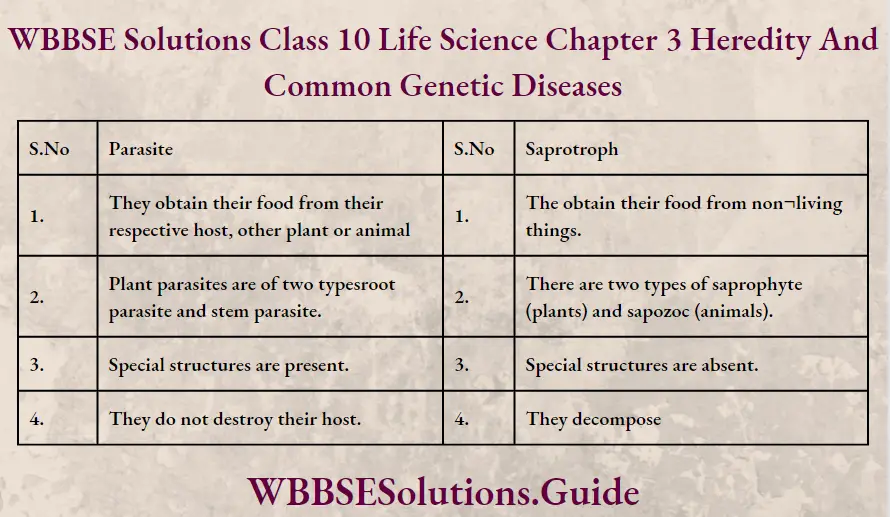
15. Parasite and Heterotroph :—
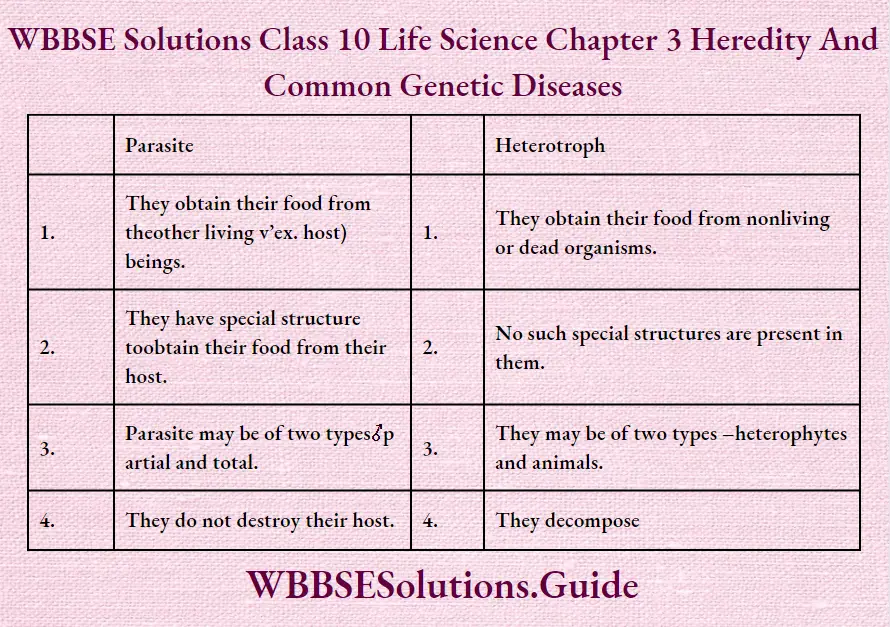
16. Anabolism and Catabolism :—
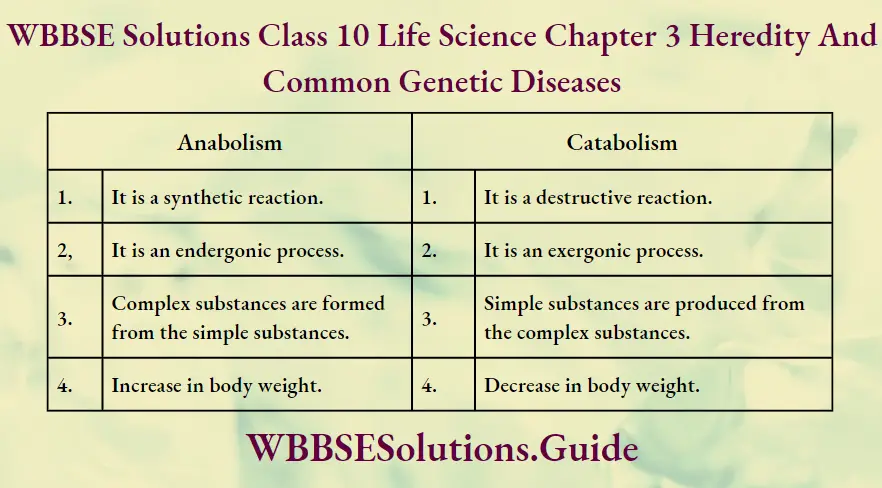
17. Digestion and Assimilation :—
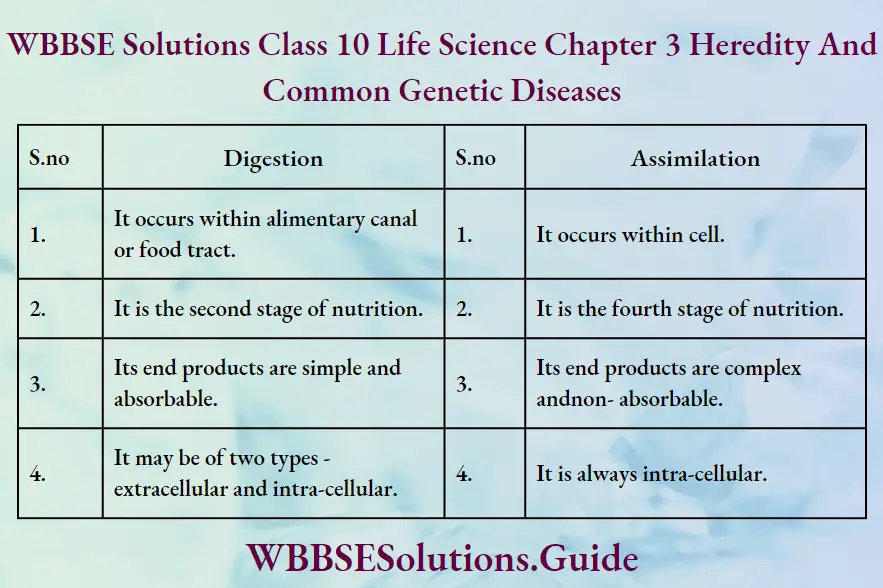
18. Autotrophic and Heterotrophic:-
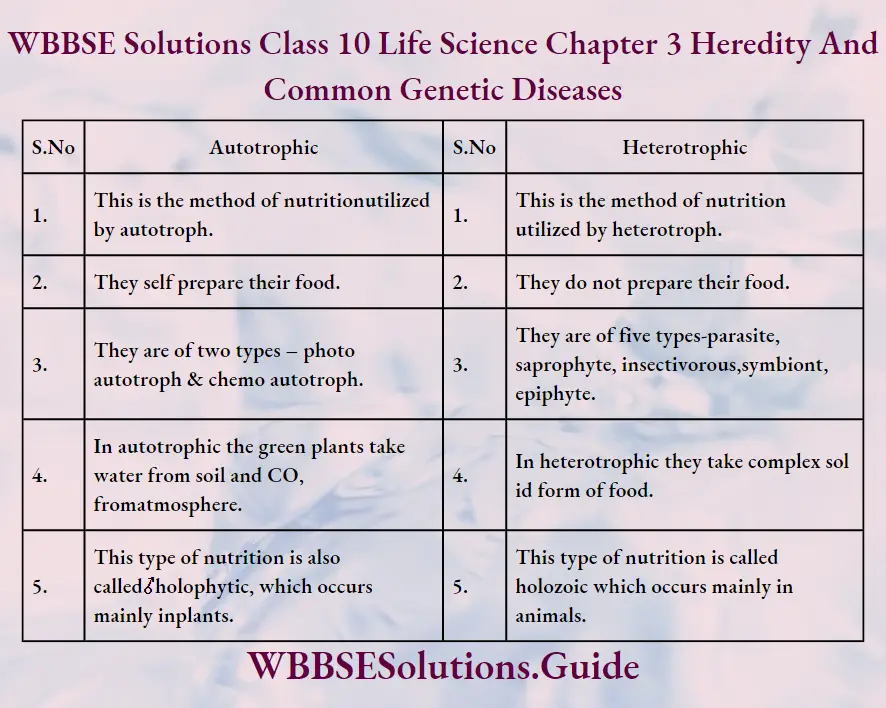
19. Autotroph and Heterotroph:—
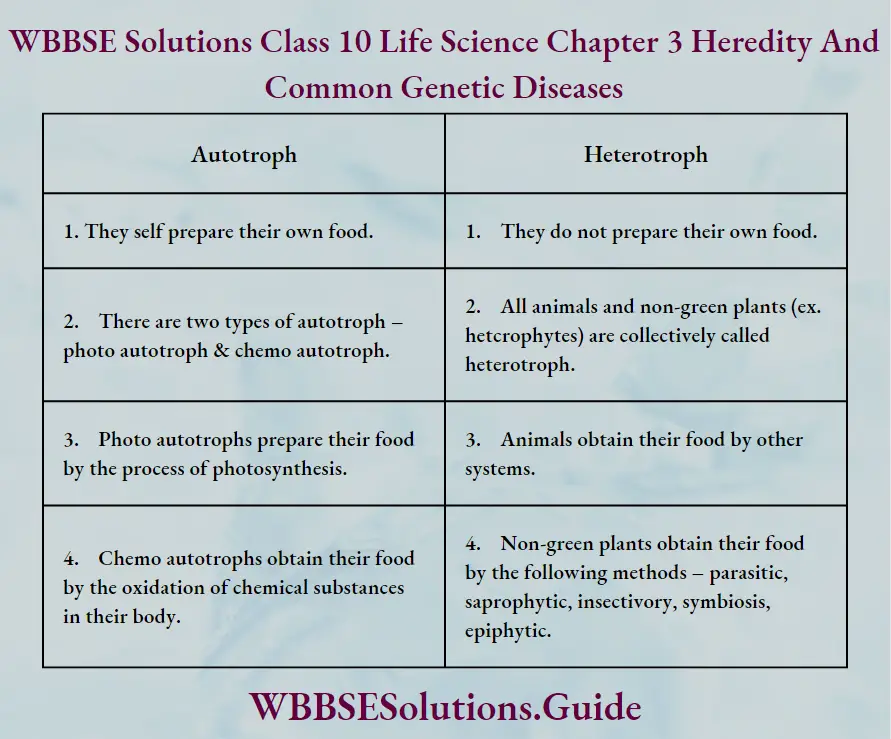
20. Vitamin and Enzymes:—
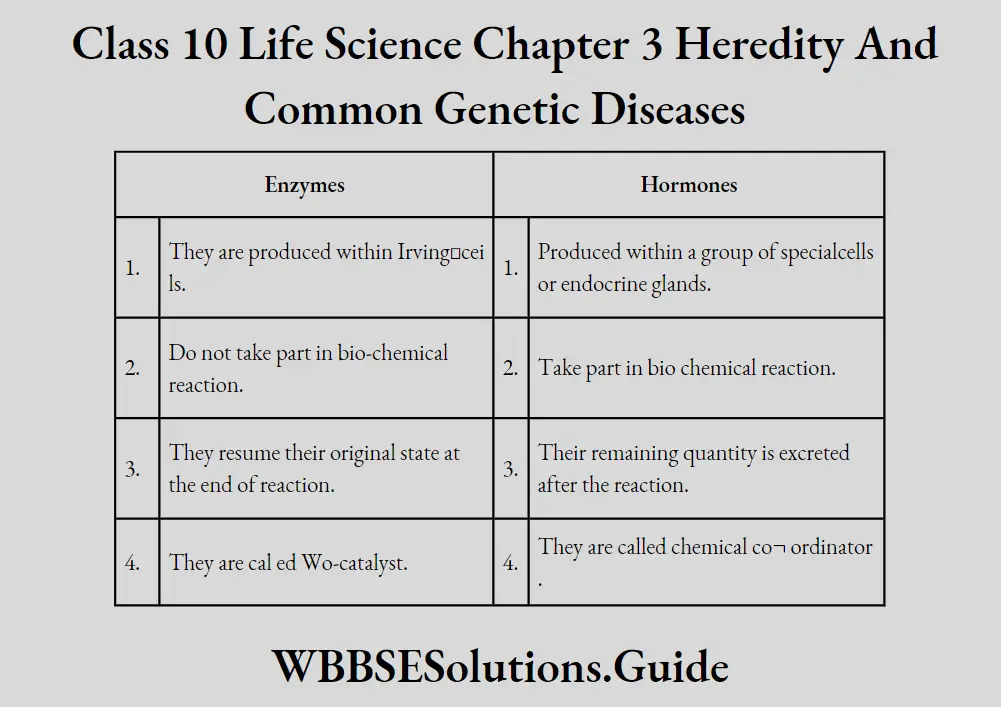
21. Enzymes and Hormones :—
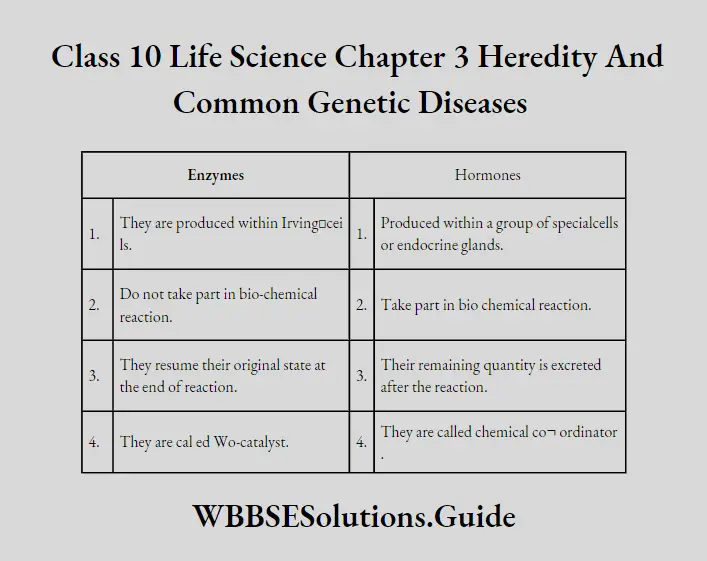
22. Essential element and Trace element :-
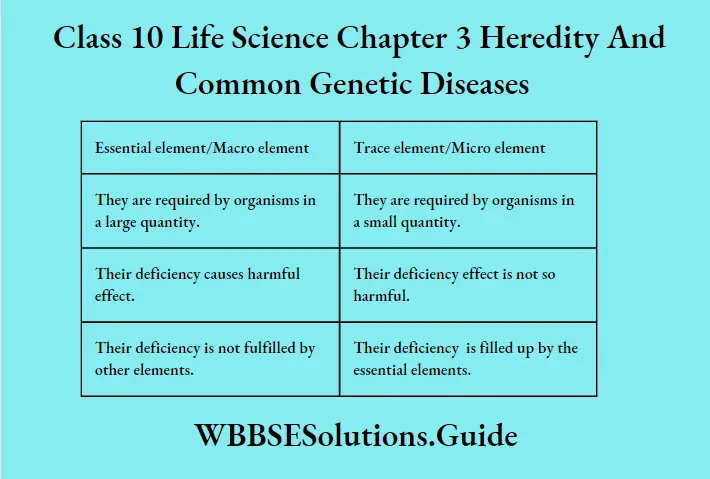
23. Vein and Artery :—
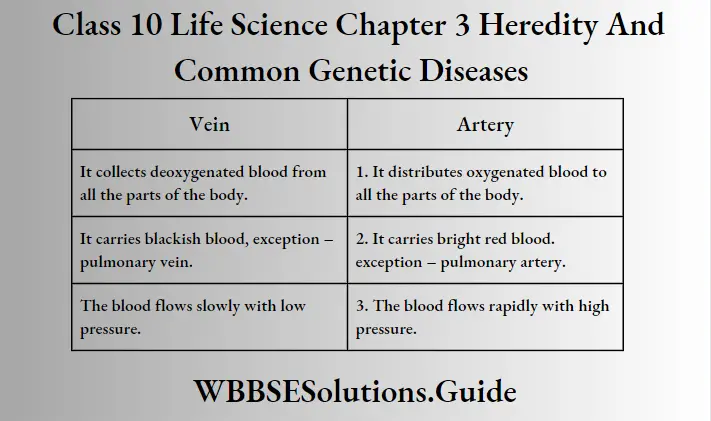
24. Haemoglobin and Haemocyanin :—
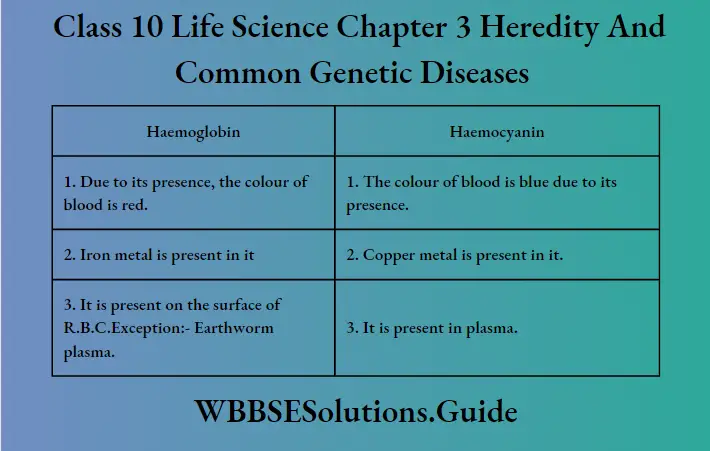
25. Structural Difference between Vein and Artery :-
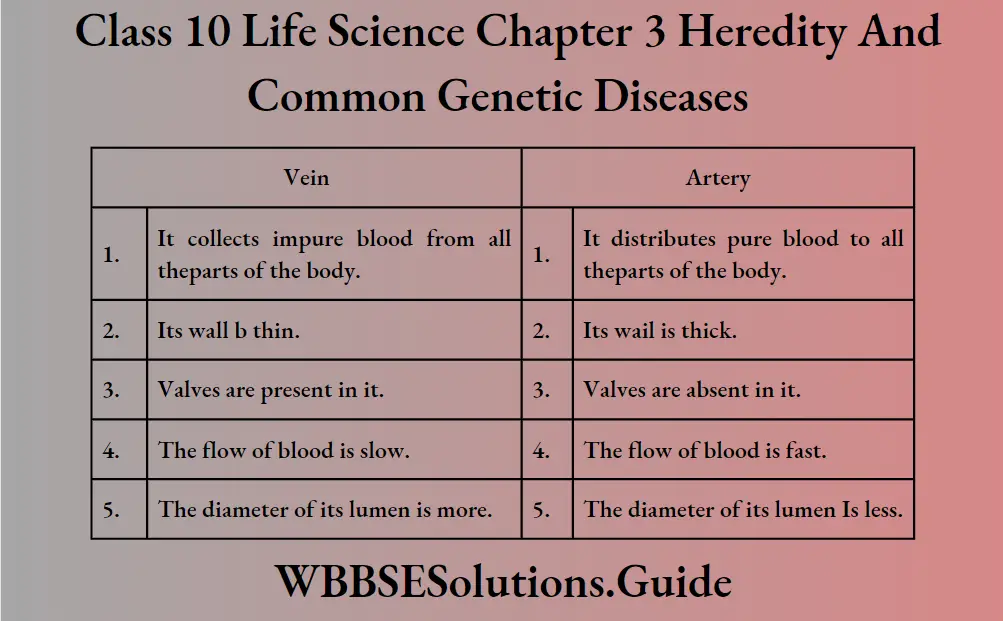
26. Functional difference between Vein and Artery :—
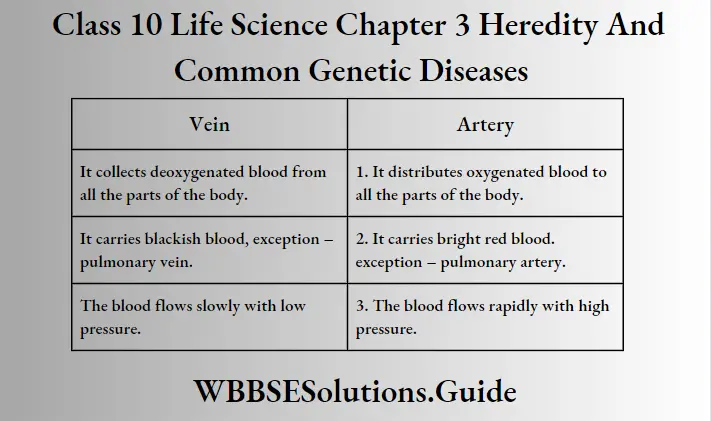
27.Lymphocyte and Thrombocyte :-
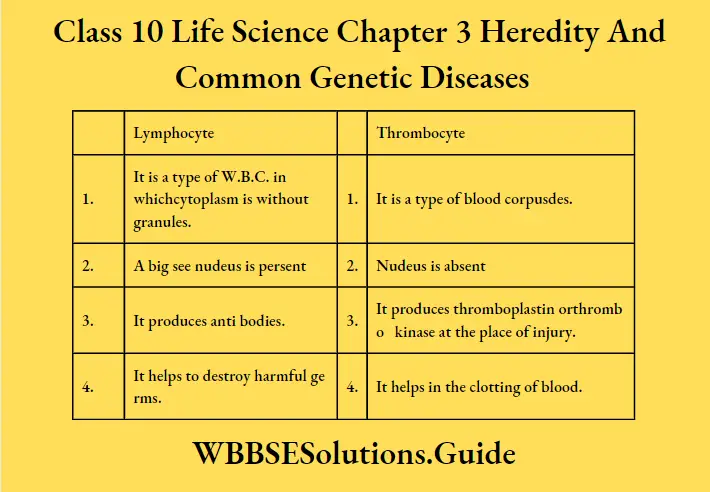
28. Open Circulation and Close Circulation:—
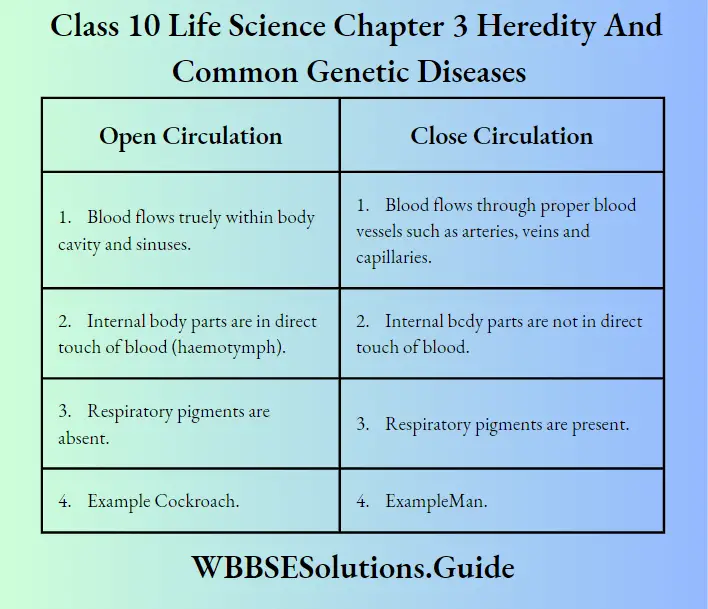
29. Erythrocyte and Leucocyte :—
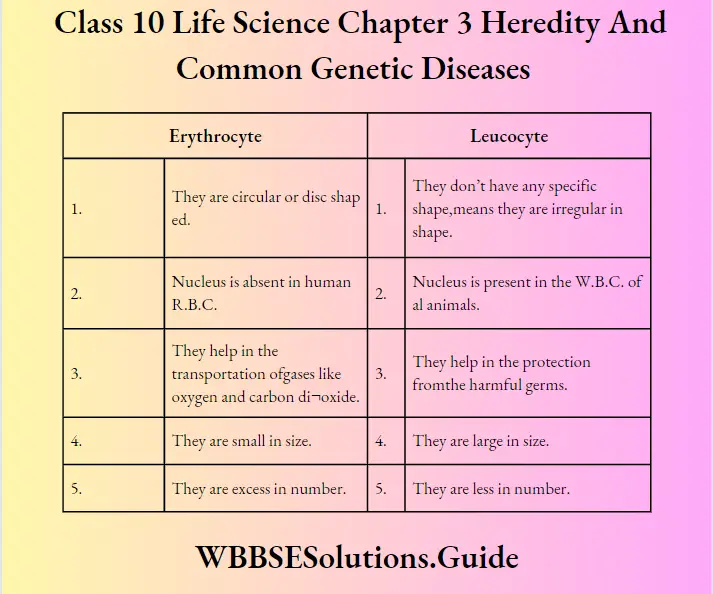
30. Erthryocyte in man and Leucocyte in man:-
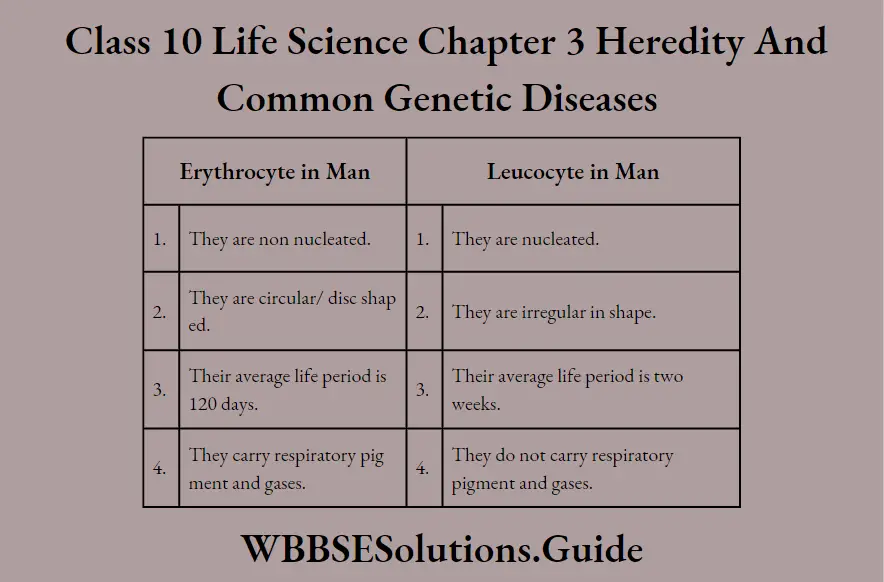
31. Blood and Lymph:—
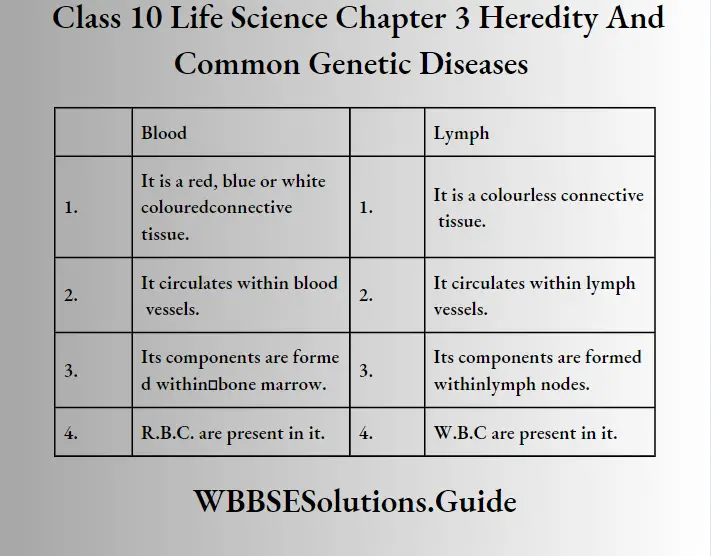
32. Mammalian R.B.C. and R.B.C of Other Vertebrates :-
